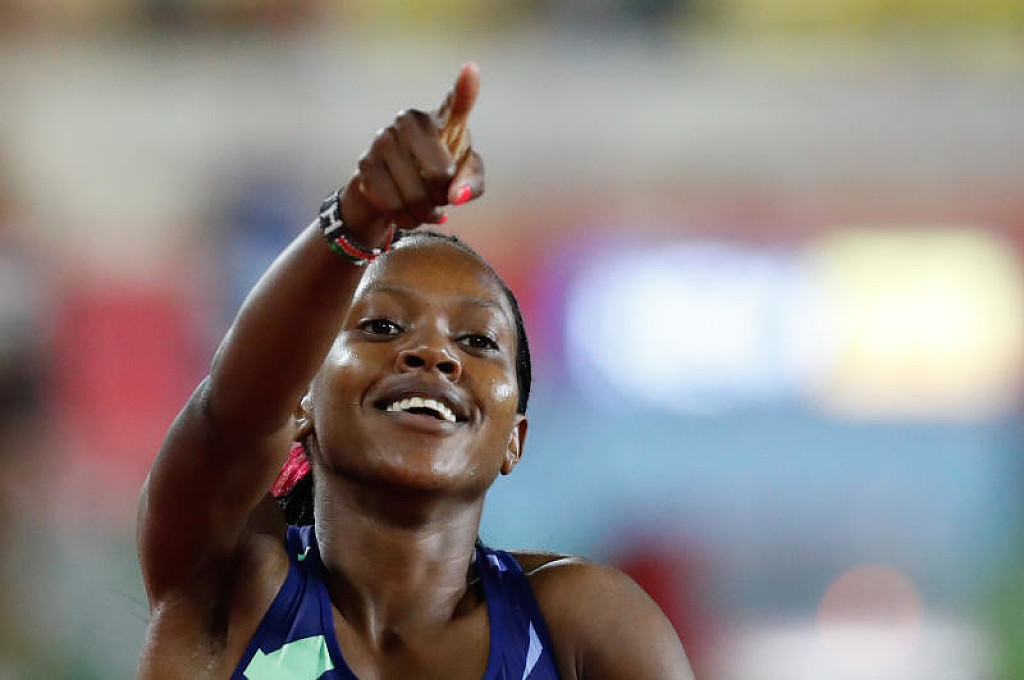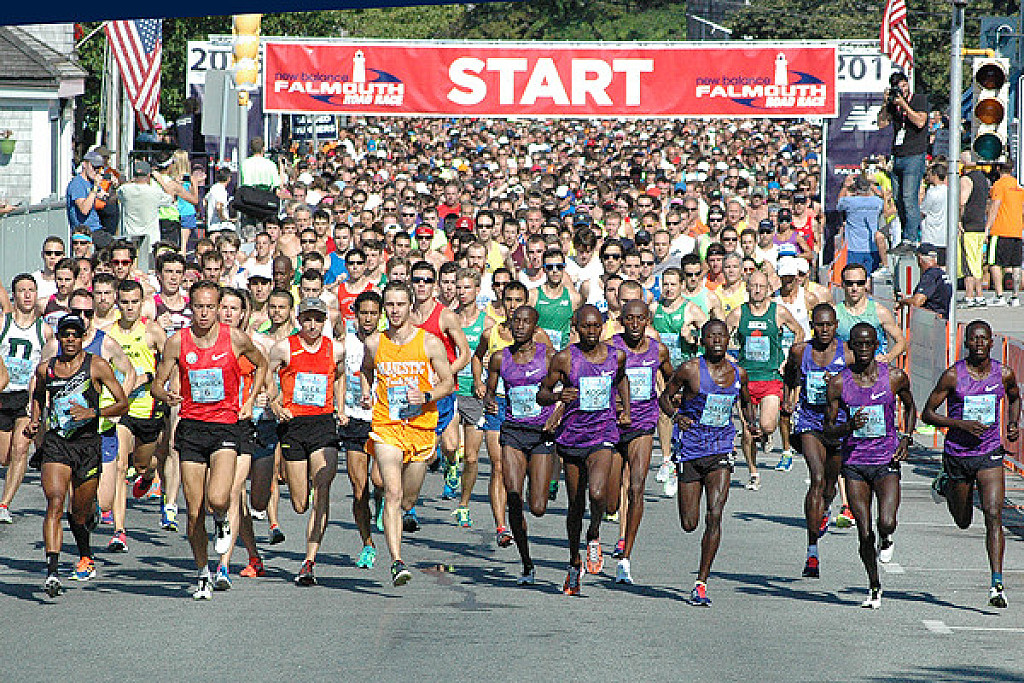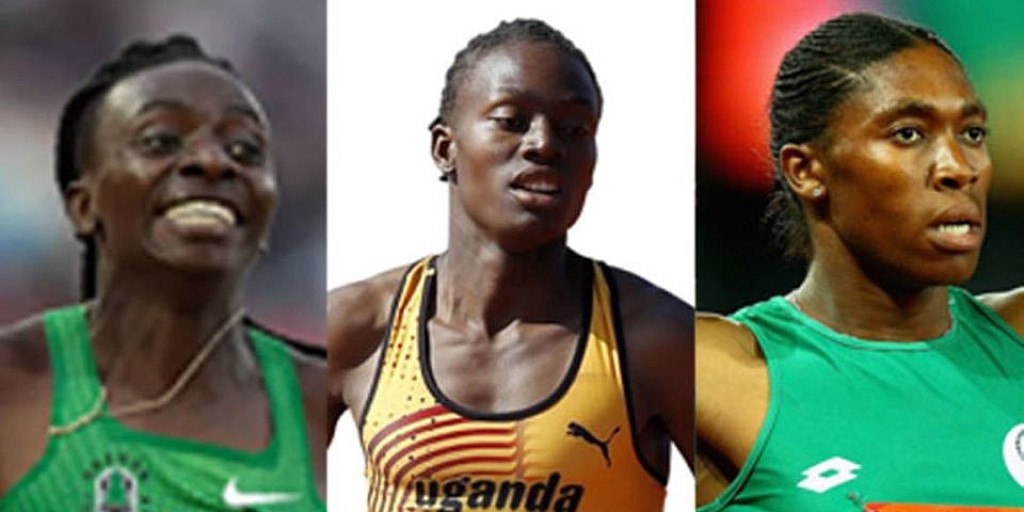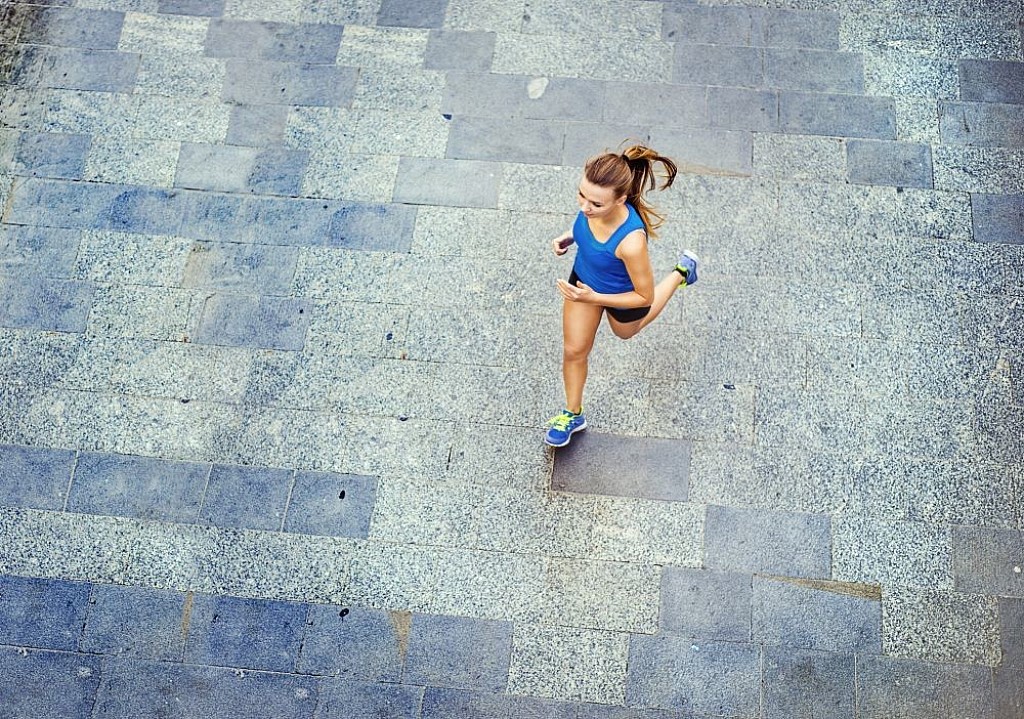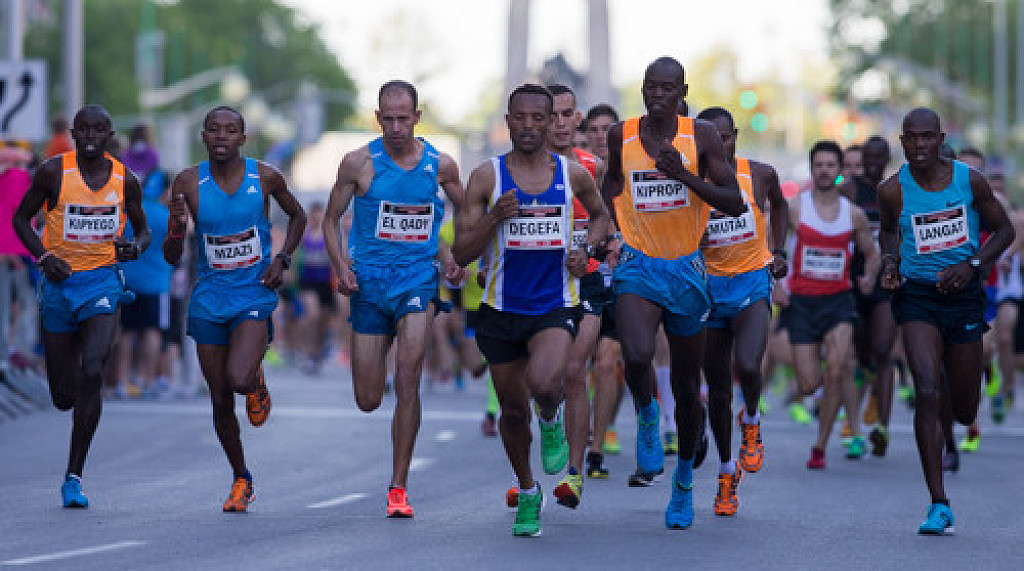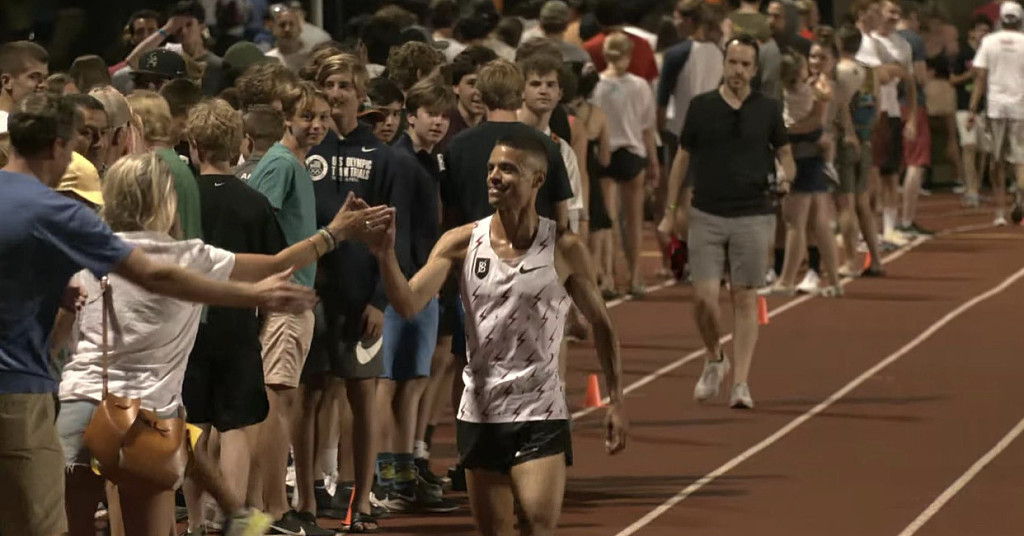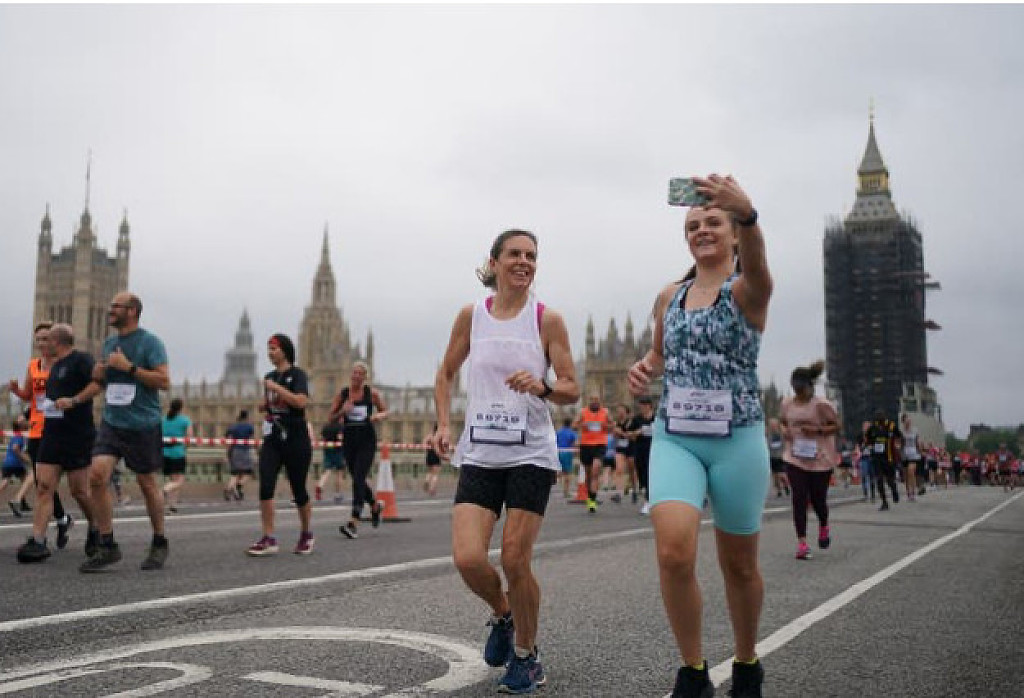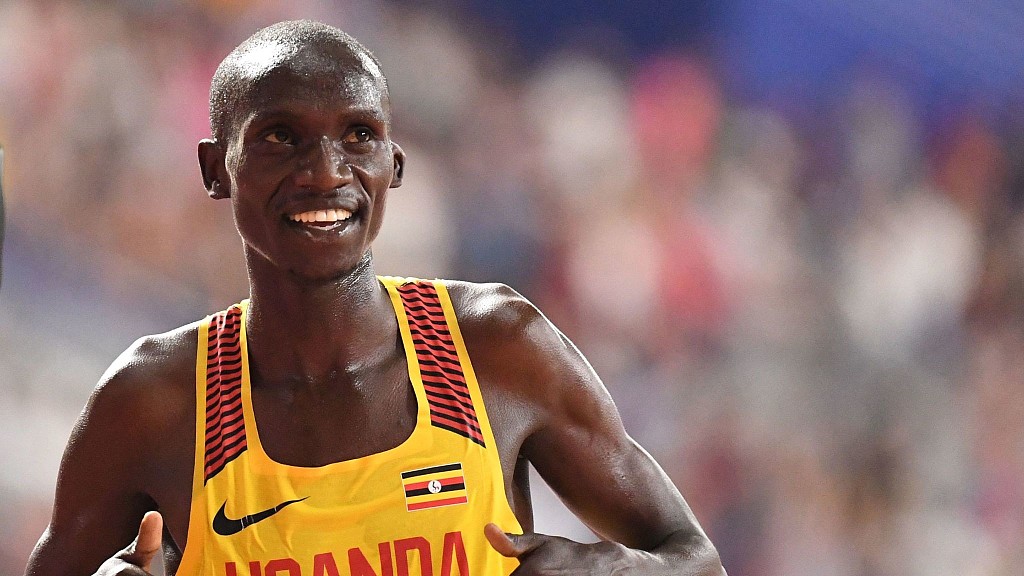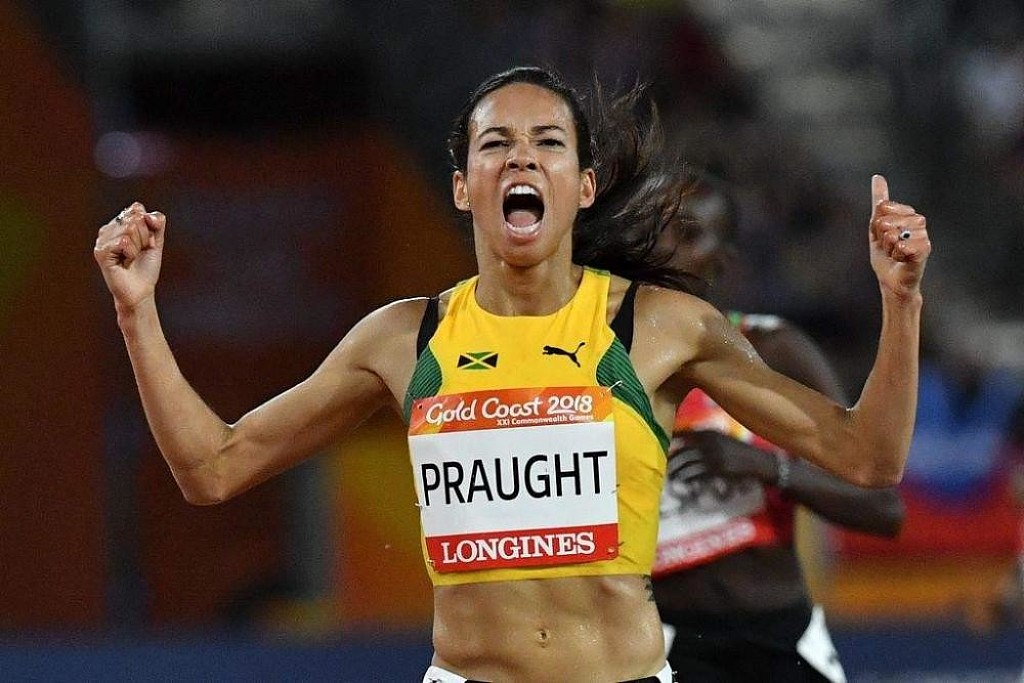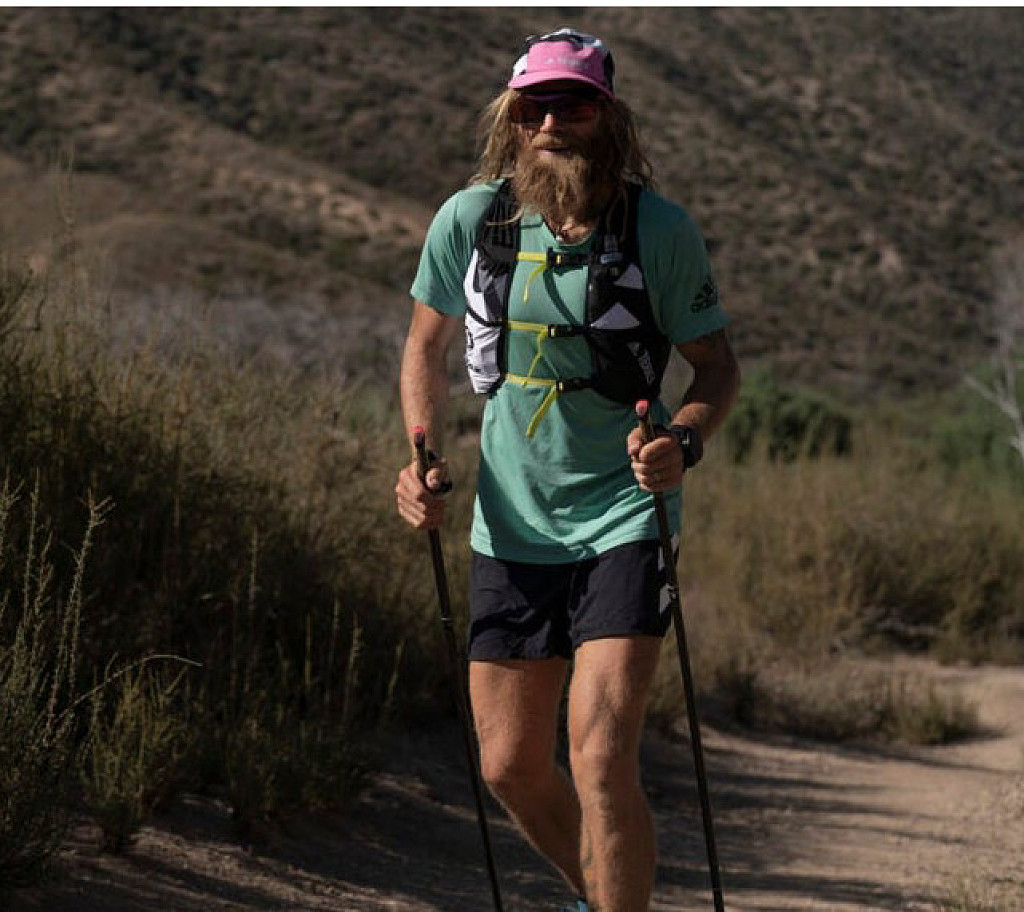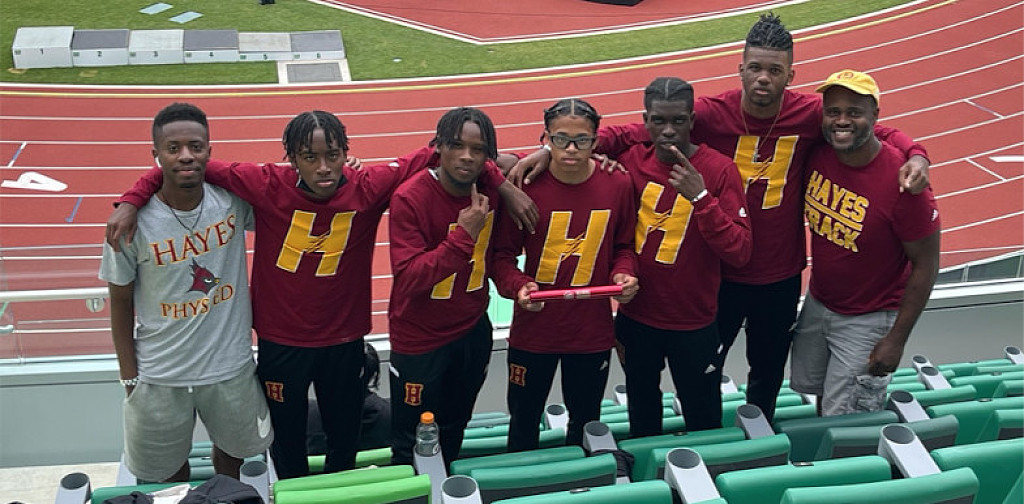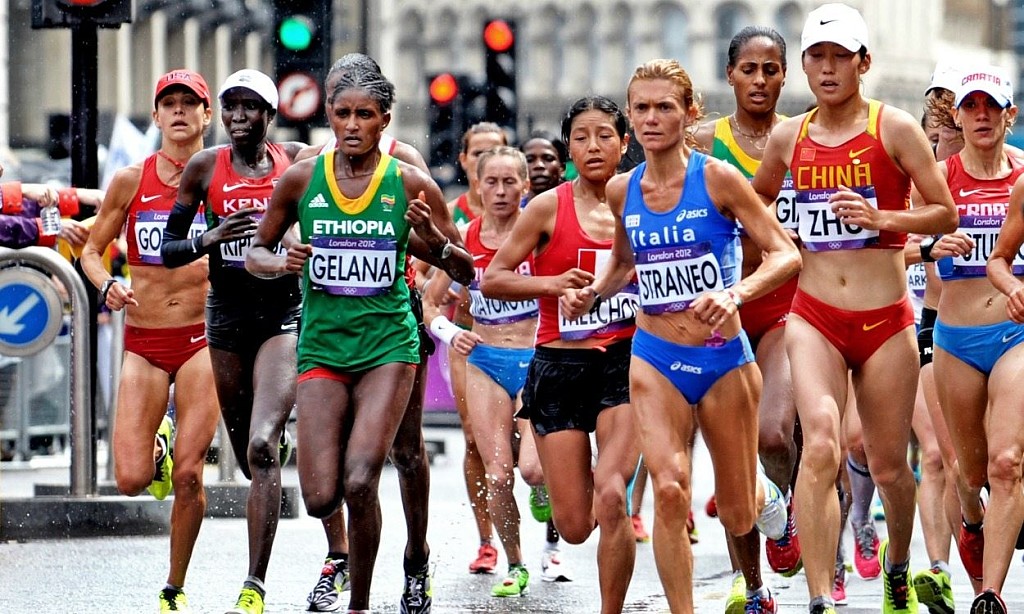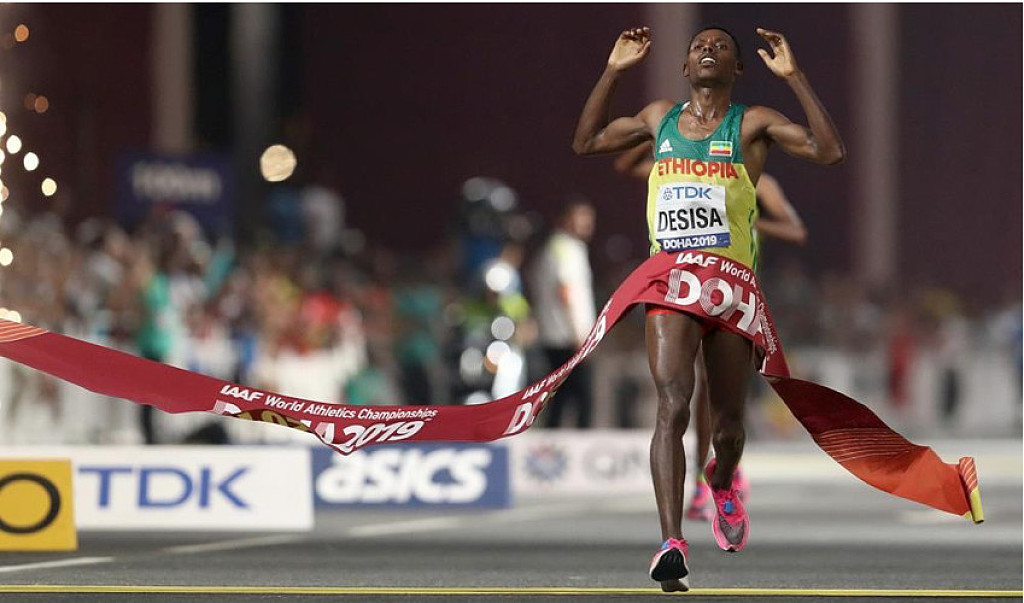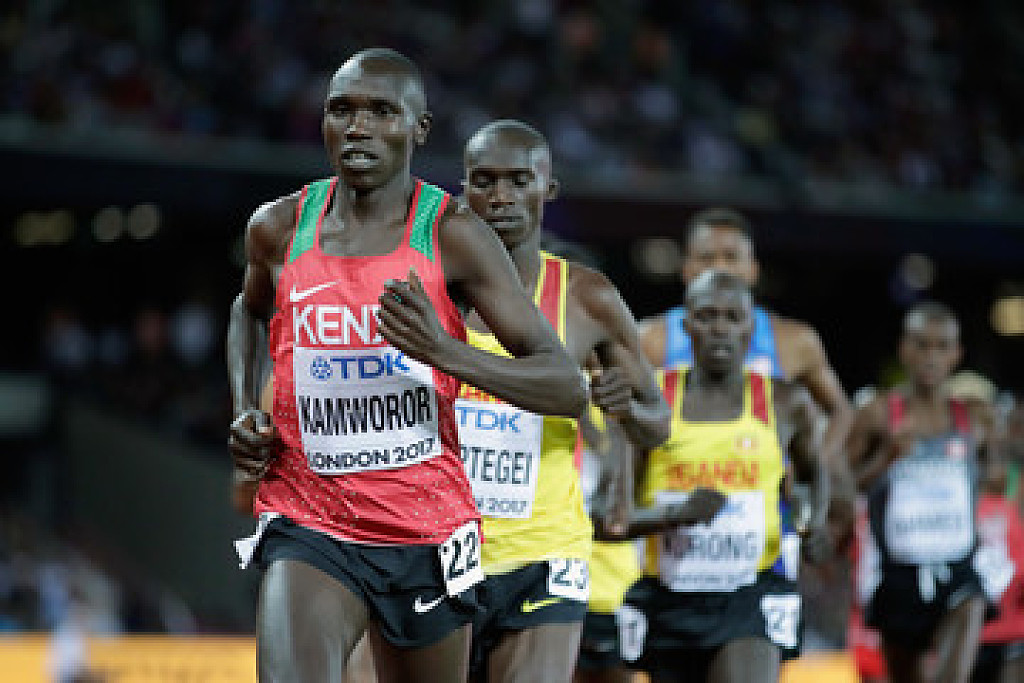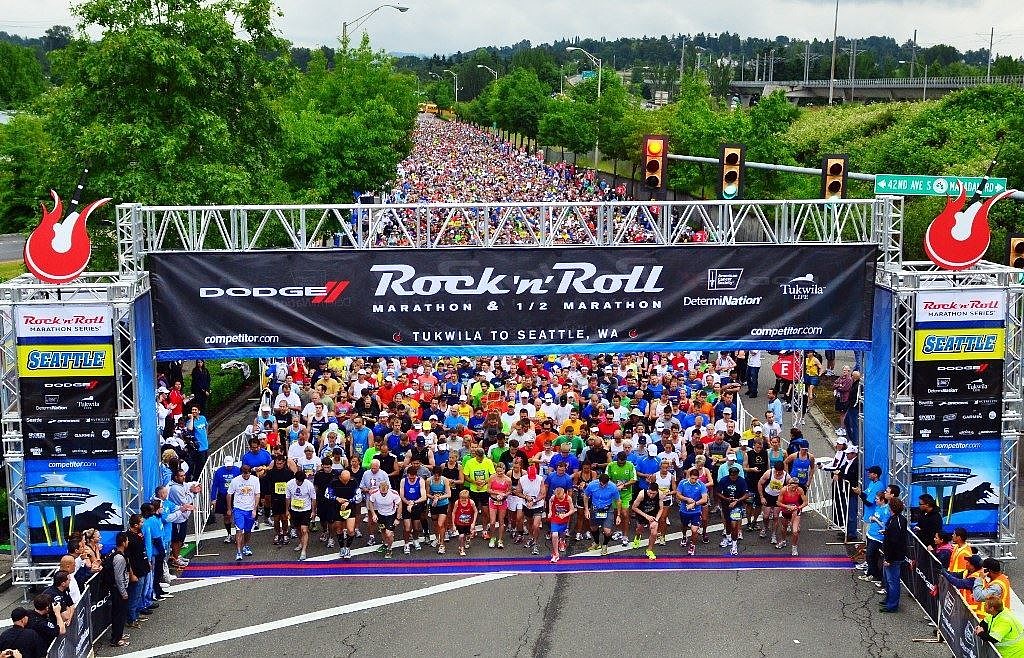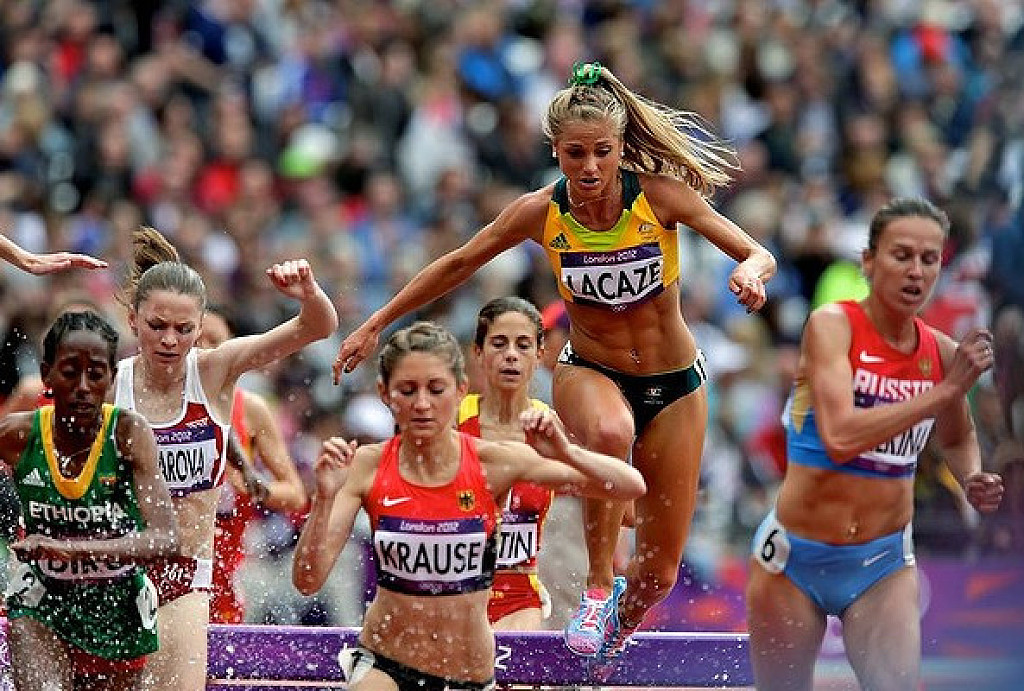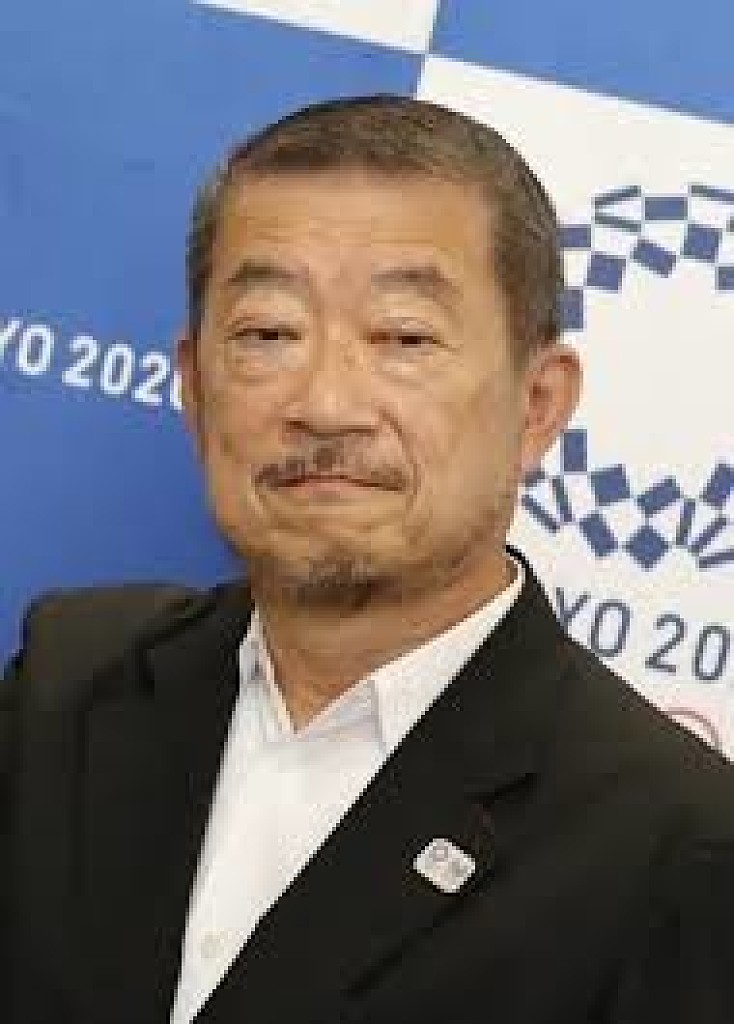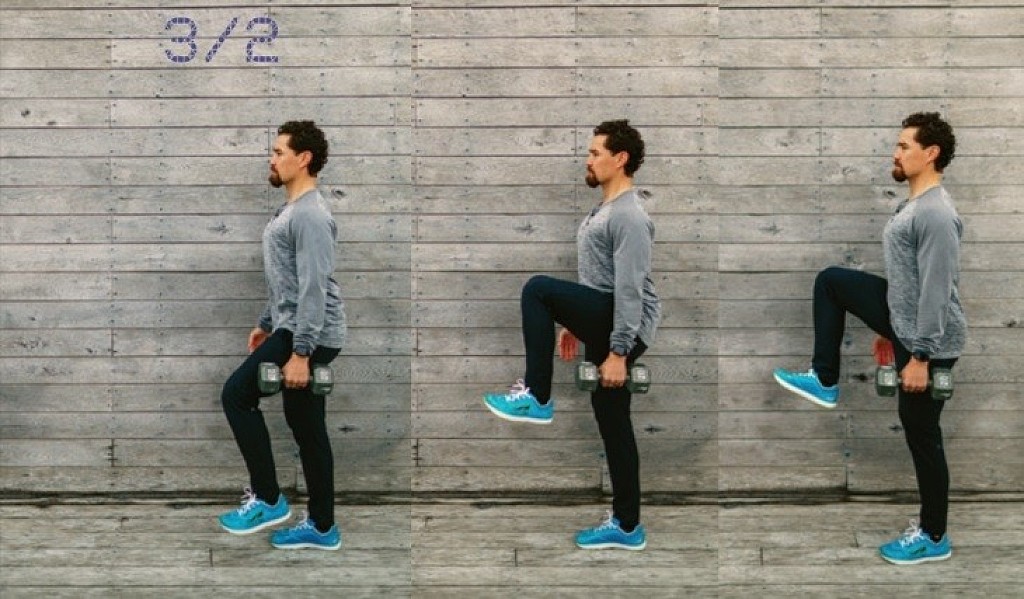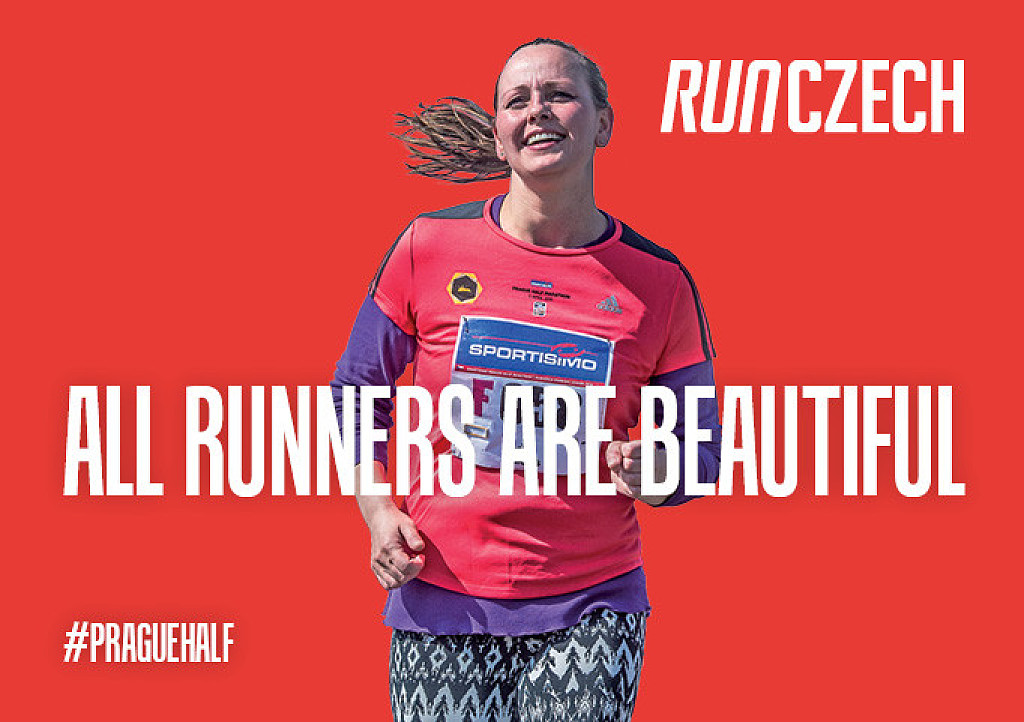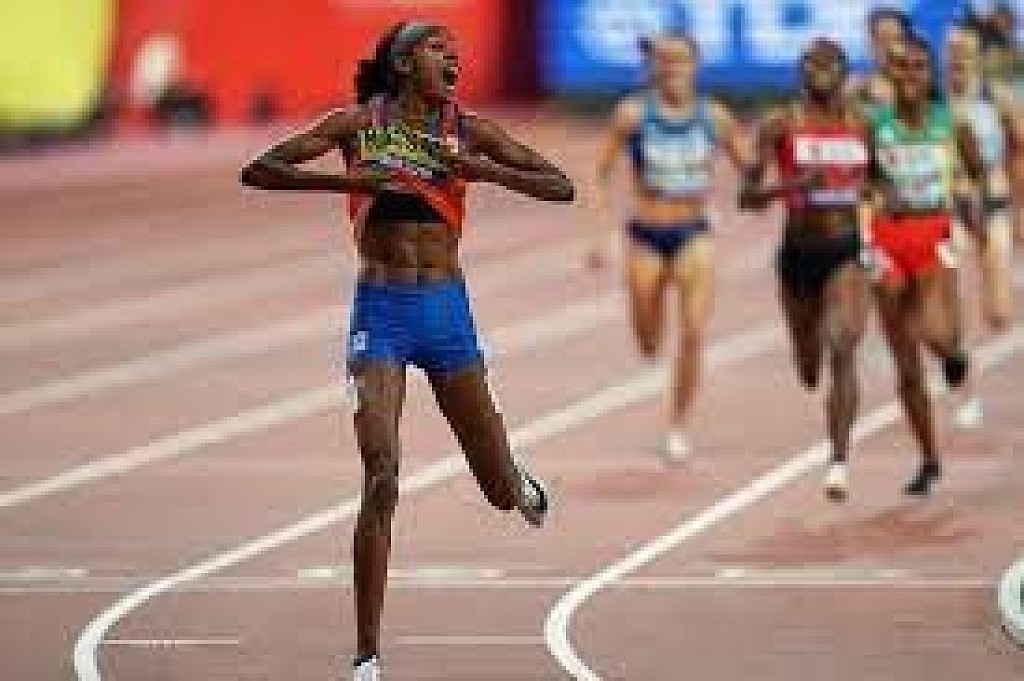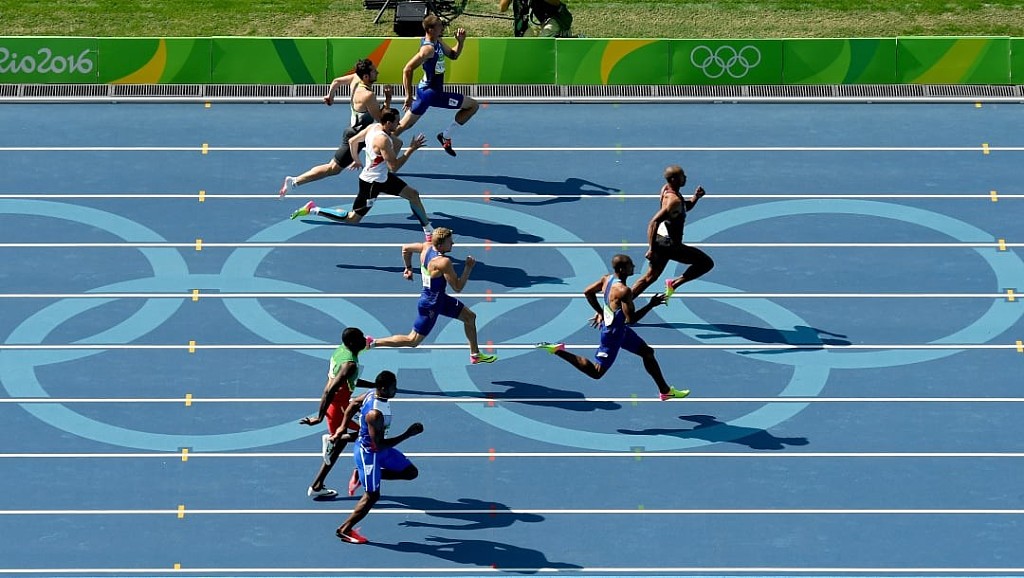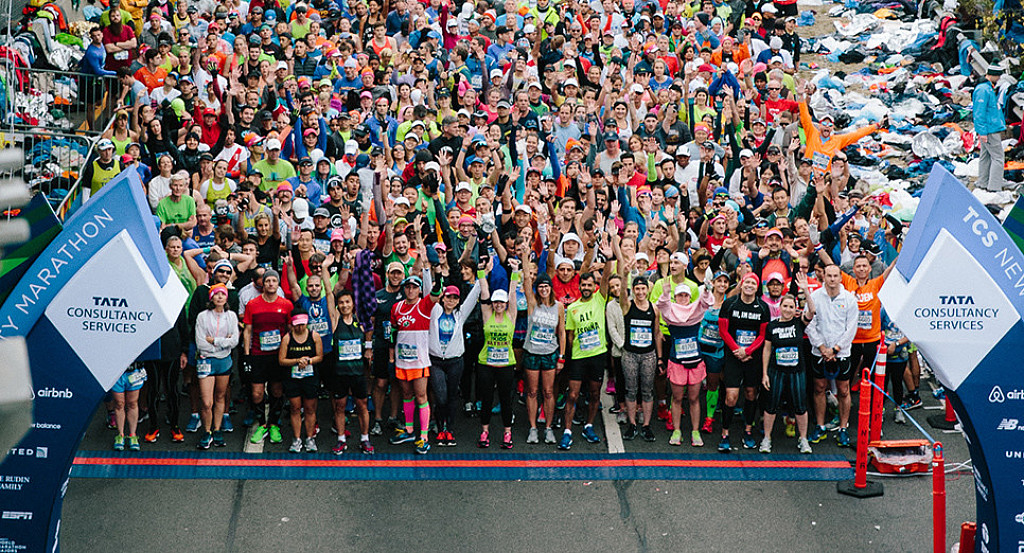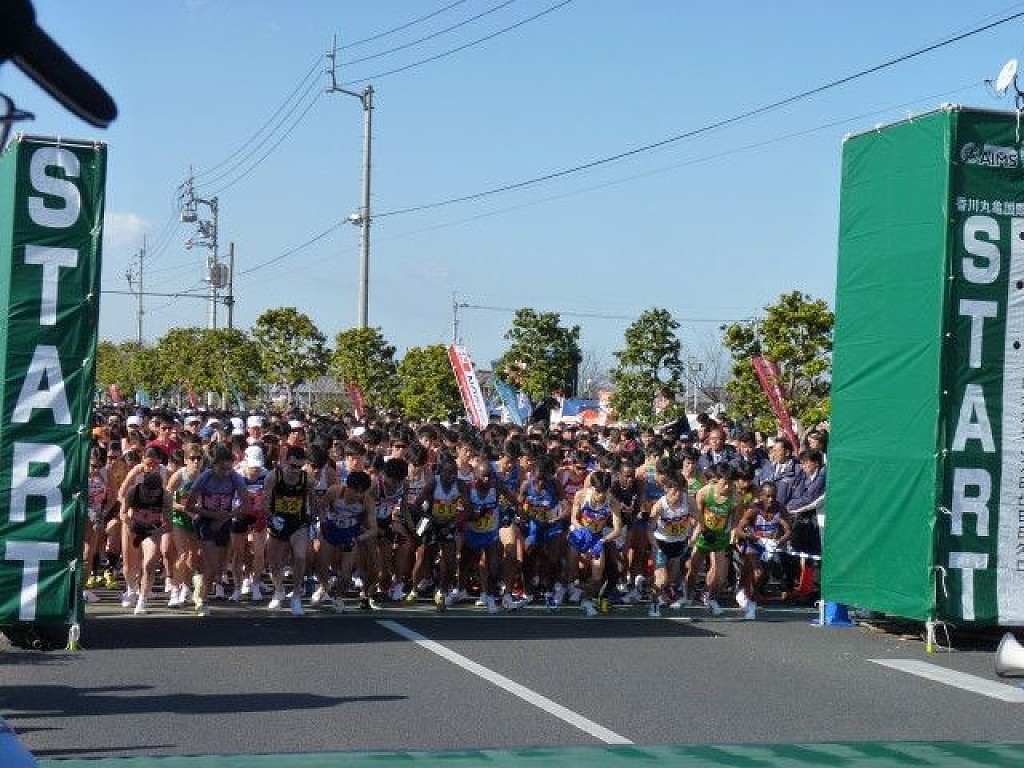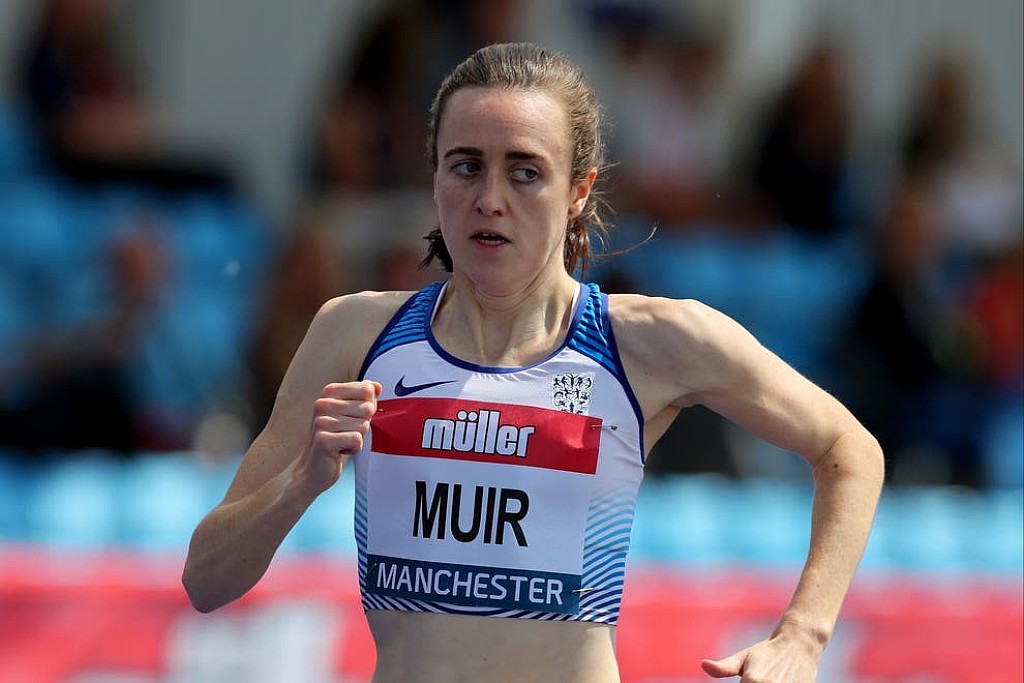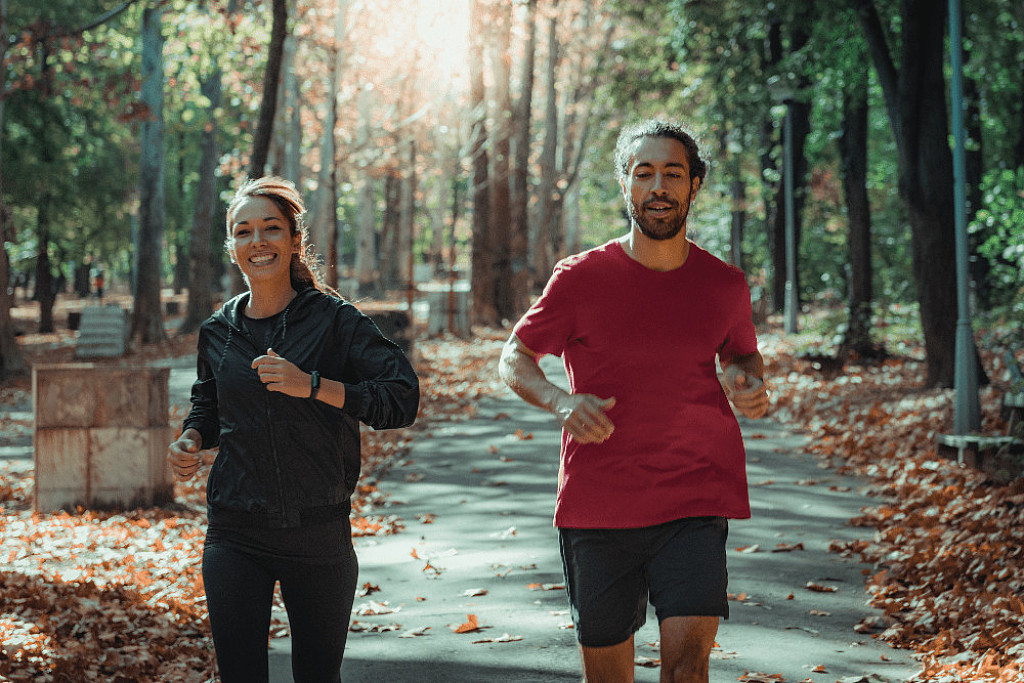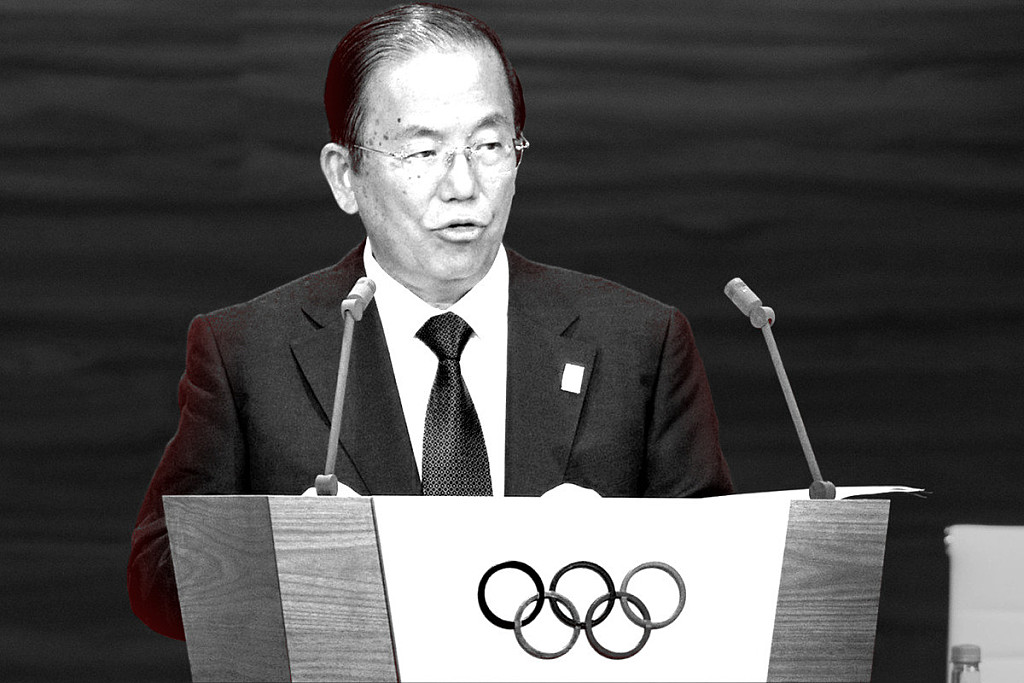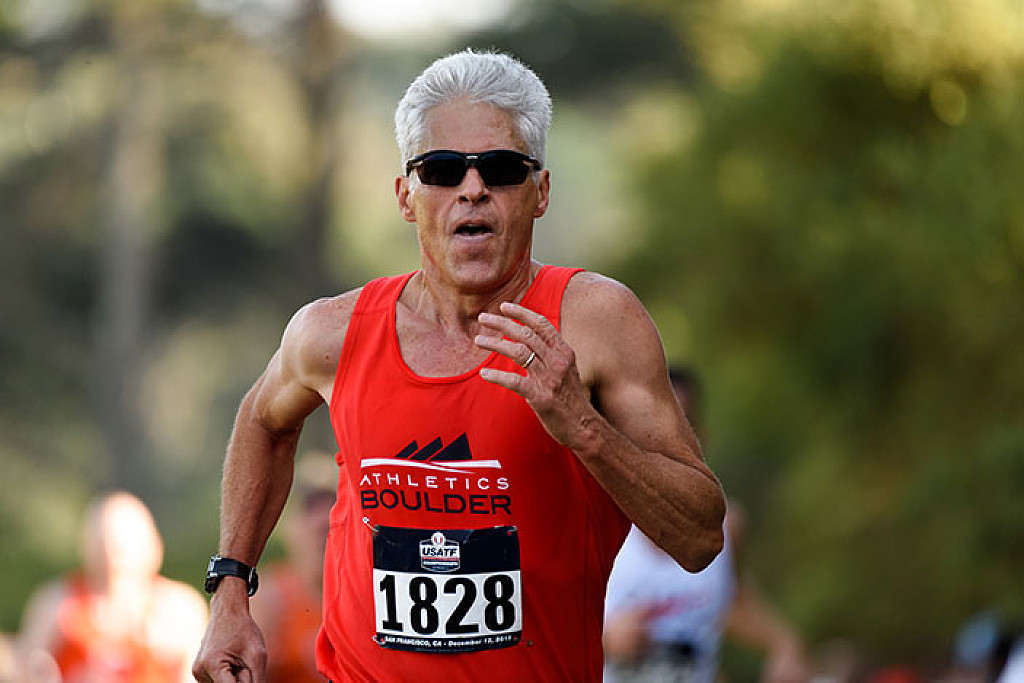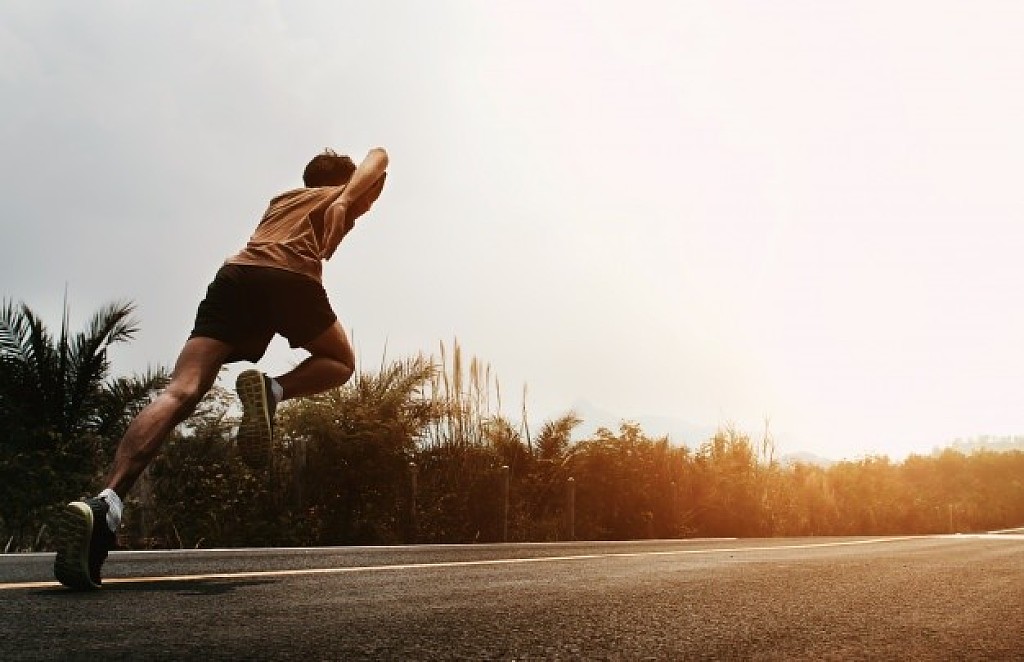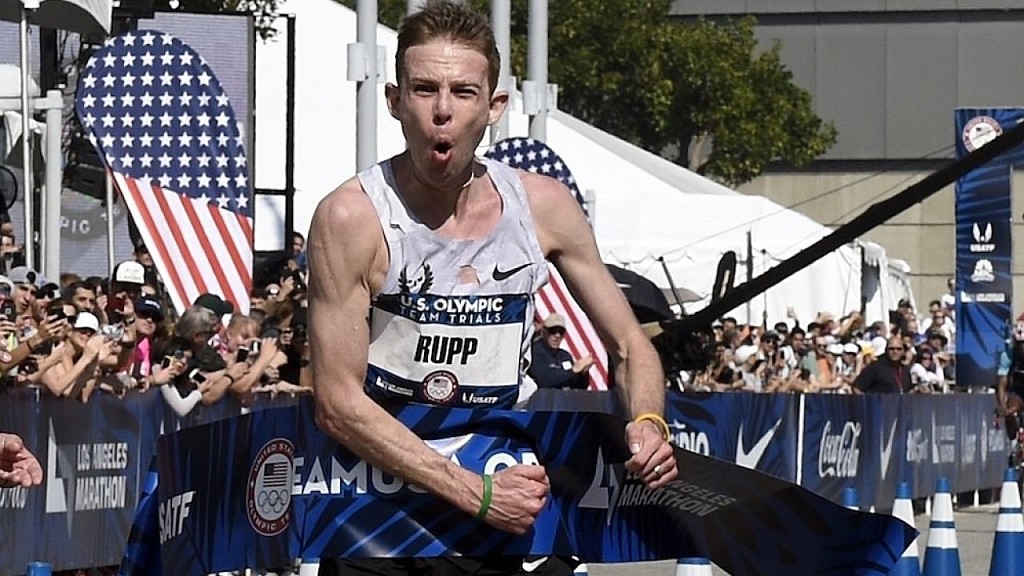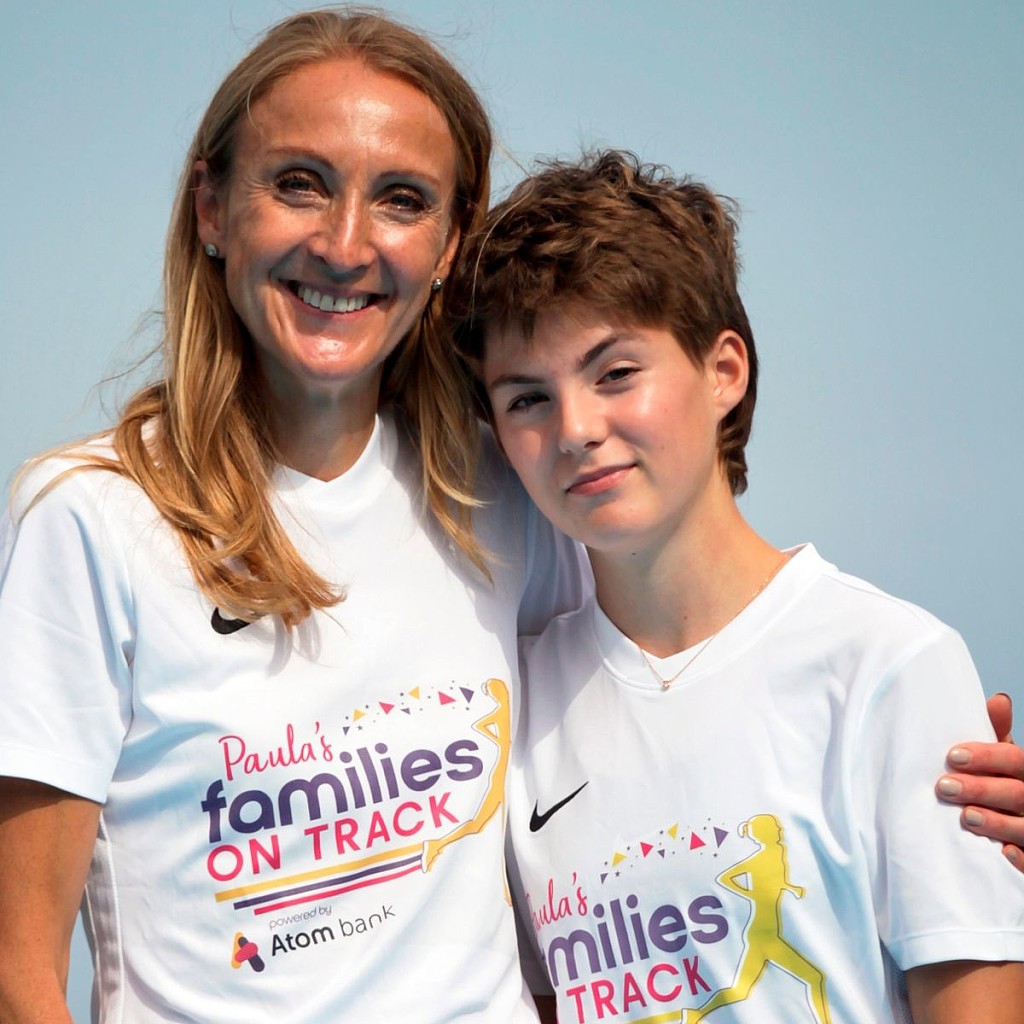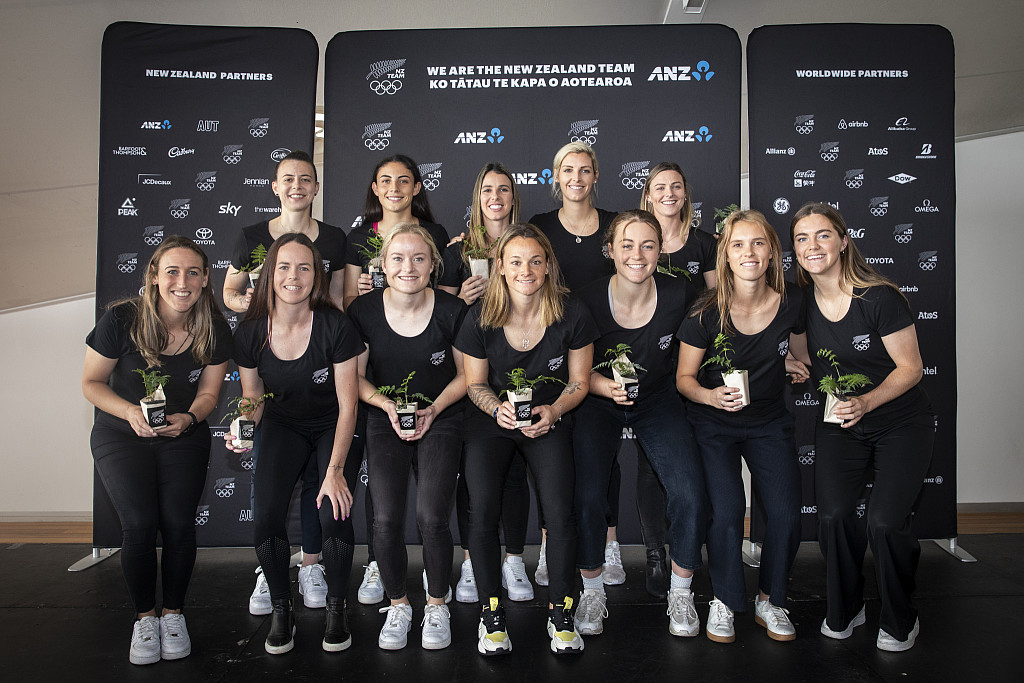Running News Daily
Running News Daily is edited by Bob Anderson. Send your news items to bob@mybestruns.com Advertising opportunities available. Train the Kenyan Way at KATA Kenya and Portugal owned and operated by Bob Anderson. Be sure to catch our movie A Long Run the movie KATA Running Camps and KATA Potato Farms - 31 now open in Kenya! https://kata.ke/
Index to Daily Posts · Sign Up For Updates · Run The World Feed
Kenyan Faith Chepng’etich ready for Sifa Hassan duel in Tokyo
Olympic 1,500m women's champion Faith Chepng’etich is optimistic that she will retain her title at the Tokyo Games.
The 1,500m race will see the Kenyan rekindle her rivalry with Dutch’s Sifan Hassan, who is looking to make history in Tokyo by winning gold in the 1500m, 5000m and 10,000m.
Chepngetich is the first Kenyan woman to win gold in the 1500m race at a World Championship, achieving the feat at the 2017 Worlds in London, before bagging silver medal in the Doha games in 2019.
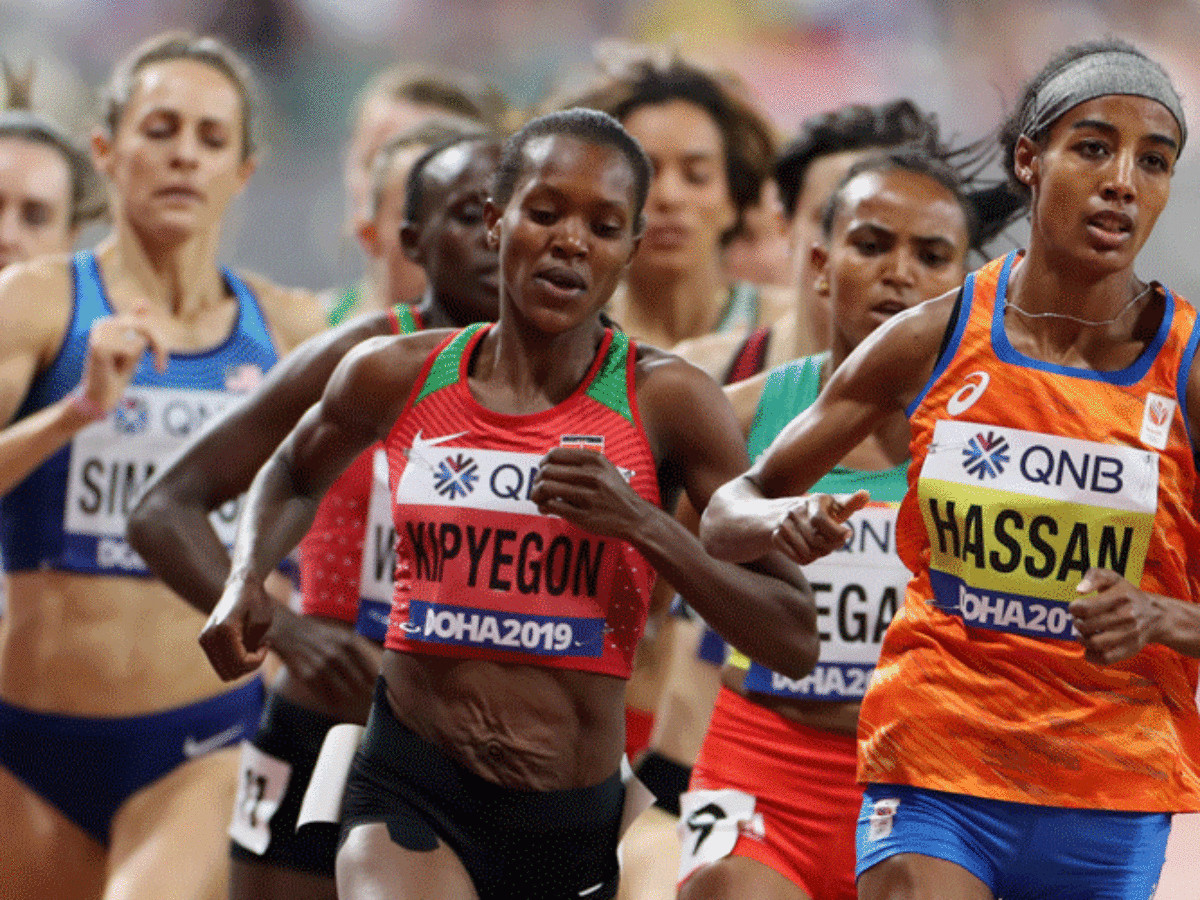
Nation Sport caught up with the four-lap race queen at her training base in Kaptagat, Elgeyo Marakwet during her speed work session where she said that her preparations are complete.
“I have done good preparations and I know the race will be competitive and my target is to get into the finals where I know my friend Sifan will also be eyeing victory. For me it’s a matter of winning and defending the title I won in 2016,” said Chepng’etich.
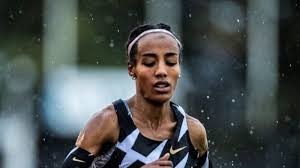
The two met during the Monaco Diamond League race and Faith came out on top, narrowly missing the world record after timing a new national record of 3:51.07, which was also a world lead time.
Sifan clocked 3:53.60 to finish second, while Ethiopia’s Hailu Freweyni was third in 3:56.28.
Chepng’etich said that she is aware that Sifan will be out to dethrone her, but remains confident of holding her off in Tokyo.
“I ran in Monaco and clocked my personal best and I wanted to gauge my performance ahead of the Olympic Games. I managed to identify some few areas which I have worked on and will give my best in Tokyo,” said the mother of one.
The 1500m heats will be held on August 2, before the semi-finals take center stage on August 4. The final is due on August 6.
(07/28/2021) ⚡AMPby Bernard Rotich
Tokyo 2020 Olympic Games
Fifty-six years after having organized the Olympic Games, the Japanese capital will be hosting a Summer edition for the second time, originally scheduled from July 24 to August 9, 2020, the games were postponed due to coronavirus outbreak, the postponed Tokyo Olympics will be held from July 23 to August 8 in 2021, according to the International Olympic Committee decision. ...
more...Ban on cannabis, should be reviewed says World Athletics president Seb Coe
The rules on the use of cannabis by athletes should be reviewed, World Athletics President Sebastian Coe has said in the wake of the case that meant Sha'Carri Richardson, winner of the women’s 100 meters at the US Olympic trials, missing Tokyo 2020.
Richardson accepted a 30-day ban, and the qualifying results she achieved were annulled, after she tested positive for the banned recreational drug during the trials.
The 21-year-old said she had been under emotional stress after learning of the recent death of her biological mother.
In response to questions on the issue, Coe has said a review is now sensible and "it should be" done, Reuters reports.
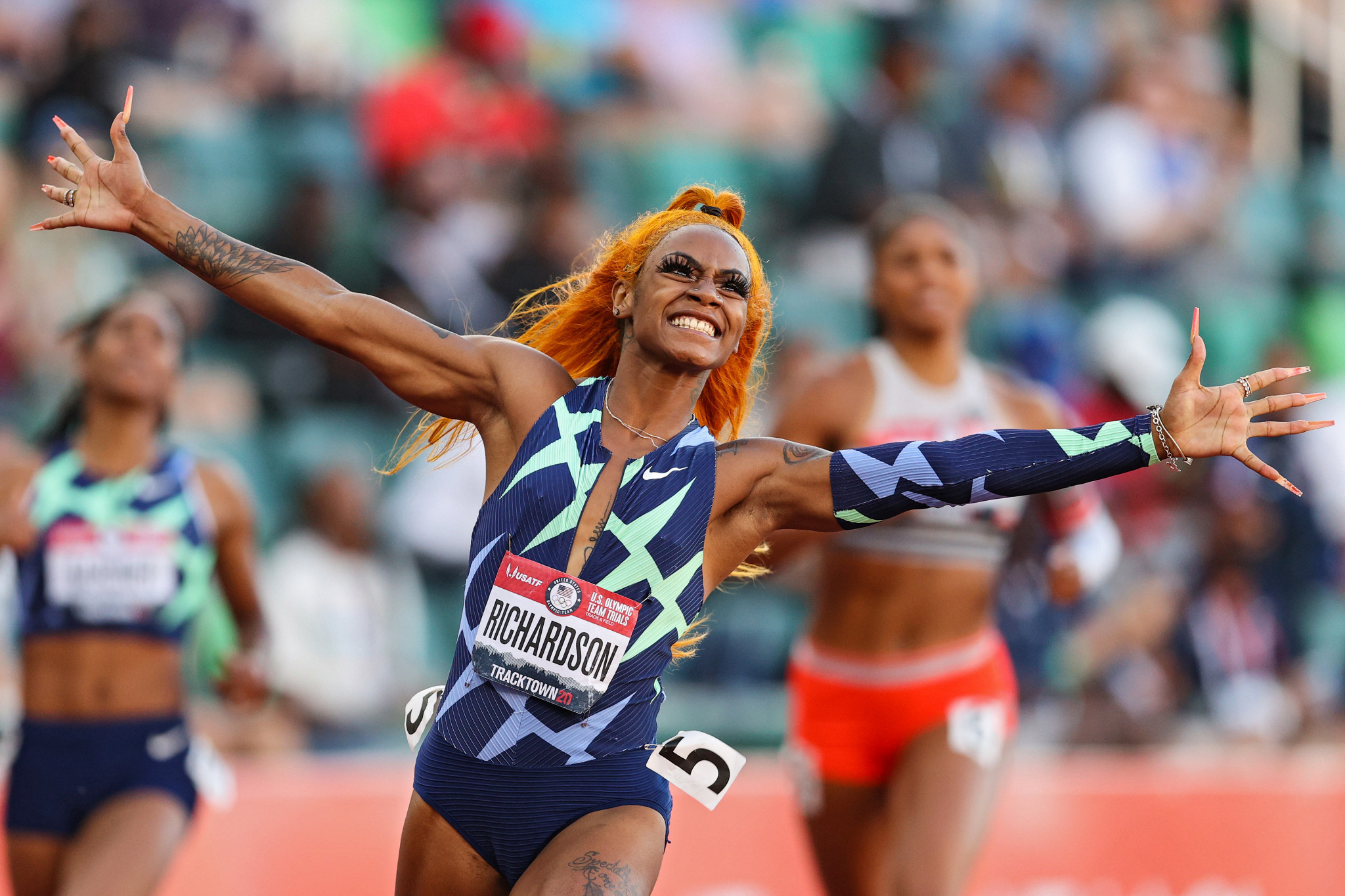
Coe added: "I am sorry for her that we have lost an outstanding talent [from the Olympic Games]", but said that existing rules were interpreted correctly.
The World Athletics President said he had asked the independent Athletics Integrity Unit (AIU) to work with the World Anti-Doping Agency (WADA) on reassessing marijuana’s place on the prohibited list.
Coe, who believes the matter is a question for experts at the AIU and the WADA to determine, said Richardson’s absence was "a loss to the competition" but predicted "she will bounce back".
The 2021 World Anti-Doping Code classifies tetrahydrocannabinol (THC), the main psychoactive constituent of cannabis, marijuana, and hashish, as a "Substance of Abuse".
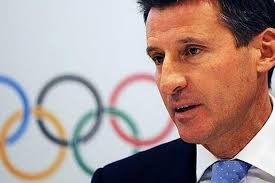
Athletes found to use it outside of competition face a three-month ban, although in this case the United States Anti-Doping Agency banned Richardson for 30 days as long as she also undertook a treatment programme.
Discussion on this matter is not expected to take place during the World Athletics Council’s two-day meeting that starts tomorrow before the Olympic track and field programme begins on Friday (July 30) - at least officially.
What will be under consideration is a determination of the hosts for the 2023 World Athletics Relays, held this year in Poland, the newly-established 2023 World Road Running Championships, and next year’s World Race Walking Team Championships, where a replacement is being sought for original host Minsk.
World Athletics cited "uncertainties around diplomatic relations and international travel restrictions with regard to Belarus" when stripping Minsk of hosting rights earlier this year, with protests continuing after the controversial re-election Alexander Lukashenko as the country’s President last August and many nations imposing sanctions on Belarus.
There will also be a report from World Athletics' Russia Taskforce at the Council meeting.
Day two of the meeting is understood to involve commission and working group reports.
(07/27/2021) ⚡AMPby Mike Rowbottom
Flora Duffy delivers a golden first for Bermuda, winning the olympic women triathlon
Flora Duffy claimed a first ever Olympic Games gold medal for Bermuda with a brilliant display to win the women’s triathlon at Tokyo 2020.
The 33-year-old, world champion 2016 and 2017, was virtually faultless as she negotiated treacherous conditions in the swim and on the bike before making a decisive move to clinch victory on the run.
Great Britain’s Georgia Taylor-Brown saw her hopes of gold ruined by a flat rear tyre late in the bike leg, but fought back brilliantly to pip American Katie Zaferes to silver. The American claimed the bronze.
The conditions in Tokyo were vastly different from Monday’s men’s race – then it was brutal heat and humidity, now it was torrential rain which caused a 15-minute delay to the scheduled start.

Britain’s Jess Learmonth went out hard on the swim and led the field out of the water at the end of the first lap, just ahead of Brazil’s Vittoria Lopes. Americans Zaferes and Summer Rappaport were also in close attendance with Duffy and Learmonth’s Britain team-mate Taylor-Brown.
A lead group of seven exited for T1 with Learmonth (18:24) still in front and Zaferes, Rappaport, Duffy and Taylor-Brown all in very close attendance. The third British athlete Vicky Holland meanwhile was in the second group, just under 50 seconds off the pace.
The field was already well strung out as they headed for their bikes, such was the pace that Learmonth had injected.
Bike – small but select
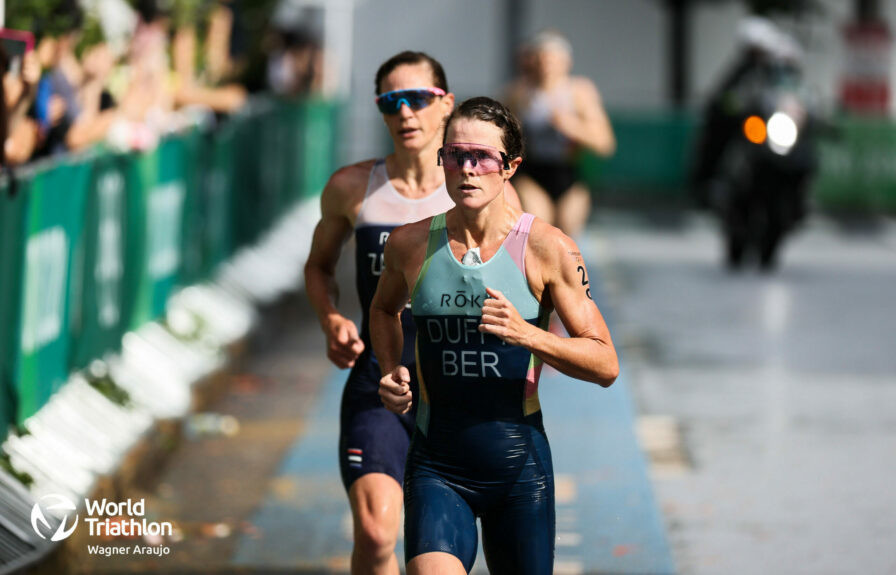
Learmonth led that select lead pack through the early stages of the bike leg, but by the end of the first lap she’d been joined at the front by Taylor-Brown and Duffy. Rappaport meanwhile was clinging desperately onto the back of the group. The chasing pack were more than a minute off the pace, with 2012 Olympic champion Nicola Spirig leading them in typical style.
The second lap saw the status quo maintained, with Duffy leading the lead group through along with Zaferes, Taylor-Brown and Learmonth. Rappaport was still struggling to maintain her position at the back of that group. The gap to the chasing pack led by Spirig was still more than a minute.
Seven became six in the lead group by the end of Lap 3 as Rappaport fell away to cross the line 37 seconds off the pace. Up front it was still the big guns Taylor-Brown, Learmonth, Duffy and Zaferes leading the way. They were in company with Germany’s Laura Lindemann and the Brazilian Lopes.
Run – decisive from Duffy
Zaferes, Lindemann, Duffy and Learmonth set off on the 10k run knowing they were in prime position to fight it out for the medals, while Taylor-Brown tried desperately to get back on terms.
Duffy made the first decisive move on the opening lap of four on the run, surging clear of Zaferes. Taylor-Brown meanwhile was making progress as she picked off team-mate Learmonth and Lindemann to move back into a medal position. At the end of that first lap Flora was 17 seconds clear of Zaferes with Taylor-Brown a further nine seconds away.
Flora, looking imperious out in front, pulled further clear on the second lap and at halfway on the run her advantage was now 47 seconds over Zaferes. Taylor-Brown meanwhile was just five seconds down on the American in the battle for silver.
The dominant Duffy increased her lead to 67 seconds on the third of the four run laps, while Taylor-Brown passed Zaferes to move into second just as the pair reached the bell.
Flora was still full of running as she powered through the final lap to come home to a famous victory in a winning time of 1:55:36. She was 74 seconds clear of silver medallist Taylor-Brown, while Zaferes was a further 13 seconds away in the bronze medal position.
(07/27/2021) ⚡AMPby Graham Shaw
Alberto Salazar gets lifetime ban for sexual, emotional misconduct
Alberto Salazar, the 1982 Boston Marathon champion from Wayland and once a prominent Nike coach of some of the world’s top distance runners, was permanently barred from participating in track and field Monday by the US Center for SafeSport, which cited Salazar for sexual and emotional misconduct.
Salazar, 62, has 10 business days to request an appeal through arbitration of the ruling made by SafeSport, a nonprofit founded in 2017 to protect athletes from sexual, physical and emotional abuse.
The decision Monday was the latest stage of a humiliating fall for Salazar, who was suspended for four years in September 2019 by the United States Anti-Doping Agency for violating rules governing banned substances. He is appealing that suspension to the Court of Arbitration for Sport, the Swiss-based equivalent of a Supreme Court for international sports.
The SafeSport charges were not detailed Monday. In January 2020, the organization temporarily barred Salazar from participating in track and field after elite female runners who formerly trained under him, including Mary Cain, Amy Yoder Begley and Kara Goucher, described what they said were years of psychological and verbal abuse by the coach.
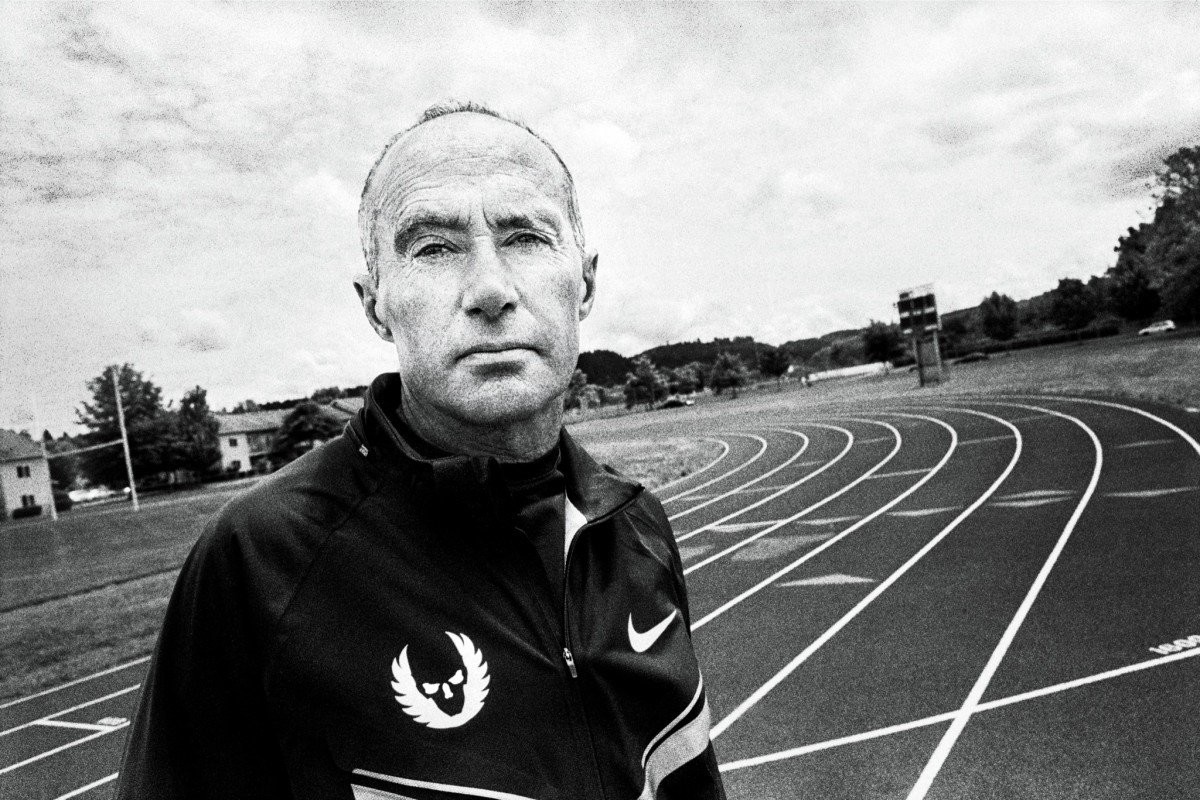
Neither Salazar nor his lawyer immediately responded to requests for comment Monday. Salazar has previously denied all accusations of misconduct.
In a 2019 video produced by the Opinion department of The New York Times, Cain, a former high school phenom from New York who is now 25, accused Salazar of shaming her in front of others on the Nike Oregon Project team — which has since been disbanded — when she did not reach weight targets. She said that her low weight caused her to miss her period for three years, leading to lower levels of estrogen and five broken bones.
Cain also said that she had suicidal thoughts and had cut herself, but that no one at Nike “really did anything or said anything.”
Yoder Begley, a 2008 Olympian, tweeted in 2019 that she was removed from the Oregon Project after a disappointing showing in the 10,000 meters at the 2011 United States track and field championships.

“I was told I was too fat and ‘had the biggest butt on the starting line,’ " Yoder Begley wrote.
Goucher, another American Olympian who once trained with the Nike Oregon Project, told The Times that after being cooked meager meals by an assistant coach, she often ate more in the privacy of her room, nervous that she would be heard opening the wrappers of energy bars she furtively consumed.
Salazar replied to Cain’s 2019 video in a statement to The Oregonian newspaper: “Neither of her parents nor Mary raised any of the issues that she now suggests occurred while I was coaching her. To be clear, I never encouraged her, or worse yet, shamed her, to maintain an unhealthy weight.”
Cain acknowledged at the time that she had sought to train again with Salazar, seeking an apology, closure and his approval. But she described their relationship as poisonous, saying, “I was the victim of an abusive system, an abusive man.”
Salazar told Sports Illustrated in 2019 that his “foremost goal” was to promote athletic performance in line with the good health and well-being of his athletes, but he acknowledged, “On occasion, I may have made comments that were callous or insensitive.”
(07/27/2021) ⚡AMPby Jere Longman
Olympians, champions and top americans will lead fields for 2021 Asics Falmouth Road Race
Falmouth Road Race, Inc., organizers of the 49th Annual ASICS Falmouth Road Race, one of America’s premier running events of the summer season, today announced the men’s, women’s, and wheelchair open fields for this year’s race. Defending champions Leonard Korir and Sharon Lokedi lead an accomplished field of Olympians, World Champions and top Americans participating in the August 15, 2021 race.
WOMEN’S OPEN DIVISION
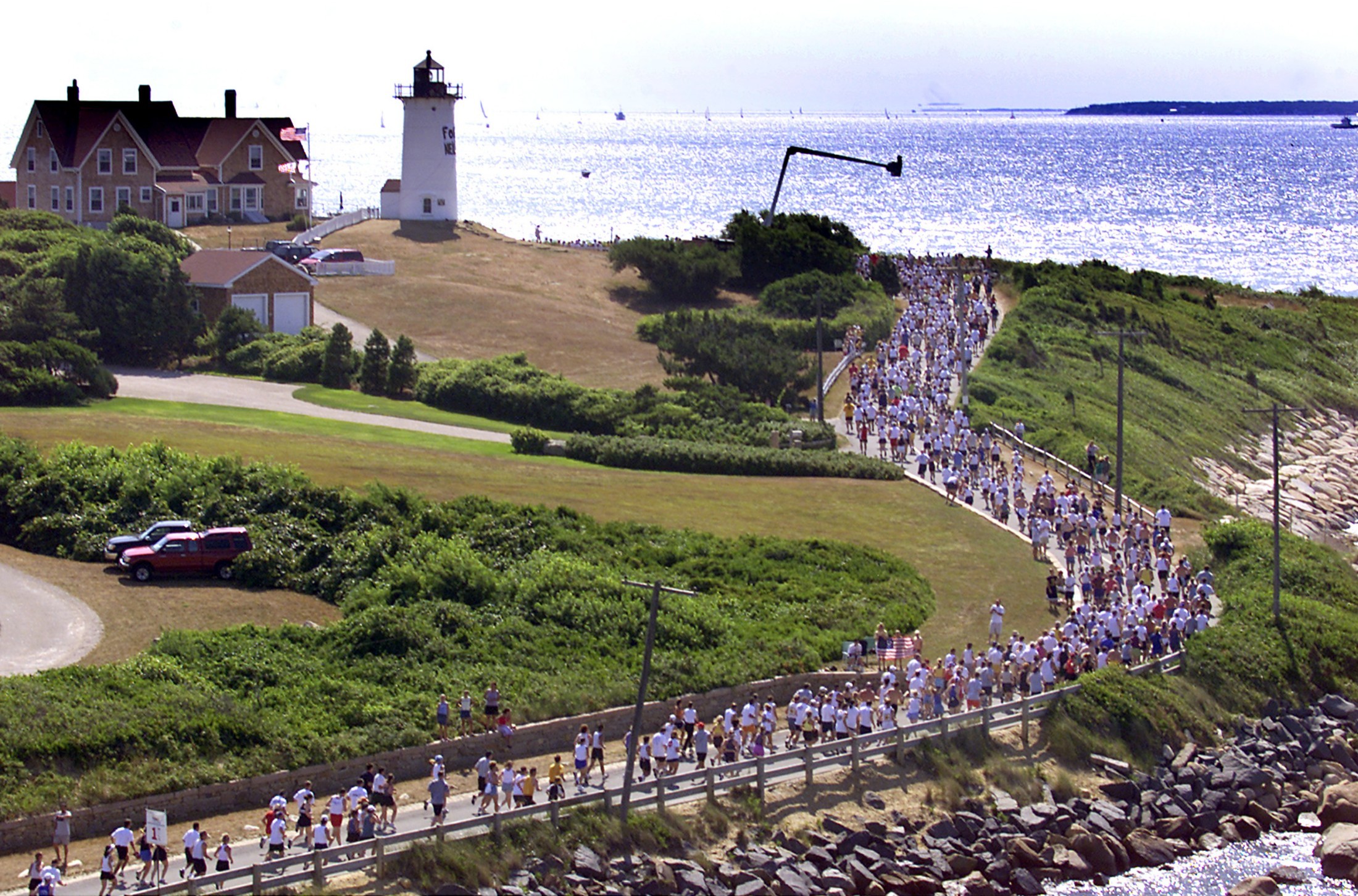
Lokedi, a Kenyan elite and 10-time All American at the University of Kansas, will race 2019 runner-up Sara Hall, who has won 11 U.S. national titles from the mile to the marathon. Hall recently finished sixth at the U.S. Olympic Trials 10,000m and won the AJC Peachtree Road Race, which hosted the National 10K Championships. The duo is joined by Edna Kiplagat, a Boston, London and New York City champion as well as a two-time World Athletics Marathon Championships gold medalist.
Twelve-time All American and NCAA DI 10,000m champion Emma Bates and 2021 Olympic marathoner Molly Seidel will also participate. Bates is gearing up for a fall marathon and Seidel will run, alongside her sister Isabel, as a post-Olympic celebration.
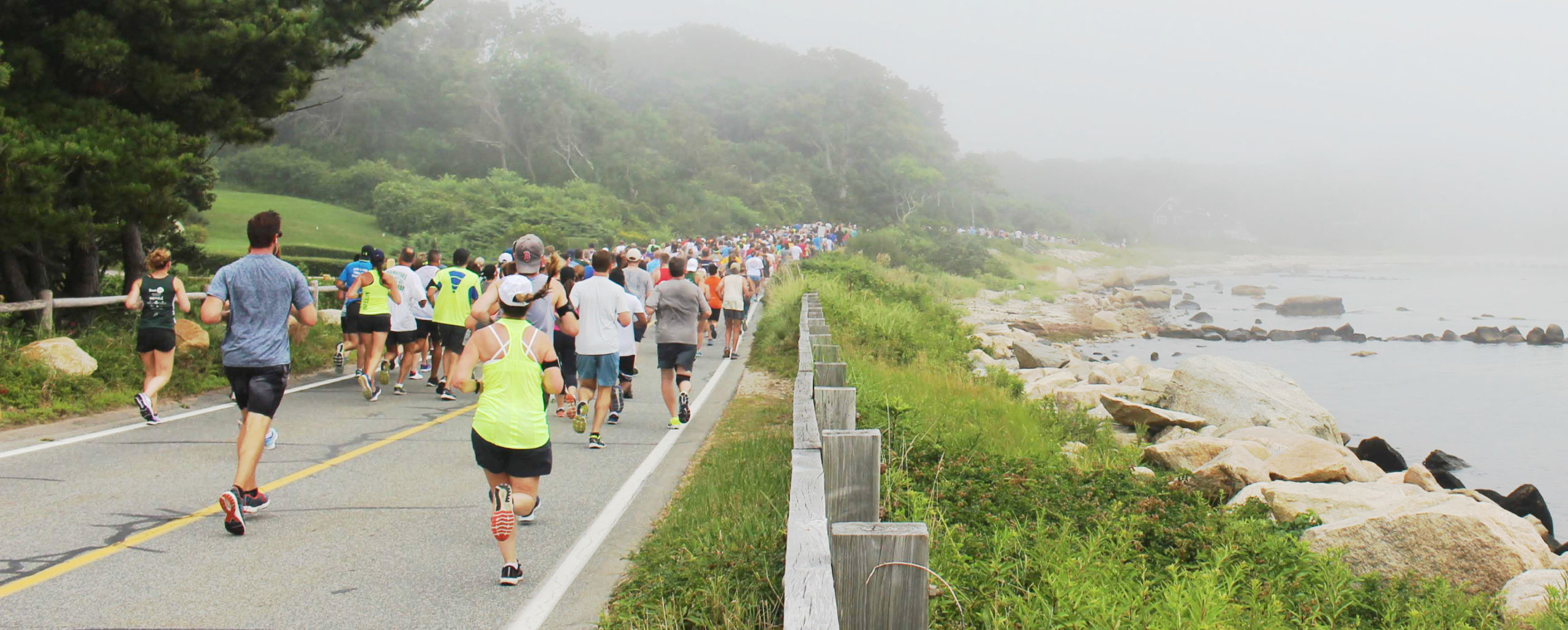
Accomplished women racing the leaders include Jordan Hasay, an 18-time All American and multiple podium finisher at the Boston and Chicago Marathons; former Falmouth champion and three-time Olympian Diane Nukuri; NCAA 10,000m champion Natosha Rogers; young talent Iveen Chepkemoi; Emily Durgin who finished runner-up at the AJC Peachtree Road Race with a 31:49 personal best, and Taylor Werner the recent USATF National 6K champion.
Many of the women in the field raced in the 5,000m and/or 10,000m at the recent U.S. Olympic Track Trials including Rogers, Durgin, Werner, Erika Kemp, Makena Morley, Jaci Smith, Fiona O’Keefe, and Paige Stoner.
MEN’S OPEN DIVISION
The 2019 podium of Leonard Korir, Stephen Sambu, and Edward Cheserek return. Korir, an Olympian, became the first American man to win the Falmouth Road Race since 1988. He has 10 USATF national titles and holds the fastest-ever marathon debut by an American (2:077:56).
Sambu looks to add an impressive fifth Falmouth Road Race title to his name. A road running star, Sambu set the 8K world record at the B.A.A. 10K, a race he has won twice. He is also a four-time champion of the Shamrock Shuffle. Edward Cheserek, the most decorated NCAA distance runner of all time with 17 NCAA Division I titles, ran for the University of Oregon. At Boston University in 2018, Cheserek ran the indoor mile in 3:49.44, which at that time was the second fastest indoor mile in history.
Chasing the trio are 2018 Falmouth Road Race champion and 2018 NCAA 10,000m winner Ben Flanagan, of Canada, and Ben True, who holds five national titles, set a 5K national record at the 2017 B.A.A. 5K and recently finished fourth in the 10,000m at the U.S. Olympic Trials. Fresh from a two second 1-2 finish at the 2021 AJC Peachtree Road Race, Sam Chelanga, a six-time USATF National Champion, and Fred Huxham are in the field, as are B.A.A. 10K champion David Bett, 2018 Falmouth runner-up Scott Fauble and top 5,000m runner Emmanuel Bor.
Many of the men running the ASICS Falmouth Road Race competed at the 2021 U.S. Olympic Track Trials including Korir, Chelanga, Bor, True, Biya Simbassa, Jacob Thomson and Frank Lara.
(07/27/2021) ⚡AMPby Running USA
Falmouth Road Race
The Falmouth Road Race was established in 1973 and has become one of the premier running events of the summer season. Each year the race draws an international field of Olympians, elite runners and recreational runners out to enjoy the scenic 7-mile seaside course. The non-profit Falmouth Road Race organization is dedicated to promoting health and fitness for all in...
more...World record holder Eliud Kipchoge is ready to defend his Olympic crown
World marathon record holder Eliud Kipchoge cannot wait to defend his Olympic crown at the 2020 Tokyo Games.
Eliud won gold at the Rio Olympics in 2016 and is favorite to bag gold at the Summer Games.
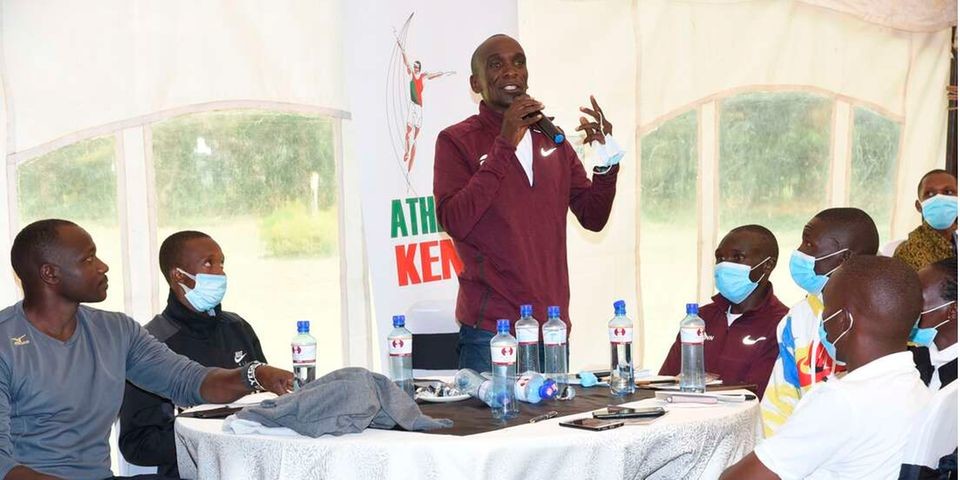
"I have completed my training and I am really excited to race in Sapporo. For me, there is no greater race than competing for an Olympic medal. In Japan, I will defend my title from Rio, to win a second Olympic medal in the marathon would mean the world to me," he posted on his Twitter handle Monday.
Kipchoge became the first man to ever run a full marathon, 42.195km, under two hours when he clocked 1:59:40 in Vienna, Austria in 2019. He also holds the world record over the distance at 2:01:39.

Eliud is in the marathon team that also has Lawrence Cherono and Amos Kipruto. The women's team has record holder Brigid Kosgei, Ruth Chepngetich and Peres Jepchirchir.
The marathon teams will leave for Japan on August 1 and 2. The women's race will be held on August 7, while the men's race is on August 8 in Sapporo.
(07/26/2021) ⚡AMPby Brian Yoga
Tokyo 2020 Olympic Games
Fifty-six years after having organized the Olympic Games, the Japanese capital will be hosting a Summer edition for the second time, originally scheduled from July 24 to August 9, 2020, the games were postponed due to coronavirus outbreak, the postponed Tokyo Olympics will be held from July 23 to August 8 in 2021, according to the International Olympic Committee decision. ...
more...Women that have been barred from Olympics for being manly
One day, Annet Negesa was pushing her body to endure and make her the champion she believed she was born to be. On another day, her Olympics dreams were crushed because she was faster, stronger.
Annet Negesa reportedly still harbours intentions to run for her country. She runs every day, with the hope of returning to international competitions one day.
Hers is a case of unfinished business, a dream that was cut short in June 2012 when she received a call from a doctor from track and field’s world governing body telling her, according to the New York Times newspaper - that “she would no longer be competing in the London Olympics because her testosterone levels were too high for competition,” thereby giving her an unfair advantage over other female athletes.
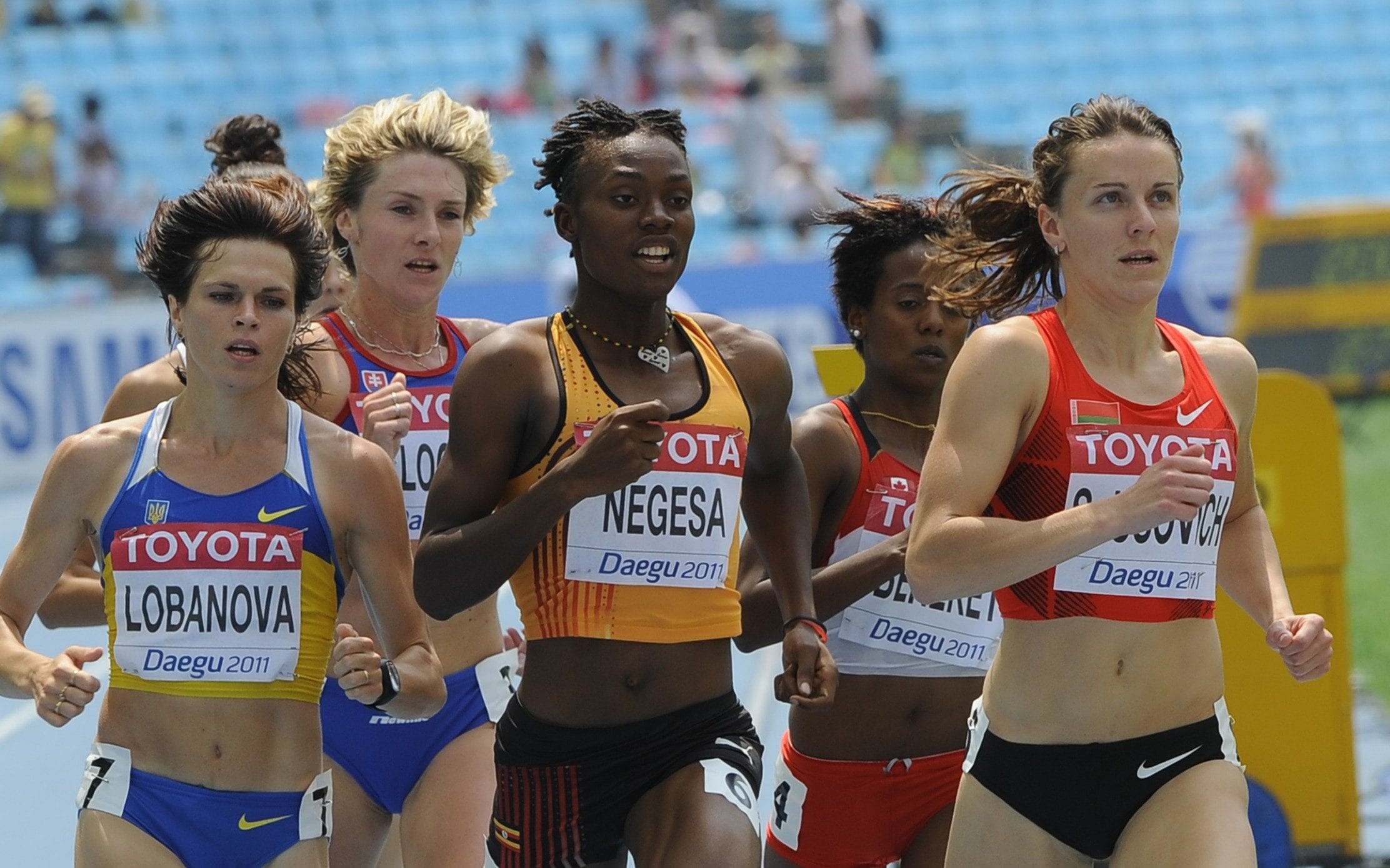
Negesa, 20 then, was one of Uganda’s top athletes. On the back of her London preparations, she set a national record for 800 metres earlier that year at a meet in Netherlands.
She was a three-time national champion and brought home a gold medal at the 2011 All-Africa Games.
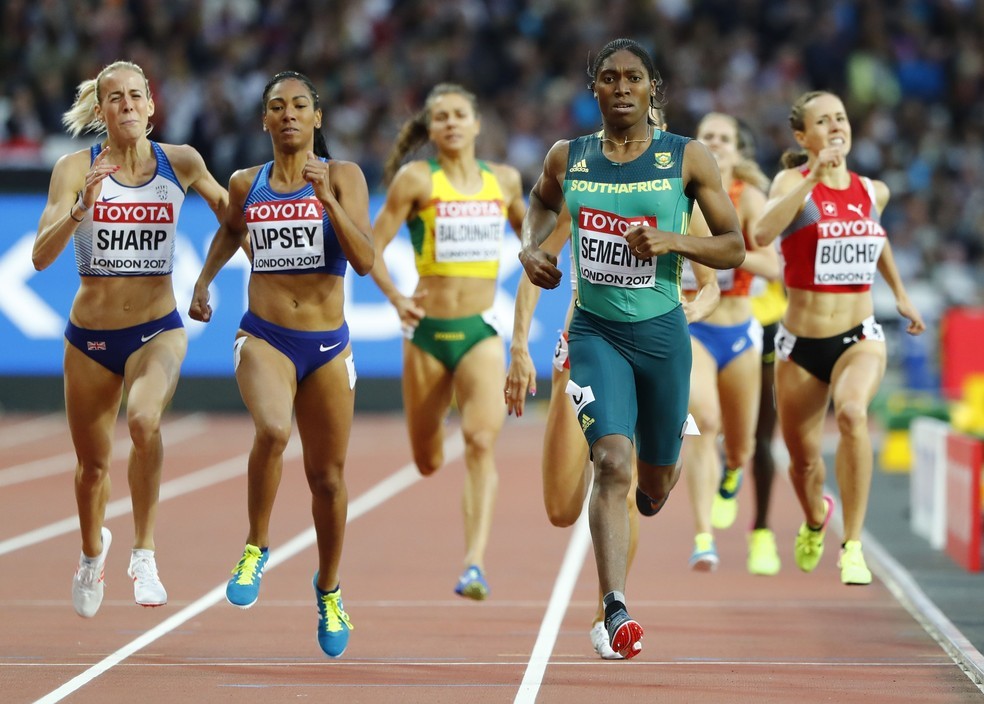
She identifies as female and was born with external female genitalia but also with internal male genitalia that produce levels of testosterone that men do.
Most women, including elite female athletes, have natural testosterone levels of 0.12 to 1.79 nanomoles per litre, according to World Athletics. The typical male range after puberty is reportedly much higher, at 7.7 to 29.4 nanomoles per litre.
After years of litigation, the Court of Arbitration for Sport (CAS) in 2019 upheld World Athletics’ testosterone restrictions for female athletes in races with distances from 400 meters to the mile after renowned athlete Caster Semenya (we shall get to her later in the article), filed an appeal.
The court ruled by a 2-to-1 vote that the restrictions were indeed discriminatory but also a “necessary, reasonable and proportionate” means of achieving the World Athletics goal of preserving a level playing field in women’s track events.
Therefore intersex athletes (these are said to be roughly one in every 2,000 births), who want to participate in middle-distance women’s track events must take hormone-suppressing drugs and reduce testosterone levels to below five nanomoles per litre (5 nmol/L) for six months before competing, then maintain those lowered levels.
Unfortunately, the intervention seems to have come seven years late for Negesa, who claims World Athletics physician Dr Stéphane Bermon gave her surgery as her first option to reduce testosterone levels in 2012.
But Negesa has since battled persistent headaches and achy joints that have not allowed her to pursue her career. Her postoperative care, which according to documents seen at the Kampala Hospital by the New York Times should have been recommended in further discussions with Dr Bermon, did not include the kind of hormone treatment that might have helped her body adjust to the change.
After Negesa appeared in a ‘break the silence’ documentary on German television’s ARD network in October 2019, World Athletics issued a statement denying that it participated in or recommended a specific treatment to Negesa.
Third category
Nine years after Negesa’s predicament, another recommendation to World Athletics; to introduce a third category of events in order to allow competitors with high testosterone levels to compete in their preferred disciplines, seems to be gathering steam after Kenyan 800m runner Margaret Wambui was ruled out of the Tokyo 2020 Olympics.
“It would be good if a third category for athletes with high testosterone was introduced; because it is wrong to stop people from using their talents,” Wambui told BBC Sport Africa.
The sport’s governing body, World Athletics, says it has no plans to introduce such a category and will stick to its current classifications of men’s and women’s events.
The idea of a third category in athletics has been floated before, but Wambui is the first athlete to express outright support for the suggestion.
“We would be the first people to compete in that category - so we can motivate others who are hiding their condition,” she said.
Since World Athletics introduced its latest rules governing DSD (disorders of sex development) athletes in 2018, not one of the three athletes who stood on the 800m podium in Rio has contested the distance at a global international championship.
At the 2016 Games, Wambui was beaten to gold by Semenya and silver by Burundi’s Francine Niyonsaba.
“It is sad to see that the whole podium won’t be there.” “They cut short our careers, because that wasn’t our plan. I feel bad that I won’t be in the Olympics because of World Athletics rules,” says Wambui.
(07/26/2021) ⚡AMPby Daily Monitor
Tokyo 2020 Olympic Games
Fifty-six years after having organized the Olympic Games, the Japanese capital will be hosting a Summer edition for the second time, originally scheduled from July 24 to August 9, 2020, the games were postponed due to coronavirus outbreak, the postponed Tokyo Olympics will be held from July 23 to August 8 in 2021, according to the International Olympic Committee decision. ...
more...Try these fitness-test workouts to gauge where you're at before a race
When you have a goal race coming up, you may want to test yourself a few weeks ahead of time to see where you’re at before you toe the start line. Similarly, it’s a good idea to test your fitness at the beginning of a training block and then again near the end to get an idea of how you’ve progressed.
While there are many ways you can do this, we spoke with Mile2Marathon coaches, Lauren Andrews and Mathew Travaglini, who gave us their favorite fitness-test workouts for you to try before your next race.

The 8K time trial
Andrews really likes using off-distance time trials as a way to gauge fitness before a race, because since you race this distance infrequently, your desire to compare your result to a previous personal best won’t be as strong as it would be in a 5K or 10K trial. Her favorite distance for this purpose is 8K.
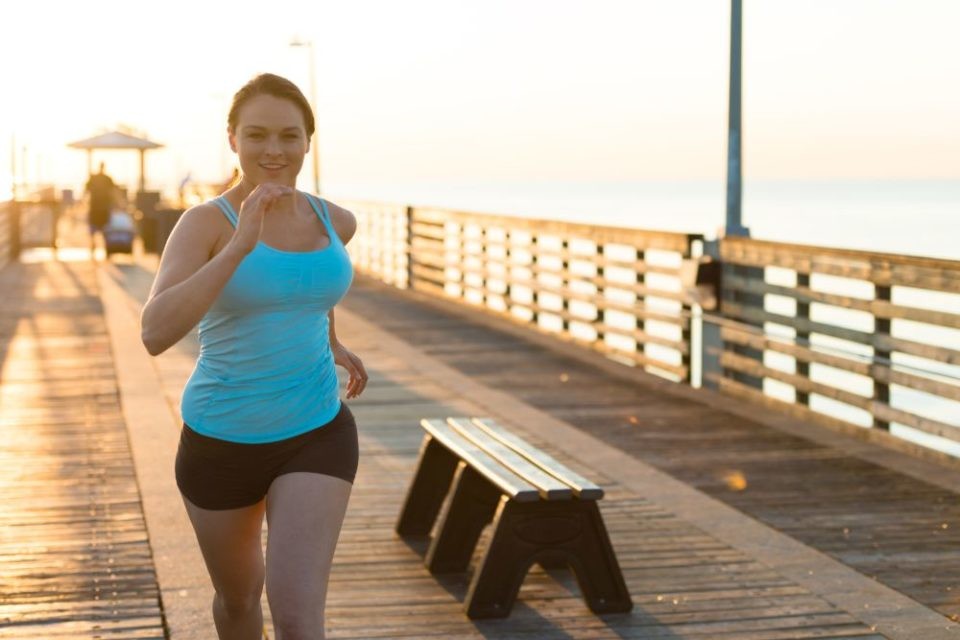
“This distance is short enough to not require extended recovery after, but long enough to be relevant to someone, say, beginning a marathon build or in mid-build,” she explains. “You can easily calculate the equivalency of an 8K to a 5K, 10K or even half marathon too.”
Andrews emphasizes that a time trial should be done a minimum of two weeks out from a big race, but preferably you should use it as an assessment of your progress midway through your training. Even though this is a time trial and not a real race, you want to do your best with it in order to determine where you’re at as accurately as possible, so make sure you prepare properly before you start. Get plenty of rest, stay properly hydrated and be sure to fuel appropriately before the workout.
Medium-length intervals
Travaglini says the type of workout you do to test your fitness will be slightly different depending on the race you’re training for, but he really likes to use medium-length intervals (anywhere from 800m to 1,200m) at your goal race pace that covers about 60 to 80 per cent of your race distance. For example, if your goal race is a 5K, he suggests the following workout:
Warmup: 10-15 minutes easy jog, followed by drills and strides
Workout: 5 x 800m at goal race pace with equal rest (so if you take 4:00 to run 800m, give yourself four minutes of rest)
Cooldown: 10- to 15-minute easy jog, followed by light stretching.
(07/26/2021) ⚡AMPby Brittany Hambleton
Research says talent will get you so far, but it's the gritty athletes who rise to the top
Have you ever wondered what separates elite athletes from the rest of us, or what allows one competitor to perform at a consistently high level no matter the odds? Of course, physical ability, resources and skill all come into play here, but there’s one ingredient that seems to outweigh the rest: grit. Behavioural psychologist Angela Duckworth defines grit as a special blend of passion and persistence, and she, along with many other experts, agrees it is what pushes someone to show up day after day, make sacrifices and push through setbacks to become the best.
According to a 2007 paper written by Duckworth, “grit entails working strenuously toward challenges, maintaining effort and interest over years despite failure, adversity, and plateaus in progress. The gritty individual approaches achievement as a marathon; his or her advantage is stamina. Whereas disappointment or boredom signals to others that it is time to change trajectory and cut losses, the gritty individual stays the course.”
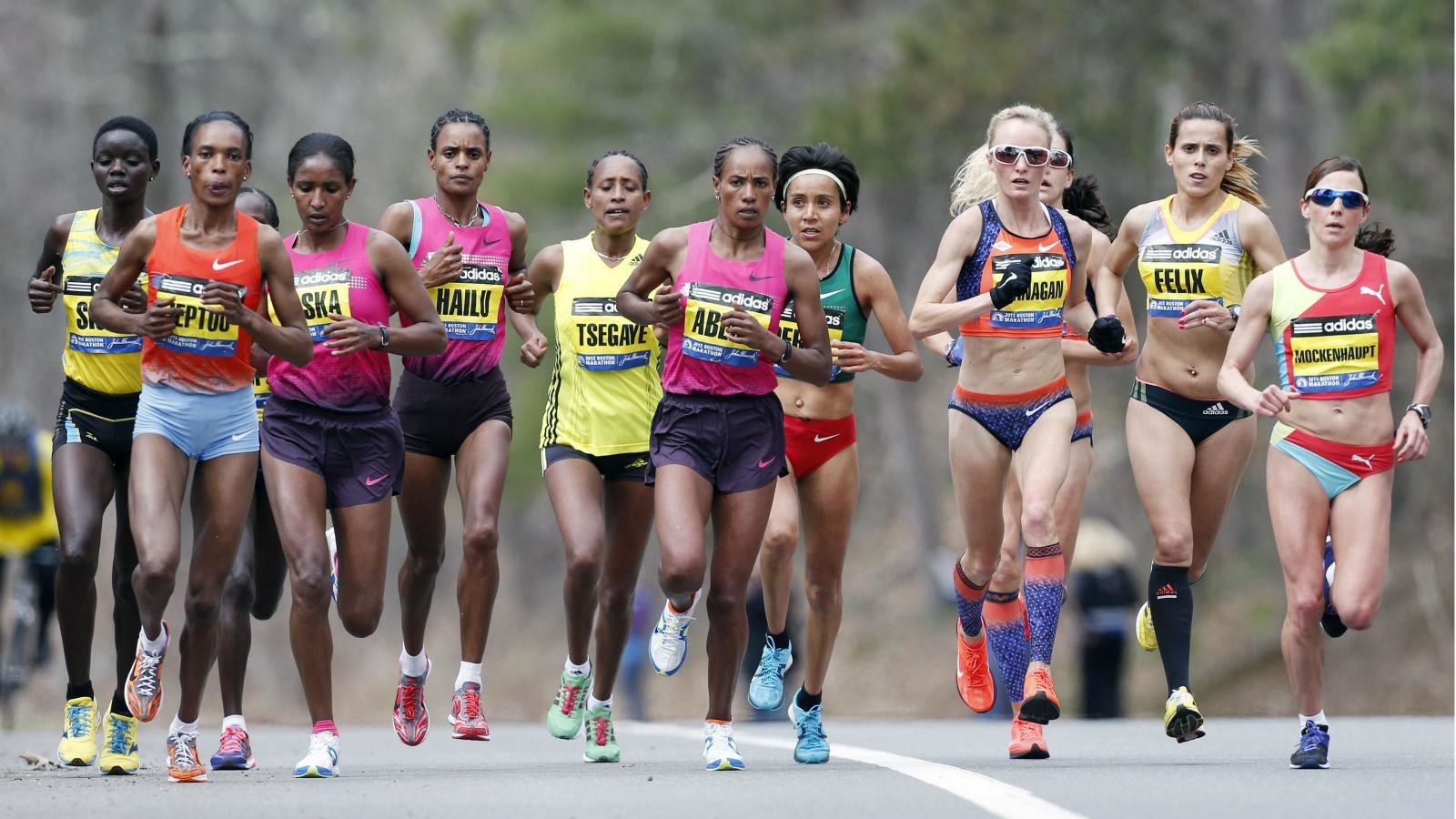
This definition highlights one important factor that determines success in running, and that is the time it takes to achieve that success. When a new elite runner bursts onto the scene, it’s easy to think they just magically became really good, but what we don’t see are the years of strenuous, focused effort it took for them to get there. That person has already experienced several setbacks and failures, and yet they’ve carried on.
In Duckworth’s 2016 book, titled Grit, the Power of Passion and Perseverance, she outlines the two equations that lead to achievement. The first is talent x effort = skill. Most research agrees that in order to make it to the top level in sport, there is an element of innate ability, but this talent only tells part of the story. Without effort, talent goes nowhere. The second equation is skill x effort = achievement. When you put these two equations together, it means you need to apply effort to turn talent into skill, and then you need to apply more effort to translate that skill into achievement.

What does that look like in the context of running? When someone shows early talent in running, that will only help them go so far. If they want to continue improving, they need to apply effort in order to perfect skills like pacing, form, endurance and of course, racing. These are all things that need to be practised. Practising them over weeks, months and years is what will eventually lead to achievement (winning big races, setting records, etc.).
While the scientific literature is fairly limited in this area, there have been a few studies assessing the effect of grit on athletic performance, including this 2017 study that looked at more than 250 athletes from a variety of sports, including runners. Participants ranged from age 13 to 30 and came from a variety of skill levels, from local sports teams to international competitions. The researchers measured them on a “grit scale” comprised of two categories: perseverance of effort (PE) and consistency of interests (CI). They found that athletes who scored higher in the perseverance of effort were more likely to attend all mandatory and optional practices and to practise on their own. The athletes who scored higher on consistency of interests were also far less likely to quit their sport.
The bottom line
Grit is a difficult thing to measure, but it has a significant role to play in performance. All you have to do is listen to or read the stories of our Canadian Olympians and other elite runners to know that success doesn’t come easily, quickly or without sacrifice. So yes, are elite athletes naturally gifted? Sure. But talent alone has not gotten them where they are. For the rest of us, having a gritty mentality in our training may not take us to the Olympic stage, but it will lead us to reach a level we never thought possible.
(07/26/2021) ⚡AMPby Brittany Hambleton
Gloria Ratti, ‘first lady’ of the Boston Marathon, dies at 90
The Boston Athletic Association is mourning the loss of vice president, historian, and archivist Gloria Ratti, who died Saturday at 90 “after a courageous battle with cancer,” the organization said in a statement.
Ms. Ratti, a South Boston native, served the BAA and Boston Marathon runners in a variety of roles over more than half a century of involvement with the organization, according to the statement.

“Gloria in essence was the First Lady of our sport, no matter where she went,” Guy Morse, former BAA executive director and a longtime colleague to Ms. Ratti, said in the statement.
“From champions to common runners, Gloria personally cared for everyone and represented the human side of running,” he said. “It was her mission to make the Boston Marathon more than a single-day event; she strived to make it a personal experience for so many. She did that, but also was the moral authority that helped propel the entire organization forward.”
(07/25/2021) ⚡AMPby Nick Stoico, The Boston Globe
Boston Marathon
Among the nation’s oldest athletic clubs, the B.A.A. was established in 1887, and, in 1896, more than half of the U.S. Olympic Team at the first modern games was composed of B.A.A. club members. The Olympic Games provided the inspiration for the first Boston Marathon, which culminated the B.A.A. Games on April 19, 1897. John J. McDermott emerged from a...
more...Matthew Centrowitz runs a 3:49.26 mile
Running entirely solamente over the final 600 meters, your defending Olympic metric mile champion, Matthew Centrowitz Jr. ground out a hardscrabble 3:49.26 over the imperial one mile distance last night up in Portlandia.
In addition to setting a lifetime PB, that is THE fastest mile ever contested on U.S. soil by an American.
The previous such mark was the 3:49.89 run indoors by Bernard Lagat at the University of Arkansas oval back in February of 2005.
Solid. ✊
(07/25/2021) ⚡AMPby Mike Fanelli
Should You Be Drinking Protein Coffee?
The nutrition trend is all over TikTok, and it’s actually not a bad idea
Social media isn’t a great place to find wellness or nutrition advice. The most viral stuff tends to be the most over-the-top and the influencers who create it typically care more about shareability than science. Put bluntly: “Likes and follows do not indicate competence,” says Leslie Bonci, co-founder of Performance365 and the sports dietitian for the Kansas City Chiefs. But once in a blue moon, a viral nutrition trend is worth trying. Like protein coffee, which recently took TikTok by storm.

#Proffee is pretty simple: it’s a protein shake, made with coffee. And while the idea of a caffeinated smoothie isn’t earth-shattering, it has its merits, particularly if you’re someone who likes to work out in the morning. Here’s what two sports dietitians have to say about it.
How to Make It
There’s no master recipe for #proffee. Scroll through the tag on TikTok and you’ll find thousands of videos. One woman orders a couple of shots of iced Starbucks espresso in a venti cup and then pours a pre-made shake on top. Another uses a vanilla protein shake as “creamer,” and several people blend their own shakes with flavored protein powder, ice, and coffee instead of milk. You get the idea.
Protein coffee is a great way to kill two birds—nutrition and caffeination—with one stone. Let’s get one thing clear, though. “Coffee is not a meal,” says Abby Chan, a sports dietitian and co-owner of Evolve in Flagstaff, Arizona. “And adding protein to coffee still does not make it a meal.”
If you’re relying on protein coffee alone to get you through the morning, Bonci recommends adding carbohydrates by blending in a banana or eating some fruit or cereal alongside your drink. Chan points out that you could add fat with a scoop of nut butter, too.
Protein coffee works well alongside a regular breakfast, particularly if your morning meal contains less than 15 grams of protein. Chan says this is the minimum amount that most people should eat per meal, although there’s no need to hit this target on the nose every time. For reference: two large eggs contain roughly 13 grams of protein, a seven-ounce container of plain Greek yogurt has 20 grams, and a half-cup of rolled oats cooked in a cup of two-percent milk has 13 grams. If you’re already eating protein-rich foods at breakfast, Chan says, there’s not much benefit to adding it to your coffee, although it won’t cause any harm. “Your body can only absorb 25 to 35 grams during a meal,” she says.
Why It Works
Some TikTokers use protein coffee as a pre-workout drink. This makes sense, since caffeine is the main active ingredient in most pre-workout supplements, and a cup of coffee is far cheaper than a scoop of expensive powder. Bonci explains that for many people, consuming caffeine 30 to 60 minutes before a workout can boost endurance and increase focus.
But it might not work for everybody, and it’s not a magic bullet. Outside columnist Alex Hutchinson previously reported on a 2018 randomized controlled trial looking at caffeine’s effect on performance, published in Medicine and Science in Sports and Exercise. The study followed a group of 101 male athletes during 10k cycling time trials, and found that, while caffeine did boost performance on average, the athletes who benefited the most had a specific gene that helps them metabolize caffeine well—and those without that gene actually rode more slowly.
You likely already know from experience whether caffeine helps, hurts, or doesn’t affect your workouts. If you feel better exercising after coffee, Chan explains that adding protein could have some benefit for workouts lasting more than 90 minutes. When your glycogen stores are depleted, having amino acids (the building blocks of protein) readily available in your system will prevent your body from breaking down existing muscle to get them. But for shorter workouts, the protein probably won’t serve any purpose beyond helping you hit your nutrient requirements for the day.
Chan stresses that you shouldn’t need caffeine to train. “If you’re relying on caffeine to get through a workout, then you are not ready or recovered enough to be training,” she says.
“At the end of the day, protein coffee is simply a protein shake with caffeine,” Chan says. “It’s not a meal, and it’s not a magical elixir.” Frankly, it’s surprising that something so simple took off on TikTok, a space usually reserved for wellness trends that are either extreme or completely ridiculous (like dipping cucumber slices in stevia as a low-sugar substitute for watermelon). If you like the taste of a coffee protein shake, great! Just don’t drink it in lieu of breakfast.
(07/25/2021) ⚡AMPby Outside Online
How to Be a Super Commuter
The average American commutes nearly an hour per day. That adds up to nine days a year. But your trip to work doesn’t have to involve cramming your face into someone’s armpit on a packed train or suppressing road rage on a clogged freeway. Make like these four professionals and turn it into a mini adventure.
Nicholas Thompson

Editor in Chief at Wired, New York City
“My boss is Anna Wintour,” Thompson says. “I’m supposed to look good.” But at the risk of mussing his hair, he runs nine miles round-trip between his home in Brooklyn and his Manhattan office nearly every day, no matter the weather. Thompson does a marathon once or twice a year, and these daily jaunts are a big training help. “I’m able to stay in shape without having to find time in the day for it,” he says. “I get to relax and run twice a day. It’s a nice break.” Plus, he hasn’t bought a monthly transit pass in years.
Make your routine efficient. Thompson covers his one-way distance in 35 minutes on foot. And his shower routine is spartan—in and out in five minutes.
Plan ahead. Thompson keeps a few full outfits at the office and runs with a fanny pack (even though it slows him down by five to seven seconds per mile, according to Strava) to hold his keys, wallet, and phone.
Steal family time. “Showering at the gym means I don’t have to shower in the morning before I go, which means a few extra minutes with my kids.”
Beware of tourists. “The dangers are selfie sticks, cars driving the wrong direction down one-way streets, wedding photo shoots, and people getting out of cars. But it’s like 90 percent selfie sticks.”
Drew Myers
Founder of Banyan, Seattle
Myers’s commute lines up with his general ethos: an aversion to waiting and an affinity for wide-open spaces. He may love his ride to work more than anyone in the world. Since 2006, he’s been hopping on a jet ski from Mercer Island and zipping across Lake Washington to his office—passing everyone stuck in traffic on Interstate 90. Driving would take 30 minutes, but jet skiing takes about ten from dock to desk. “There’s nobody out there. It’s totally free,” Myers says.
Don’t fall in. But just in case, make sure you have the best computer drybag out there. “I could throw my Drycase in the water and it would be fine,” Myers says.

Embrace bad weather. “For the most part, I do it even in the pouring rain,” he says. He keeps his work clothes dry under head-to-toe waterproof gear.

Safety first. Myers always wears a life jacket. And he only commutes eight months of the year—in the winter it gets dark at 4:30 P.M., making for a potentially dangerous crossing.
Cassidy Doucette
Nurse practitioner at Huntsman Cancer Institute, Salt Lake City
Doucette’s car usually sits on the street. For the past nine years, she’s biked five miles round-trip to and from the hospital for convenience and personal enjoyment, but also to reduce her impact on the environment. Her route cuts through the University of Utah and offers uninterrupted views of the Wasatch Mountains. “Unless my errands require transporting large objects, I’m mostly able to bike anywhere I need to go,” she says.
Start the day off right. “I work with cancer patients. It’s emotionally and mentally challenging. Those 20 minutes on my bike in the morning give me perspective and goodness before a ten-hour shift.”

Watch out for pedestrians. “College kids looking down at their phones are my biggest obstacle.” 

Stay organized. Doucette leaves shoes at work and carries her post-shower clothes in a Patagonia Black Hole packing cube to keep them tidy in transit.
Phil Hitch
Director of product development at MSR, Seattle
Hitch commutes an hour and fifteen minutes each way in ultimate Pacific Northwest style: he bikes four and a half miles from his home on Bainbridge Island to the dock, hops on a ferry to downtown Seattle, then rides another two and a half miles to the office.
Consider it a workout. “I get an hour in the saddle every day, and I don’t have to go to the gym,” Hitch says.

Make no excuses. Hitch commutes approximately 200 days a year. In the winter it’s dark both ways, and there are no streetlights on most of the island. His advice: don’t think too hard, just put on your gear and head out the door. 

Join the crowd. Hitch says there’s a strong contingent of bike-ferry commuters in Seattle: a steady 30 people in winter, and 100-plus in the summer months. If it’s not too rainy for an outdoor commute in Seattle, then it’s not too rainy where you live.
(07/25/2021) ⚡AMPby Outside Online
8 simple rules for dating a runner
So you’ve fallen in love with a runner — congratulations! Runners, in our not-so-humble opinion, are possibly the best people on the planet. Of course, they do have their own quirks, and if you want to have a long-lasting relationship with the runner in your life there are a few things you should know. To keep them happy, follow these eight simple rules for dating a runner.
1. Never ask us if we’re going “jogging”


This is possibly the most offensive thing you can say to a runner. We run, we do not jog. There is a difference, so don’t get the two confused.
2. Don’t try to make plans for Sunday mornings
Sunday mornings are a sacred time reserved for our long run. If you want to plan an activity, it’s going to have to be in the afternoon. On that note, Sunday afternoons are usually spent recovering from our long run, so maybe just don’t plan anything for Sundays that involve straying too far from the couch…
3. Don’t expect us to stay out late on a Saturday night, either
Not only do we have to get up early in the morning for our long run, but we have to make sure we fuel properly the night before, and hydrate as well. You can go out and party if you want, but don’t expect us to join you.
4. Always make sure there’s lots of food in the house
Bonus points if that food is carbs. On that note — if you’re planning on starting a keto or low-carb diet, we most certainly will not be joining you. And we’re probably going to eat carbs in front of you, too.
5. If we come back from a long run missing a sock, don’t ask questions
Hey, sometimes you run into digestive issues while you’re out on the trail and you don’t have any other option. What happens on the trail, stays on the trail… as does the sock.
6. Don’t expect us to be flexible
We mean that both literally and figuratively. Our training schedule is set in stone and we’re pretty hard-nosed about it, so don’t expect us to move a track session so you can take us out to dinner. We’re also just happy if we can touch our toes without bending our knees, so if you’re hoping for some sort of acrobatics, you’re going to be disappointed.
7. Don’t buy us pedicures as gifts
OK, we get it — our feet are gross. But those calluses have been built up by miles and miles of training, and without them, we’ll be left hobbling the last few miles of our run with very sore feet. Then you’ll be stuck listening to us complain about our blisters for the rest of the week, and that’ll be even less fun for you than it is for us.
8. Get ready to be our #1 cheerleader
We’re going to run a lot of races, and there’s no one we want cheering us on more than you. Be prepared to get up early and stand outside in all types of weather only to catch a glimpse of us crossing the finish line — it may not be the most pleasant way to spend your weekend, but it will mean the world to us.
(07/25/2021) ⚡AMPby Running Magazine
Wedding dress and running shoes: runners tie the knot during race in Europe
Claudia Weber and Thomas Wenning have run over 100,000 kilometres together, gone through more than 150 pairs of running shoes and completed over 300 marathons, and on July 17, the pair were married during the Reschensee run in South Tyrol, Italy.
Weber and Wenning first got to know each other at the 2004 Rhine-Ruhr Marathon, and have been running together ever since. The Reschensee run is a 15.3 kilometre race around Lake Reschen that starts and finishes in the village Graun. The couple started the race together and walked directly to the registry office of the municipality of Graun and were officially married by the mayor. Immediately afterward, they continued the run and crossed the finish line in front of the town’s historic church tower, officially a married couple.
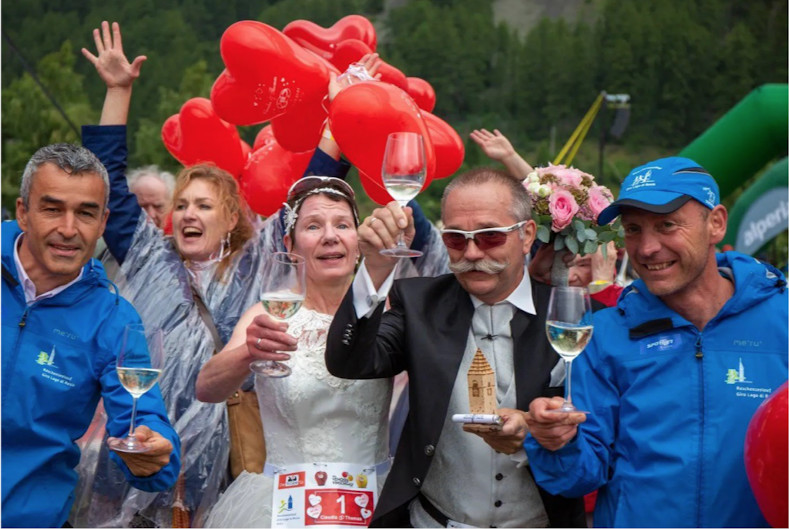
“When I crossed the finish line with Claudia in our first half marathon together in 2004, it was clear to me that this was the right one!” said Wenning. “Our joint running and charity projects have welded us together forever!”
Wenning promised his bride that at some point, he’d take her to the registry office. Weber said that if she got married, it would be to Wenning on a running track.
"Thomas is my second half,” said Weber. “I would like to share the adventure of life with him. Together we not only celebrated records and victories. Thomas stood by my side even in difficult times!”
(07/25/2021) ⚡AMP
by Running Magazine
Thousands run through London in first mass 10k since lockdown was lifted
Thousands of runners have taken to the streets of London for their first mass 10k since lockdown restrictions were lifted.
Roads across central London were closed as the runners in the Asics London 10k swept past views of landmarks to the sound of cheering crowds and entertainers who lined the streets.
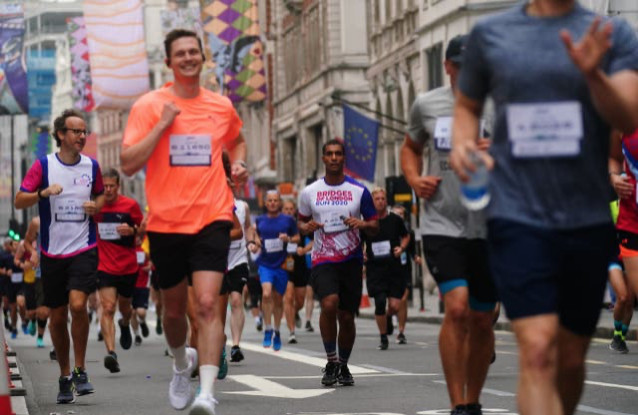
Race director Ian Allerton described it as “an important day for the mass participation industry” as many runners helped raise funds for more than 200 charities in what he hoped would be the start of “a new season of safe running events in 2021”.
TV presenter and activist Katie Piper who was the victim of an acid attack in 2008, officially started the race before stepping out to become one of up to 14,000 runners on the course.
Her run was to raise funds for a rehabilitation centre and she later said she had “such an amazing day”.
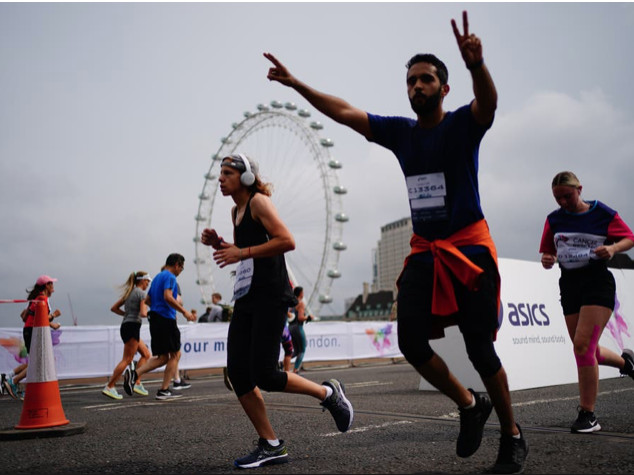
Ms Piper said it had been “really powerful” to see the benefit the race had on her mental wellbeing and on others who took part.
Organisers said they have been working closely with Westminster City Council and Public Health England over the past six months to ensure the event was Covid-secure.
The annual mass participation event, which was billed as “London’s best summer celebration of running,” was previously cancelled due to the pandemic.
The 2021 route was brought to life by the sounds of live bands and DJs at every 1km to help the runners keep moving as they raced past landmarks such as Westminster Abbey, Big Ben and the London Eye.
Andrew Heyes won the male race with a time of 29 minutes and 25 seconds, Natasha Cockram clocked 33 minutes and 37 seconds to cross the line first in the female run while Bethany Evans was victorious in the wheelchair event with a time of 40 minutes and 42 seconds.
Mr Heyes said: “I really enjoyed the sights and am so excited to be back after 18 months.”
Ms Cockram added: “It was brilliant being back out on the road. Since the pandemic I’ve only been able to train on the track.
“Being out on the big wide roads is so exciting, I want to do it again.”
The event came a day after thousands of adult joggers and walkers in England laced up their trainers to take part in 5km Parkruns in local parks for the first time since lockdown eased.
(07/25/2021) ⚡AMPAsics London 10K
When we run together, amazing things happen. We unite in a common aim, we spur each other on, the stuff that divides us falls away and we keep on going. So, this summer we invite runners of all abilities to unite in one of the world's most inclusive and diverse cities to celebrate the things that bringus together. When you...
more...The Bix is back: Race returns with resounding success
The crack of a starting pistol sent a scribble of smoke upward, queuing upbeat dance club music.
Miles away, a barber shop quartet serenaded with harmonic tones.

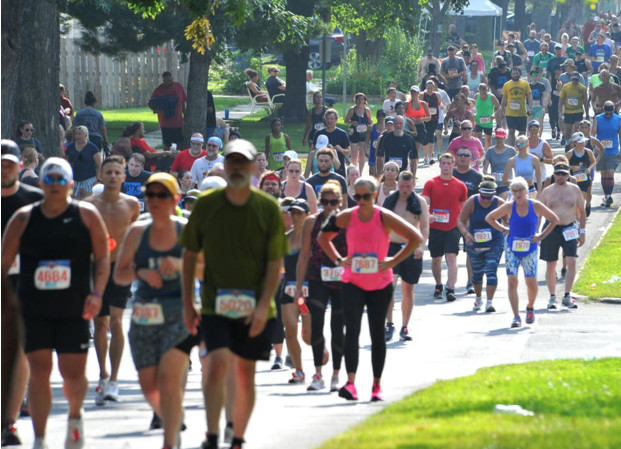
Palmer College of Chiropractic members dressed as vertebrae snaked their way up the infamously steep Brady Street.
Good Samaritans sprinkled cooling droplets of mist and rushed to the aid of an overheated runner.
A volunteer raked a neat pile of thousands of discarded water cups out of the road.
"These 14,000 cups have gotta go somewhere," Jen Broders said.
Post-race Jello shots were downed and accompanied by dives onto a front-lawn water slide.
Runner, walkers, past Olympians, pint-sized entrepreneurs, Marilyn Monroe look-alikes and "short-legged, no-talent" family members, friends and supporters packed the streets of downtown Davenport on Saturday morning for the 47th annual Quad-City Times Bix 7. More than 9,750 people registered for Bix races, according to race officials, marking the first time participation has dipped below 10,000 since 1986 (not counting last year's virtual Bix).
"Since last year's race ended, we've been planning for a very different race because our plans have changed on a monthly, weekly and daily basis," Bix 7 Race Director Michelle Juehring said.
The 53-year-old became race director in 2020 after the retirement of former longtime Race Director Ed Froehlich. She guided the race through its virtual version during the COVID-19 pandemic and was in the midst of preparing for her first full-blown Bix as its director.
Through all the changes COVID-19 forced in 2020, planning for the 2021 race was not without lingering pandemic-induced difficulties.
"We didn't know if the race would be open to all contestants until, basically, the last week in June, first week of July," Juehring said. "I am very grateful to have a whole race, but the road to getting here has forced us to be flexible and change."
Shade become prime real estate along the race course for bystanders. The temperature at race time was 78 degrees, tied for the third-hottest in Bix history, with 82% humidity and a 9-mph wind.
Though the start-time temperature was reasonable, the mercury shot up quickly and so did the action inside the medical tent. By 9 a.m., the temperature had climbed above 80 degrees. By 10:30 a.m., the mercury reached 85 degrees, at which time 36 people had been treated in the medical just past the finish line, one of whom was transported to the hospital. Another 10 runners were taken from the course to the hospital. Craig Cooper, spokesman for Genesis, said Saturday evening that one person had been admitted to the hospital but all others taken to Genesis had been treated and released.
Beat the Elite runner Doug Boleyn, 53, was the first patient escorted into the medical tent. Innovation officer at Genesis Health System, Boleyn was treated by colleagues from Genesis, which staffs the medical tent with dozens of volunteer doctors, nurses, aids and others. He was treated and released.
The hot, hazy and muggy conditions, though, didn’t slow former Olympian Leonard Korir, 34, of Colorado Springs, Colo., who won his third Quad-City Times Bix 7 with a time of 32 minutes, 48 seconds, edging 25-year-old Frank Lara, of Boulder, Colo. Forty-one-year-old fellow Olympian Edna Kiplagat of Kenya won the women’s division.
“To win it three times, I’m so grateful,” said Korir, who credited his experience and training for his third top finish at the Bix 7.
As runners slogged through the heat and crowds on Kirkwood Boulevard, a gray tarp, continuously sprayed with a hose, offered brief refreshment for those brave enough to jump on.
Watching over the scene, resting on a lawn chair with Happy Birthday balloons tied to the back, was a large photo Sean Troncao's mother smiling.
he loved the Bix, Trancao said. It was one of her favorite days of the year. This year the Bix fell on her birthday weekend, so the family chose to celebrate at the Bix and bring her back to the event she loved so much.
"It just felt fitting to make sure she could join us," Trancao said.
Tom and Linda Hughes arrived on McClellan Boulevard at 6:15 a.m. Saturday to reserve their usual spot for their large family to watch the road race, and to promote organ donation through the Iowa Donor Network.
The group wore matching T-shirts featuring a photo of Tom's sister, the late Mary Ellen Smith. Smith used to run the Bix every year and was killed several years ago in a pedestrian-truck crash. Upon her death, all of her organs were donated.
Jerry Spaeth, Carl Anderson and Ken Stark stood on the side of the road enjoying a drink or two and cheering on Stark's wife, who he said has been running the Bix 7 for 22 years.
"I ran it for 15," Anderson said. "Now I stand here and drink beer."
(07/25/2021) ⚡AMP
Bix 7 miler
This race attracts the greatest long distance runners in the world competing to win thousands of dollars in prize money. It is said to be the highest purse of any non-marathon race. Tremendous spectator support, entertainment and post party. Come and try to conquer this challenging course along with over 15,000 other participants, as you "Run With The Best." In...
more...World record-holder Joshua Cheptegei shares his passion for running
My passion for running started from the age of 10 or 11. I remember my brother and I would put some poles around a grass field as markers, and we’d race friends and neighbours six or seven times around the poles.
Even back then, running brought me great joy and immense happiness. Running was in my blood from a young age. It was my passion.
I soon started competitive running at primary school. Back then I competed just for the glory of my school. It was never for commercial gain. The glory of competing for my school is what motivated me. Sometimes I finished second, sometimes third, I didn’t always win but I was grateful and happy.
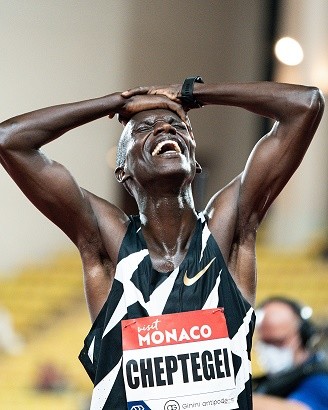
It was while at high school in 2012 I first dreamed of being a professional runner. But even later, once I started training full time, my passion for running has remained.
I’m at my happiest running the tempo runs. I love it. Those long speed sessions where you have to try to hold the same pace for a long time. It brings me immense joy – especially those sessions when you finish and you still feel like you can push some more.
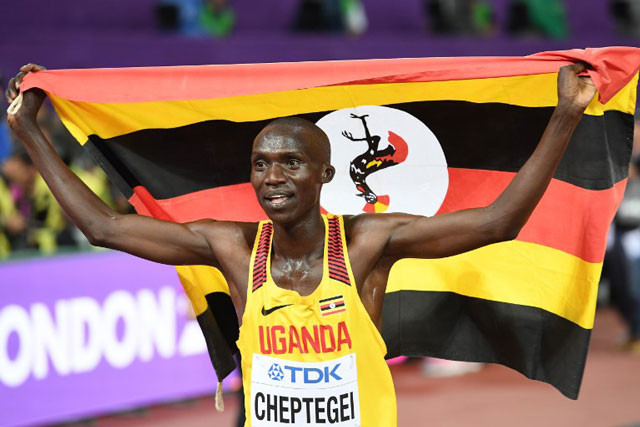
It is never a good day when, for whatever reason, I can’t run – especially if I’m injured or ill. I love to wake up every morning and go for a run.
I would say there is immense value in running. Success starts with a healthy body and a healthy mind, and when we run we are nourishing both. This will then allow us to be more productive and achieve our best results, no matter the profession.
Running brings with it great freedom and health. And even after I’m retired from professional athletics, I look forward to the thought of going for a run every day.
(07/24/2021) ⚡AMPby World Athletics
Aisha Praught-Leer will race in Tokyo despite serious knee injury
Aisha Praught-Leer, who trains with Team Bosshard in Boulder, Colo. alongside reigning steeplechase world champion Emma Coburn but who races for Jamaica, announced on Instagram today that she has sustained a meniscus tear to her left knee, which will require surgery as soon as she is finished competing in the 1,500m in Tokyo.
The athlete says felt the injury when it happened on Sunday while she was training near St. Moritz, Switzerland, in preparation for the Tokyo Games. She completed the workout, and had an MRI on Wednesday, which revealed a complete tear requiring surgery.

Praught-Leer says she will still travel to Tokyo to compete in the 1,500m on Sunday, and will have a couple of (entirely legal) procedures, including having fluid drained from her knee and a cortisone injection, to allow her to compete. But she acknowledges that she will not be able to perform as well as she hoped, given her situation.
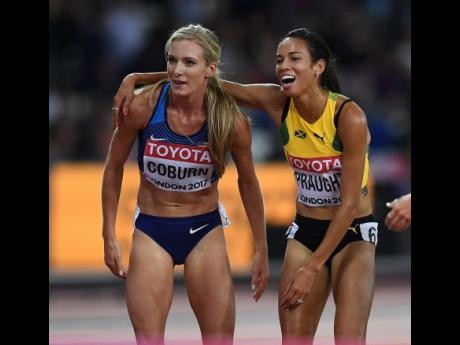
The meniscus is a C-shaped piece of cartilage that cushions the knee joint. Tears are relatively common in athletes.
Praught-Leer, 31, qualified for Tokyo 2020 on the basis of her world ranking (43rd), and this will be her second Olympics; she made the final of the 3,000m steeplechase in Rio in 2016, finishing 14th, and won gold in the event at the 2018 Commonwealth Games. Praught-Leer signed a sponsorship deal with Puma earlier this year.
(07/24/2021) ⚡AMPby Anne Francis
Tokyo 2020 Olympic Games
Fifty-six years after having organized the Olympic Games, the Japanese capital will be hosting a Summer edition for the second time, originally scheduled from July 24 to August 9, 2020, the games were postponed due to coronavirus outbreak, the postponed Tokyo Olympics will be held from July 23 to August 8 in 2021, according to the International Olympic Committee decision. ...
more...Bone Broth Can Strengthen Your Soft Tissues Against The Rigors of Running
This much-hyped superfood can strengthen your soft tissues against the rigors of running.
Dialing in your nutrition is as important as your training when it comes to powering your runs. So what runner wouldn’t appreciate a superfood that can give them an edge?

Bone broth has been hyped as a health elixir for years, and with good reason: It’s packed with ingredients that can strengthen your joints and ligaments, help you refuel, and aid in post-run recovery. But what is it, exactly?
“Bone broth is that liquid that’s left over after simmering animal bones and connective tissue (from chicken, beef, turkey, pig, or lamb) over heat,” says Sarah Schlichter, R.D.N., owner of Nutrition for Running. “It provides an array of nutrients, including electrolytes like sodium, magnesium and calcium, as well as Vitamin A, Vitamin K2, iron, zinc and omega-3 fatty acids, all of which are dependent on the animal marrow that’s simmered.”
Anyone can benefit from bone broth’s nutrient makeup, but runners have been swigging this stuff at aid stations in endurance events even before it went mainstream. (And Mets’ pitcher Noah Syndergaard, who underwent Tommy John surgery in March 2020, drinks it as well!) Here’s why.
How does bone broth help runners?
Bone broth’s main ingredient is collagen, says Katie Kissane, a registered dietitian at UCHealth in Colorado and owner of Fuel 2 Run.
“Since collagen is made of connective tissue and amino acids that are important in the building of our own joints and ligaments,” she explains, “it’s thought that taking collagen helps us strengthen these tissues.”
Running can be tough on your soft tissues and joints; a 10-minute mile, for example, consists of 1,700 steps, each one producing ground reaction forces about two and a half times your body weight. Collagen, which also contains an anti-inflammatory amino acid called glycine, says Kissane, can be a welcome nutrient in bulletproofing your body against some of that impact.
“While you can get collagen from your diet, those with a poor diet or who deal with constant injuries may want to consider additional collagen,” says Schlichter.
Athletes who supplemented with five grams of collagen peptides per day for 12 weeks saw a statistically significant improvement of activity-related joint pain, a 2017 study published in the Journal of Applied Physiology, Nutrition, Metabolism found; additional research published in the Journal of Clinical Nutrition that year found that consuming five to 15 grams of collagen resulted in an increase in collagen content and synthesis and improved mechanics.
There’s one catch: Bone broth may not provide the same consistent amounts of collagen as a collagen supplement would, according to a 2019 study published in the International Journal of Sport Nutrition and Exercise Metabolism. Still, “there's certainly no harm in adding bone broth to your diet and, if anything, you could see benefits and receive additional nutrients as a result,” says Schlichter.
How to incorporate bone broth into your everyday diet
Since bone broth is a liquid, it’s an easy add to any diet. You can use it as a base for soups or sauces, use it in your post-workout smoothies, and even drink it like hot tea.
To make your own bone broth, just place the animal bones of your choice (i.e. the leftovers from a roast chicken dinner) in a large pot with water and some spices of your choice—sea salt can boost the electrolyte benefits, for example—and simmer for 12 to 24 hours, says Schlichter. Some people also like to add other liquids for flavor, such as apple cider vinegar or coconut milk, she adds.
If that seems like too much of a time commitment (or out of your kitchen skills repertoire—no judgement!), there are plenty of bone broths you can pick up in grocery stores.
You don’t need to consume a lot in one go to get the benefits. Kissane suggests having somewhere around 10 to 20 grams per day—one to two cups. “About 10 grams is a standard dose,” she says.
The best time to have those cups would be before or ofter your workout. The naturally occurring electrolytes you get from bone broth—like sodium, potassium and magnesium—make it a solid hydration choice pre- or post-workout. Plus, it can contain various amounts of protein, which could help with decreasing muscle protein breakdown after a workout, says Schlicter.
Just don’t count it as part of your daily protein needs, says Kissane—“it’s not a complete protein, so it doesn’t contain all of the essential amino acids,” she explains. Instead, think about pairing it with another protein source and carbohydrates to enhance post-workout recovery.
Just remember, “as with anything, bone broth is not a cure-all or magical solution to a ‘healthy’ diet,” says Schlicter. If you’re looking to strengthen your muscles and connective tissues and boost your recovery, “habits and behaviors always count as well!”
(07/24/2021) ⚡AMPby Runner’s World
Timothy Olson (Probably) Just Nabbed the FKT on the PCT
After 2,652 miles, 400,000 feet in elevation gain, and more than 51 days, the ultrarunner finished his PCT thru-hike.
Fifty-two days, eight hours, and twenty-five minutes. As of Thursday evening, that’s the record Timothy Olson appears to have beat running from border to border, Mexico to Canada, on the Pacific Crest Trail. Once Olson’s own time is confirmed, he will have completed the PCT faster than anyone ever before. According to his Instagram account, his unconfirmed time is 51 days, 16 hours, and 55 minutes.
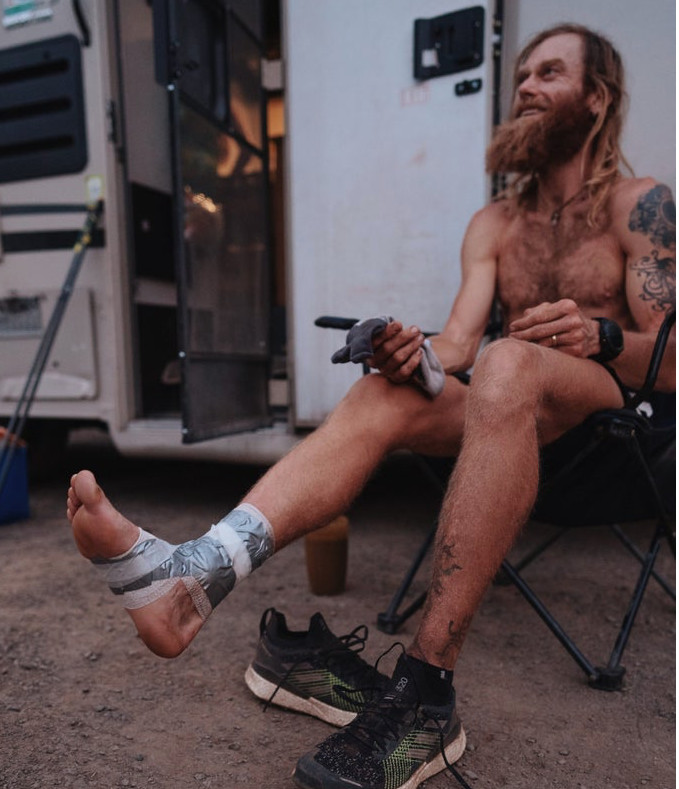

When Olson arrived at the northern terminus of the PCT at 10:48 P.M.on Thursday, he seemingly surpassed the record held by Karel Sabbe from Belgium since 2016. An FKT on the PCT, which winds through 2,652 miles of rugged mountain terrain in California, Oregon, and Washington, is one of the most prized speed records in thru-hiking and ultra-running. And for good reason: Olson averaged more than 50 miles a day for seven weeks straight for this record, often at alpine altitudes, gaining more than 400,000 feet in elevation. Not to mention another 400,000 feet of elevation loss.
Olson wore a GPS tracker for the length of his run, and once the data is confirmed, the official time will be released. (The complete tracker data has yet to be made public.) He started his journey in Campo, California, on June 1, which suggests he beat Sabbe’s time by less than 24 hours. The record comparison is complicated by the fact that trail adjustments, closures, and above all, seasonal wildfires, mean that the Pacific Crest Trail varies in route and length every year. This means that Olson, along with every thru-hiker, had to improvise: at least once, Olson ran up to a trail closure, turned around, ran back to a trailhead, and was driven to the other side of the closure. The extra added miles approximately equaled the distance of the closure, so even if Olson could not run every mile of the trail, he likely ran as many miles, if not slightly more.
Olson is not an amateur athlete, and this isn’t his first ultrarunning record. He once held the record for the Western States 100-Mile Endurance Run, which he won in 2012 and 2013. But running the PCT is a fundamentally different challenge, physically and logistically.
Many FKT attempts on the country’s “triple crown” of thru-hikes, which also includes the Appalachian Trail and the Continental Divide Trail, end in failure, often due to injury, inclement weather, or sheer exhaustion. Olson was supported by a team of seven following along in two RVs, rendezvousing with Olson as he passed through trailheads, and handling logistics like food and laundry. Most nights, Olson slept in an RV. But in several especially isolated sections, such as the Sierra Nevada, Olson spent the night alone, sleeping on the ground along the trail Sweetening the moment of victory for Olson is that his wife and fellow ultrarunner, Krista Olson, is eight months pregnant with their first daughter. “Each step of the journey, I am connected to my family,” Olson wrote on his Instagram as he ran through Snoqualmie Pass in Washington. Krista and both of his sons, Tristan, 8, and Kai, 5, were active members of his support team, meeting him at trailheads and assisting with logistics. Sometimes, his sons even joined him for brief sections of trail.
In addition to record-chasing, trail running has helped the Olsons cope with loss—in particular, two miscarriages they experienced before their current pregnancy. As part of the FKT attempt, they’ve been raising money for Return to Zero: H.O.P.E., a non-profit that supports families going through pregnancy loss or baby loss.
Thru-hiking the Pacific Crest Trail is an elite physical challenge, even at a normal pace. In 2019, the Pacific Crest Trail Association issued 5,441 thru-hike permits, and another 2,437 permits for section hikes. Of those, only 1,181 people self-reported as having completed the entire PCT. Typically, thru-hikers finish in five to six months, carrying their own food and gear, and sleeping in tents each night. Completing the trail in less than two months, and the logistics needed to make an FKT attempt possible, registers on an altogether different scale of magnitude.
“In a normal year, only around one-fifth of the people who set out to hike the entire PCT actually succeed,” says Scott Wilkinson of the Pacific Crest Trail Association. “To travel the entire trail in a single season is remarkable. To do it faster than anyone ever has? It’s mind-boggling.”
The number of thru-hikers grows each year, as does the number of competitive ultrarunners. For those reasons, Olson’s FKT attempt certainly won’t be the last. But for now, he can rest easy knowing that he is very likely the fastest known PCT thru-hiker of all-time.
(07/24/2021) ⚡AMPby Back Packer
2021 Badwater 135 Results: McRae Wins First Women’s Title, Lewis Gains Second Men’s Win
On Monday night, the 44th Badwater 135 Mile kicked off in Death Valley, California. In a field headlined by former male champs and women vying to become first-time winners, the first finishers rolled across the finish line at Whitney Portal, California on Tuesday night.
The race started in three waves at 8:00 p.m., 9:30 p.m., and 11:00 p.m Monday night, and the full field will cross the finish line before the 48-hour cutoff on Wednesday evening.
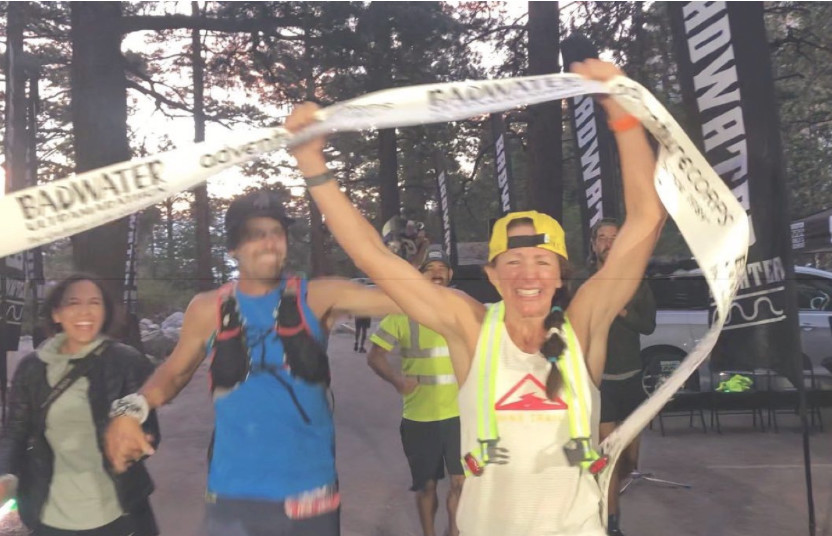
The Badwater 135 covers three mountain ranges for a total of 14,600 feet (4,450 meters) of cumulative vertical ascent and 6,100 feet (1,859 meters) of cumulative descent. Course conditions figured to be especially severe this year, as heat waves continue to rake the American West. As I write this sentence, the heat index in Death Valley is 117 degrees Fahrenheit; at Whitney Portal, it’s 100 degrees.
2021 Badwater 135 Men’s Race
In a field stacked with previous race winners, 45-year-old Harvey Lewis pulled off his second Badwater 135 victory. The Ohioan spent most of the race in a three-man weave with Ukrainian Igor Gotsuliak and Russian Sergey Ionov, who took second and third respectively. Lewis checked in almost an hour behind Gotsuliak for the lead at mile 90 but blistered past the Ukrainian to take a one-hour lead by mile 122. He’d previously won the event in 2014, and this was his 10th finish and fifth podium.
The lead pack distanced itself from a loaded field. In addition to Lewis, three other Badwater winners returned in 2021 with four total gold medals between them. Michele Graglia won in 2018, Pete Kostelnick won in 2015 and 2016, and Oswaldo Lopez won in 2011. Kostelnick was especially hot in 2016 when he set the men’s 20-29 age-group record with a 21:56:32. However, he didn’t finish in 2021, dropping out between miles 90 and 122. Graglia was also a DNF. And Lopez finished this year’s event in 10th place with a time of 31:46:04.
2021 Badwater 135 Men’s Results
1. Harvey Lewis – 25:50:23
2. Igor Gotsuliak (Ukraine) – 26:35:08
3. Sergey Ionov (Russia) – 26:49:06
4. Kenneth Ringled – 28:56:37
5. Mark Wooten – 29:39:02
76-Year-Old Attempts to Break Age Record
Notably, Bob Becker aimed to become the oldest competitor ever to finish, at 76. Jack Denness set the current record with a 59-hour push at age 75 in 2010. Becker’s bid fell short — word from the course was that he retired from the race around mile 50 with physical issues; the results mark him as a DNF.
2021 Badwater 135 Women’s Race
In her first return to the Badwater 135 since a seventh-place finish in 2018, Sally McRae took the women’s field in 30:48:47. After McRae overtook and distanced herself from then-leader Suzi Swinehart midway, she left little reason to doubt she would win, finishing two hours and 49 minutes ahead of Norma Roberts in second place. Swinehart ultimately took third, improving on her sixth-place finish in the 2019 race. Caryn Lubetsky finished in fourth place, just a half hour behind third-place Roberts. And Jessica Hardy was 2021’s fifth-place woman.
Other notables included 2019’s third-place finisher Lisa DeVona, who was laboring at the middle/back of the pack at the time of publication.
2021 Badwater 135 Women’s Results
1. Sally McRae – 30:48:47
2. Norma Roberts (Canada) – 33:37:49
3. Suzi Swinehart – 34:24:33
4. Caryn Lubetsky – 34:56:11
5. Jessica Hardy – 35:56:47
(07/24/2021) ⚡AMPWhen Their Training Spot Got Turned Into a Vaccination Site, These National Champions Trained in Their School Hallways
The team from the Bronx normally trains at the Armory, which was converted to a COVID-19 vaccination site.
Less than a mile from Yankee Stadium in the Bronx sits Cardinal Hayes High School, an all-boys Catholic school that can now call itself track and field national champions. Earlier this month, the 4x200-meter relay team, anchored by Travis Williams, 18, won a national championship for the event and set a Hayward Field facility high school record of 1:26:36.
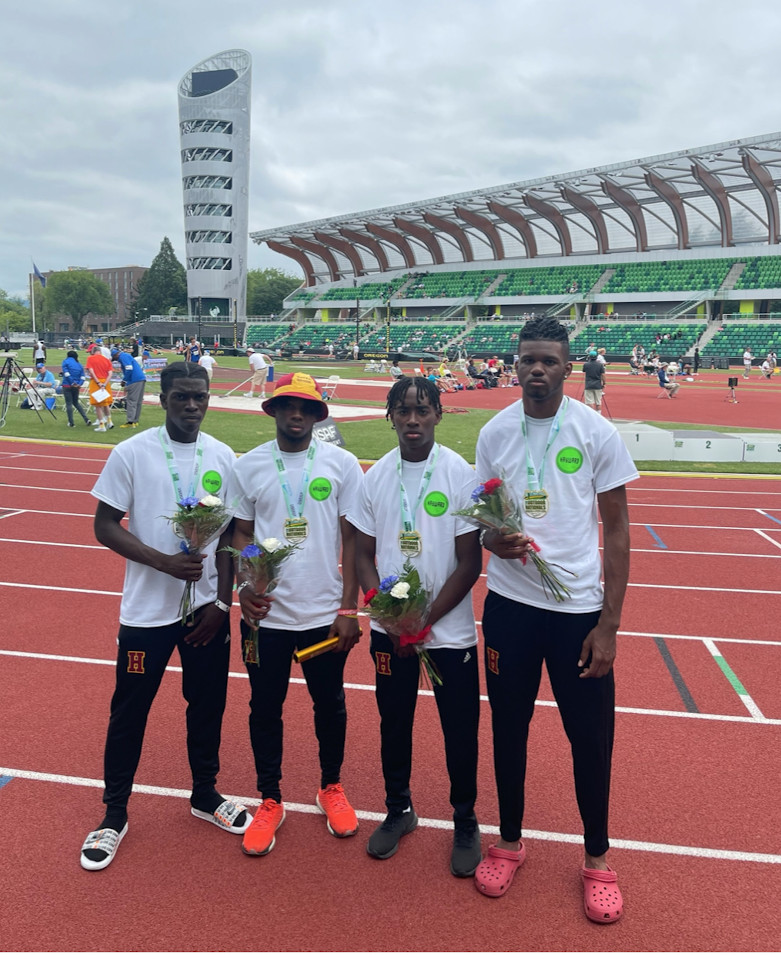
“This was a once-in-a-lifetime experience,” Tavon Williams, 18 (no relation to Travis), told Runner’s World. “I was walking around, looking at people run, knowing that Olympians ran on that track [at the U.S. Olympic Track and Field Trials in June]. My little brother came with me, and it was good to see him watch me medal and run fast.”
The team—coached by Cardinal Hayes alumnus, Craig Joseph—includes Jaavier Jackson, 17, Tavon Williams, 18, Jaden Barrett, 18, Travis Williams, 18, and alternate Kenneth Maxwell, 17.
→ Join Runner’s World+ to get the latest running news, training tips, and exclusive workouts!
The squad was up against the best high school runners in the world, and it wasn’t until the race’s second leg—Tavon—did the team start to smell victory.
“I realized we were going to win when I was seeing how Tavon was able to accelerate, put us into first place, and then maintain that position,” Jackson, who ran the first leg, told Runner’s World. “There were a lot of obstacles, but once I saw my teammates take over and extend, I felt a lot more confident.”
Travis called the moment he crossed the finish line in first place surreal.
“We accomplished a goal at the end of our season, and it was life-changing,” he told Runner’s World. “COVID struck [last year] and we had to make do with what we had. We did our best and came out national champs.”
To say that the COVID-19 pandemic put up roadblocks in every aspect of life would be an understatement. For the Cardinal Hayes track team, the pandemic took away not only the spring 2020 track season but also its winter training facility: the Armory in Washington Heights.
“We normally have access to the Armory twice a week, but this year, it was a vaccination center and it wasn’t available,” Joseph says.
So, the team took to the hallways of the high school.
The workouts varied—30, 60, 200-meter sprints—but were limited by the length of the halls, sharp turns, and slippery surfaces.
“Sometimes we’d get crazy and run 350s [meters],” Travis says. “We’d do anything we could with the little space we’ve got, but it was really hard to run around the curves at our speed.”
Not to mention, the toll running on hallway surfaces can take on the body.
“Being in the hallways four to five days a week was very challenging,” Joseph says. “We had to manage contact time.”
Plus, Maxwell says, sprinting in a hallway doesn’t translate to a track. But there weren’t other options in the northeast winter.
With a national championship under its belt, the Cardinal Hayes track team is already looking ahead to the next season. Three of the five team members—Barrett, Travis, and Maxwell—will attend college this fall. Barrett will play wide receiver at Wagner College on a football scholarship, Travis will run track at the University of Albany, and Maxwell will run track at Fordham University.
That leaves room for up-and-comers to defend the 4x200-meter title.
But Joseph, who’s been coaching at Cardinal Hayes for 17 years, knows nothing is guaranteed.
“Every year I go into the season with my seniors and say, “It’s your turn. The bar was set last year. How high are you going to raise it?’” Joseph told Runner’s World. “Well, this is a pretty high bar. You can’t go any higher. So next year, we’ll come in and set the bar again. The standard has to be to continue to elevate.”
His athletes know this.
“They’re looking at us. Like, we up there now. We’re number one in the nation,” Tavon said. “Hopefully we go back for another one.”
(07/24/2021) ⚡AMPby Runner’s World
Betsy Riley and NBC's Olympics Production Team Are to Thank for the Peaking Track Coverage
The network’s Olympics production team is peaking at the right time—thanks, in part, to Betsy Riley, its first female producer.
Track and field reporter Lewis Johnson is live on NBC during the third day of the Olympic Track Trials in Eugene, Oregon—and he’s perched on the steeplechase barrier in front of the water jump.
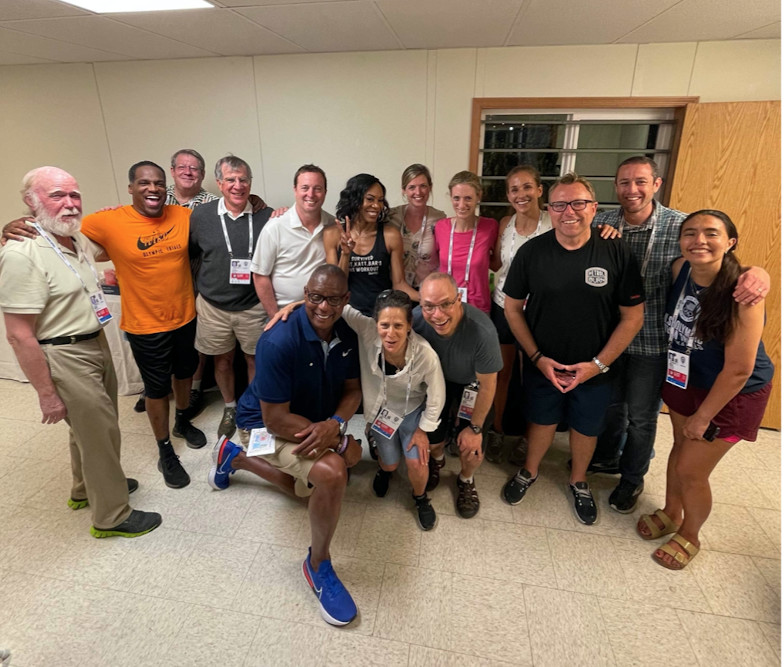

He explains the origins of the event, from the 1800s in England. Graphics flash on the screen, showing the specifics of the modern-day version of the steeplechase, 28 barriers over a 1.86-mile race. Johnson describes how the barriers don’t move as he tries, unsuccessfully, to hip check the one he was just sitting on.
Then the segment takes a whimsical turn. He walks around to the water side of the jump, kicks off a pair of green Nikes, and wades in. “Oh, that feels so good, Diff,” he says, talking to Leigh Diffey, the lead announcer at the Trials.
As Johnson gets to the deepest portion of the pit, the water is lapping at the bottom of his khaki shorts. He sits down at the edge. “Throw me a towel, man,” he says, before the broadcast cuts to the 17 women lined up at the start of the first heat of the women’s steeplechase.
It’s effective television: In one minute and 17 seconds, the segment has entertained and informed viewers—those who might not know the first thing about one of track’s quirkiest events as well as those who understand the basics of steeple but have never gotten close.
The idea for the segment? That came from the Trials producer, Betsy Riley.
Riley has implemented dozens of changes to NBC’s track broadcasts. Some are obvious improvements, like bringing on two-time Olympian Kara Goucher as a commentator, or using double boxes to keep a camera focused on track action during commercials. Others are behind-the-scenes, out of sight of viewers, but which contribute to better coverage.
The result is that long-suffering track fans, who for decades from their recliners have made a secondary sport of complaining about the way track is aired, suddenly find themselves with little to carp about. In fact, anecdotally at least, they’re happy to tune in, whether it’s on their TVs or phones or tablets, and watch running and field events.
That’s largely because Riley is one of them, a true believer and competitor with a lifelong love of track and field.
A pair of firsts
Riley will make TV history this month when she becomes the first woman to produce track and field at an Olympics for NBC. Network brass plan their coverage of the summer Games around swimming, gymnastics, and track—these three disciplines are the “tentpoles” that anchor the coverage—and in fact, Riley is the first woman to produce any of the sports for NBC at the Games.
“We’re so proud of her,” said Molly Solomon, who is the executive producer for the summer Games, also a first for a woman at NBC. “The fact that she’s producing an ‘A’ venue, track and field, at the Olympics, one of the big three. It’s a huge accomplishment.”
But Riley brushes this aside. While other people are making a big deal out of it, she is not, deflecting attention to the great role models she’s had at NBC, including Solomon, and the team of experts she has around her.
A pair of firsts
Riley will make TV history this month when she becomes the first woman to produce track and field at an Olympics for NBC. Network brass plan their coverage of the summer Games around swimming, gymnastics, and track—these three disciplines are the “tentpoles” that anchor the coverage—and in fact, Riley is the first woman to produce any of the sports for NBC at the Games.
“We’re so proud of her,” said Molly Solomon, who is the executive producer for the summer Games, also a first for a woman at NBC. “The fact that she’s producing an ‘A’ venue, track and field, at the Olympics, one of the big three. It’s a huge accomplishment.”
But Riley brushes this aside. While other people are making a big deal out of it, she is not, deflecting attention to the great role models she’s had at NBC, including Solomon, and the team of experts she has around her.
From there, she raised her hand for anything, filling any role, on coverage of surfing, golf, horse racing, college football, college basketball. And always the Olympics and Olympic sports. These days, she’s also Michele Tafoya’s sideline producer on Sunday Night Football.
Amid the long hours that TV requires, Riley met her husband and got married, and they have two children, ages 4 and 1 1/2. In a year when talk of mothers and motherhood has dominated track and field, Riley has her own story to rival them all.
It was 2017, she was 35 weeks pregnant, and she had just finished producing the Prefontaine Classic, a Diamond League track meet in Eugene. On her flight home to Baltimore, somewhere over the Midwest, her water broke. When the plane landed, she took a cab straight to the hospital, and met her husband there. A few hours later, they welcomed a son—who had jumped the gun by more than a month.
Infinite possibilities
Track and field is among the most complex sports to broadcast, and Riley strives to replicate for viewers at home an experience that would be similar to what happens when spectators are watching live, in the stadium. They can choose to watch running on the track or look to the infield for one or more field events happening simultaneously. How do you get that same sense of the action on screen?
On June 26, the penultimate day of Trials competition, Riley sits in the cramped NBC production truck, staring at 30 different screens displaying various camera angles. On her headset she hears the voices of seven on-air commentators. Riley has field events producer Scott Karpen a few feet to her left and director Charlie Dammeyer inches to her right, so close you could barely hold a discus between them. A countdown until the live show begins. Four minutes. Two minutes.
Into her headset, Riley says in a low voice, “Have a great one, everyone.”
From there, Riley is making constant decisions for the next two hours from an infinite combination of elements: which replays to show, when to air a graphic, when to go to a field events package on the women’s hammer throw that happened earlier in the evening, how much time to devote to Sydney McLaughlin walking toward the track while leaving Diffey enough time to voice the element.
Riley, Dammeyer, and Karpen trust one another completely, which makes Riley’s job easier as she decides which family members and coaches to show, when to go to live interviews with happy athletes who just made the Olympic team (and what to do when one lets an expletive slip, as Elle Purrier St. Pierre did after winning the 1500 meters). Karpen describes the role of producer as “the ultimate multitasking job.”
Her background helped make Riley great, observers say, because she grew up in sports television, filling every position, from the entry level production associate calling graphics to working in the videotape area to being in charge of the tape area. She’s been in the front of the truck as the associate director who assists the director and producer in timing.
“If you do those jobs, when you are promoted to producer, you understand what everyone is doing,” Solomon said. “You understand what they need from their leader. You can synthesize all of it. It’s an amazing skill, but you can have six voices in your headset and hear the right ones at the right time. It’s orchestrated chaos.”
A different person might be ruffled by the pressure, but Riley’s steady demeanor is one of her hallmarks.
“I always admire her measured style in the heat of battle,” Solomon said. “She’s very calm, cool, and collected, but she knows what she wants, and she’s direct. That’s what makes great producers—to have a clear head in the middle of the chaos and be able to communicate to the team and lead the team.”
Riley says her faith in the people around her makes it easy. “Our team is incredible,” she said. “It doesn’t happen without every single person contributing, sharing ideas and then pulling in the same direction when we’re on air. In any successful broadcast, you have great teamwork.”
But she has trouble explaining what is going on in her brain during broadcasts, synthesizing all the camera angles and voices, making scores of journalistic decisions every minute. All she can say is that she’s constantly evaluating: What’s the most important right now?
Building team chemistry
None of it happens by accident. Every live broadcast is the result of months of brainstorming, testing, planning, and coaching.
“People at home see the ultimate product,” Karpen explains. “They don’t see the months and years and hours of thought and time she’s put into this. Nothing happens overnight. It’s because Betsy was somewhere in the world thinking, ‘How can we get better?’ And pushing people to think about this. It’s not show up and let’s make TV. This is hours and years to get to that one moment.”
Riley is known for listening at meetings, soliciting input from anyone who wants to contribute, giving serious consideration to all ideas.
“One thing I absolutely respect about her is that nothing is a bad idea,” Dammeyer said. “Ideas come from everywhere. She’s asking everyone, ‘What do you think?’ Everyone has a seat at the table, from Ato [Boldon] to Leigh to the graphics production assistant. Everybody’s voice counts.”
When Goucher first started doing on-air commentary for NBC this spring, Riley gave her extra coaching sessions, telling her what she was doing well and what she needed to improve. On the live broadcast, Riley is in Goucher’s ear.
Goucher remembers watching Abbey Cooper pull away in the early laps of the first round of the women’s 5,000 meters, trying to get the Olympic standard on her own in the Eugene heat. “I was like, ‘This is crazy.’ Betsy was in my ear. ‘Why is this hard? Tell the audience why this is hard.’ She gives me little cues.”
Goucher has been one of the revelations of the track season—a hit with viewers for the passion she brings and the insights she shares, gleaned from her own career as an athlete. But nothing motivates her as much as her producer’s live coaching. “If I do something that she likes, she says, ‘Well done.’ She’ll give you a little feedback as you’re going, which I find super helpful.”
Which isn’t to say that it’s always roses. Boldon has been working NBC broadcasts for 14 years. In 2019, around the time of the Prefontaine Classic, he and the other commentators and members of the production team were summoned to a meeting.
“You know how when a team is playing really badly and you have a players-only meeting?” he said. “Right. We had one of those. The chemistry wasn’t right, the flow wasn’t right. It was watching a team of really good players play badly because they can’t play with each other.”
In Boldon’s telling, Riley led the meeting and didn’t mince words with her assessment of what needed to improve. The message? “Swimming and gymnastics get the baton and we have to bring it home for NBC,” Boldon said. “Everyone in that room was as serious as a heart attack. She came with receipts. She came with video—she had put together a whole package. ‘Look at this. What’s wrong with this? Can we do better here?’”
It was a turning point. “I think the broadcast we did from the Eugene Trials was the best Trials broadcast I’ve ever been a part of,” he said.
A network’s core values
NBC coverage—no matter who the producer is—focuses on two things, according to Riley. First, getting the sport right. And second, storytelling.
“Sometimes people think of storytelling as a soft human interest story, and that’s possible, but it’s also storytelling about the race itself and the athletic event itself,” Riley said. “Storytelling is part of everything we do at the Olympics.”
Donavan Brazier in a feature about fly fishing before the men’s 800 final? That’s storytelling. Lewis Johnson wading into the water jump pit? Also storytelling. But most important is the race itself. Replays that show Dalilah Muhammad getting out to a fast start in the women’s 400-meter hurdles, or Cole Hocker’s kick to win the men’s 1500 meters are, at their core, about storytelling.
The goal of every sports broadcast is to make the viewer care about who they’re watching. Riley understands this, and she’s not afraid to push the envelope with technology to help viewers better understand track and field.
During the Trials, fans of the distance races rejoiced at coverage that continued through commercials with double boxes. It’s a feature that’s been around for five years, Riley said, but its use is expected now.
“Sponsors are noticing that it’s nice to have action, it’s nice to have people sticking around for those commercials,” she said. “Early on there was definitely an effort to showcase the value of it. Now that we’re five years on, people know that’s expected and what track fans really want.”
Riley has been experimenting with other forms of technology—miles per hour graphics and live leaderboards that show how many meters behind athletes are from the leader. The point, always, is to give the viewer at home deeper understanding.
Heading to Tokyo
On the NBC broadcast in primetime, Riley and her team will make sure track and field is accessible for those who tune into the sport only once every four years. Boldon says Riley has pushed him not to rely on statistics and times. Instead, she’ll be in his ear during broadcasts, urging him along to find a different way to tell stories. “Make me care,” she’ll say. “Make me care.”
But changing technology allows viewers to customize what they see. If hardcore triple jump fans want to watch every minute of triple jump or discus from Tokyo, and not just a highlights package, that’s possible with the cable channels and digital streams.
And that means as the broadcast team heads for Tokyo, they’ve got hours and hours of work ahead of them. For 10 straight days, July 30 to August 8, Riley and the team will be at it, documenting the performances and the emotions they inspire.
“For the TV dorks like we are, our team relishes the opportunity to do lots of TV and cover lots of competition,” Riley said. “That’s really fun stuff.”
(07/24/2021) ⚡AMPby Runner’s World
Tokyo Olympics preview: marathon-Women's marathon
World record-holder Brigid Kosgei will start as the woman to beat in the marathon when she hits the road on the Games' penultimate day. But she won’t be lacking for formidable opposition.
The 27-year-old Kenyan has been among the best marathon runners on the planet since 2017 when she first threatened the 2:20 barrier at that year's Chicago Marathon, finishing second in 2:20:22. She returned the following year to take the title in 2:18:35 and then returned again in 2019 to smash the world record with a jaw-dropping 2:14:04 performance.
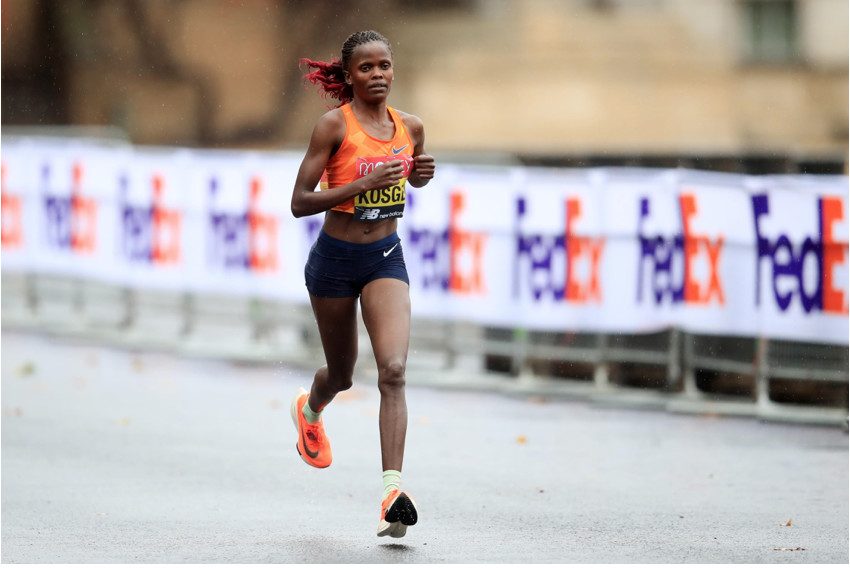
She followed up well with a successful title defence at the London Marathon last October in 2:18:58, winning by more than three minutes to secure her fourth consecutive marathon victory.
Kosgei hasn't contested the distance since and has only raced twice in 2021, so her current form will be somewhat of a mystery. This will also be the first time she has competed at a major championship. Given her marathon pedigree, though, you can expect her to arrive in Sapporo well prepared.
But she'll have plenty of fast company, beginning with her teammates.
Peres Jepchirchir, the two-time world half marathon champion, heads to her first Olympics courtesy of her 2:17:16 victory at the Valencia Marathon last December, the fastest in the world last year. Just over a month earlier, she broke the half marathon world record for a women-only race, clocking 1:05:16 at the World Half Marathon Championships.
They'll also have Ruth Chepngetich, the world champion, for company. Chepngetich clocked 2:17:08 in Dubai in 2019 that currently places her fourth on the world all-time list. After a third-place finish at the London Marathon last October in 2:22:05, Chepngetich returned to action at the Istanbul Half Marathon earlier this year when she broke the world record in a mixed race, clocking 1:04:02.
That Kenyan trio is about as good as they come. But the Ethiopian team isn't too far off that mark.
Birhane Dibaba clocked 2:18:35 to finish second in Tokyo last year, one of the fastest performances of 2020. Teammate Roza Dereje was even faster a few months earlier, clocking 2:18:30 in Valencia in December 2019. Zeineba Yimer, 23, is another rising star, clocking 2:19:28 and 2:19:54 at the 2019 and 2020 editions of the Valencia Marathon.
Expect Israeli record-holder Lonah Salpeter to be in the hunt. The 32-year-old broke into the all-time top-10 after a sensational 2:17:45 run to win the 2020 Tokyo Marathon and has tuned up with a solid but pressure-free 2:22:37 run at home in March.
Helalia Johannes of Namibia, the surprise bronze medallist at the 2019 World Championships, also made a notable jump last year into the sub-2:20 club, finishing third in Valencia in 2:19:52. She'll turn 41 the week after the Olympics ends and is showing few signs of slowing down. Winner of the Commonwealth title in 2018, Johannes excels in championship races held in hot conditions.
Japan will be well represented by a pair of consistent runners who could be ready to challenge for the podium. Mao Ichiyama has a 2:20:29 lifetime best from her victory at the 2020 Nagoya Marathon and was nearly as fast the following year when winning in Osaka in 2:21:11. Meanwhile, Mizuki Matsuda clocked 2:21:47 to win the Osaka Marathon in 2020 and 2:21:51 to win Nagoya earlier this year.
(07/24/2021) ⚡AMPby World Athletics
Tokyo Olympics preview: Mens marathon
Five years ago, marathon world record-holder Eliud Kipchoge was the last champion crowned at the Olympic Games in Rio. He'll be aiming to replicate that achievement in Sapporo on 8 August, the final day of the postponed Tokyo 2020 Games.
Successfully defending any title over the marathon distance is no easy task. Only two runners have managed the feat at the Olympics: 1960 and 1964 champion Abebe Bikila of Ethiopia and East German Waldemar Cierpinski, the winner in Montreal in 1976 and Moscow in 1980. Over the course of his career, Kipchoge has arguably achieved more than both of those legendary marathoners: he's broken the world record, which currently stands at 2:01:39, and pieced together a 10-race unbeaten streak over a five-year stretch which included victories at most of the world's most prestigious races, a record unparalleled in modern marathon running.
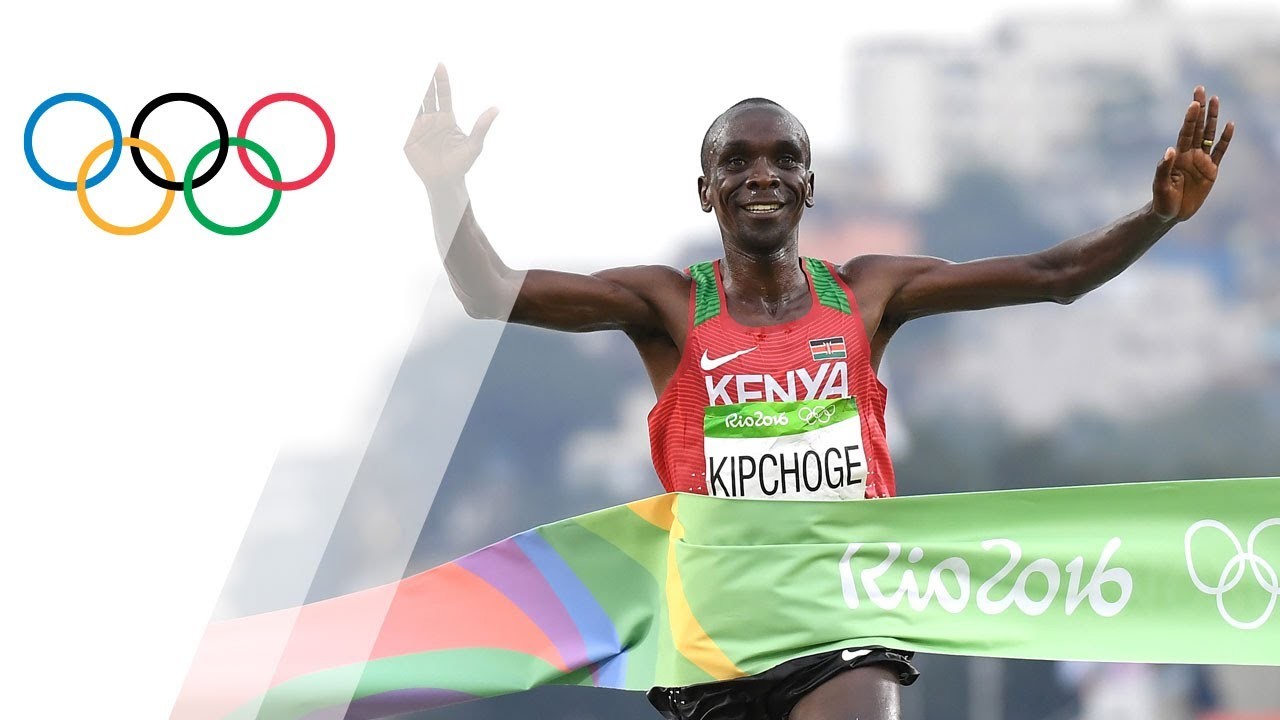
That streak finally came to a halt at the London Marathon in 2020, where he finished eighth in 2:06:49, the slowest marathon of his career. But he bounced back in April, winning in Enschede in 2:04:30. Four men have run faster this year in a season still battered by pandemic cancellations, but it was nonetheless a performance which illustrated that Kipchoge is fully capable of winning, even at 36. Indeed, he's widely considered a grand old man of the distance these days, a characterisation that certainly fits at this year's Games when only 11 of the 115 entrants are older.
Picking favourites in a marathon is difficult at the best of times. Throw a pandemic into the picture that ravaged the road racing season over the past 16 months, and it becomes a near impossible task.
That said, Kipchoge can expect a strong challenge from the Ethiopian squad, led by world champion Lelisa Desisa, Shura Kitata and Sisay Lemma. Desisa hasn't run under 2:06 since 2018 but his performance in Doha's difficult conditions in 2019 bodes well for a mid-summer marathon that is also expected to endure warm temperatures. Kitata won the London race that ended Kipchoge's streak, clocking 2:05:41, while Lemma has raced well in recent big city marathons, finishing third in both Berlin in 2019 (2:03:36) and Tokyo (2:04:51) in 2020.
But both of Kipchoge's teammates have run faster more recently, suggesting ambitions to claim more than one podium spot. Lawrence Cherono and Amos Korir earned their spots after finishing second and fourth at last year's Valencia Marathon in 2:03:04 and 2:03:30, respectively, the second and fourth fastest times of 2020.
Stephen Kiprotich, the 2012 Olympic champion and 2013 world champion, leads the Ugandan squad, returning for another shot after a 14th-place finish in Rio. But his most recent top-two finish dates back to 2017 when was second in Fukuoka so Ugandans will have higher hopes for Felix Chemonges, who has a 2:05:12 lifetime best from the 2019 Toronto Marathon, and Fred Musobo, whose 2:06:56 best was set in Daegu in 2019.
Belgian Bashir Abdi could also be factor. The 32-year-old improved his national record to 2:04:20 at the Tokyo Marathon last year. Other notables include Galen Rupp, the 2016 bronze medallist, who earned his return ticket after his victory at the US trials in Atlanta in February last year.
The marathon-mad host nation's hopes lie with Suguru Osako, who broke his own national record with a 2:05:29 run at the Tokyo Marathon in 2020, finishing fourth. He'll be joined by Marathon Grand Championships winner Shogo Nakamura and Yuma Hattori who has a 2:07:27 PB from 2018.
The field also includes Tachlowini Gabriyesos, a 23-year-old Eritrean native who clocked 2:10:55 at the Hahula Galilee Marathon on 14 March to become the first refugee athlete to better an Olympic qualifying standard.
(07/24/2021) ⚡AMPby World Athletics
Ankle injury rules out Kenya's Geoffrey Kamworor at Olympics
Kenyan 10,000 meters runner and 2019 New York Marathon winner Geoffrey Kamworor has pulled out of the Tokyo Olympics due to an ankle injury, he told BBC Sport Africa on Thursday.
The 28-year-old is a three times world Half Marathon champion, and previous world record holder, and had hopes of a medal in the 10,000m after winning the national trials.
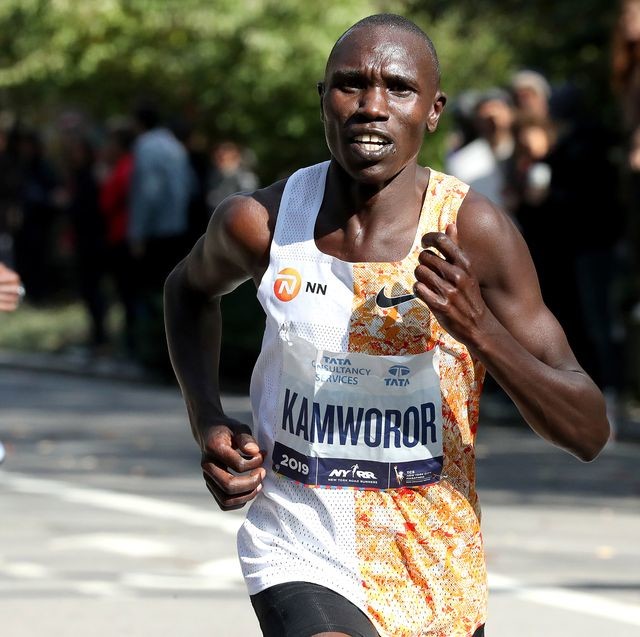
He won silver at the 2015 world championships in Beijing, behind Britain's Mo Farah.
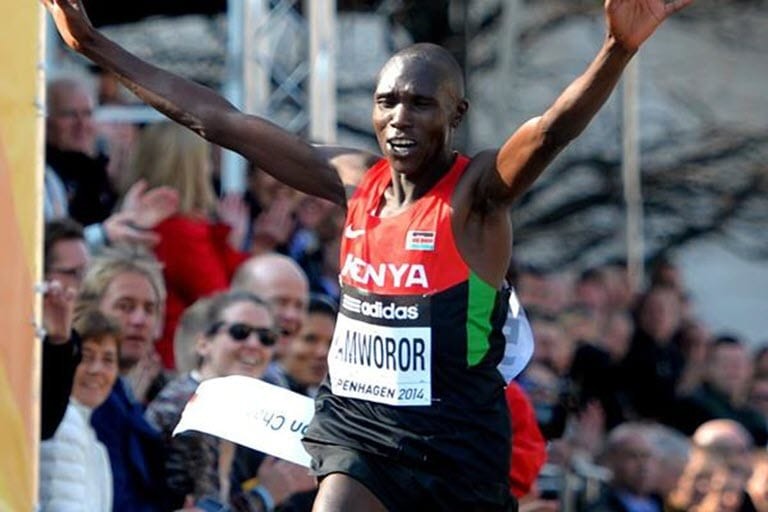
The injury comes after he was hit by a motorcycle while training near his home in June last year, suffering a fractured tibia.
"These are obstacles which can come on your way when you come back from a tough injury earlier on. It's only now extremely bad timing," the BBC quoted his manager Valentijn Trouw as saying.
(07/23/2021) ⚡AMPby CNA Sports
Tokyo 2020 Olympic Games
Fifty-six years after having organized the Olympic Games, the Japanese capital will be hosting a Summer edition for the second time, originally scheduled from July 24 to August 9, 2020, the games were postponed due to coronavirus outbreak, the postponed Tokyo Olympics will be held from July 23 to August 8 in 2021, according to the International Olympic Committee decision. ...
more...Setting a good running goal can keep you motivated and engaged with your training plan
Setting goals is a really great way to stay motivated and on track with your training, but they can actually have a negative impact on your progress if you don’t choose them wisely. Set a goal that’s too easy and you won’t see improvement, set a goal that’s too hard and you’ll lose your motivation. Check out these tips for choosing a running goal that’s appropriate for your experience and ability, so you can continue to get excited about running and continue to progress.
New to running? Start short-term
It can be hard to know what an appropriate goal should be when you’ve just started, so don’t be afraid to start small and change your goal as you get better. In fact, this is the time during your running life when your goal will likely be changing the most frequently. This is also the time when you’re the most likely to give up your running routine, so choosing an appropriate goal that’s achievable in the short term is crucial. Try setting a new goal each week, for example, “this week I’m going to run for 20 minutes on Monday, Wednesday and Saturday.” Once you’ve accomplished that, you can adjust your goal the following week to “this week, I’m going to run for 25 minutes on Monday, Wednesday and Saturday.” Focusing on one week at a time prevents running from feeling overwhelming, and before you know it, several weeks or months will have gone by when you’ve been running.
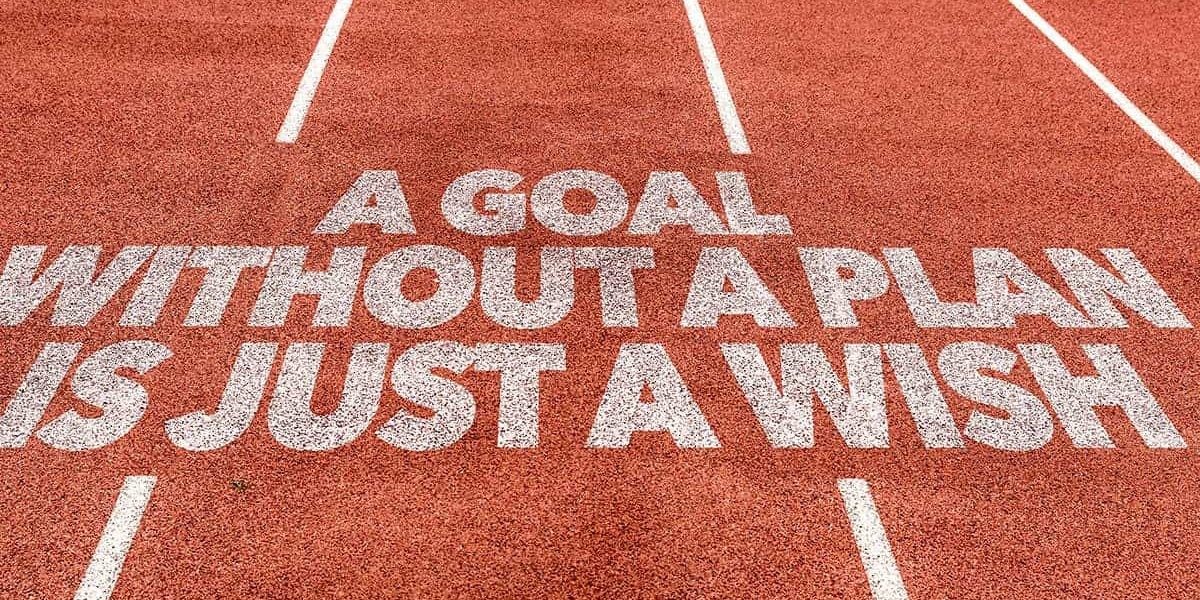
Have more than one goal

If you’re goal-setting for a longer period (for example, an entire year or for the fall racing season), having a good, better and best goal can take the pressure off just having one. The “good” goal should be something that is definitely in your reach. The “better” goal is the next step up from there, once you’ve achieved your first goal. The “best” goal is your best-case scenario, if-everything-goes-amazing goal. For example, if you’re training for your first marathon, your good goal may be to simply get to the finish line, your better goal may be to finish in under five hours, and your best goal may be to finish in under 4:30. Don’t be afraid to shoot for the moon with that third goal — it is, after all, your best-case scenario.
Don’t be afraid to adapt
Things happen and sometimes even the best-laid plans get ruined. If something happens (like an injury, a difficult life event, etc.) that makes it impossible to achieve the goals you originally set for yourself, it’s normal to be upset. While it is disappointing to have to abandon your goals, they’ll likely still be there when the time is right, so for now, adapt them to your situation. For example, if you were training to qualify for the Boston Marathon but got injured part-way through, make it your new goal to do everything your physiotherapist says, rehab your injury and come back stronger next time.
Get a coach
It can be challenging to look at ourselves objectively in order to determine what’s an appropriate goal for us and what’s not. This is where a good coach can be really helpful. This person will be able to watch how you progress throughout your training and figure out goals that will challenge you, but that won’t be unachievable.
(07/23/2021) ⚡AMPby Brittany Hambleton
Seattle Rock ‘n’ Roll Marathon cancelled for 2021
Put your running shoes and guitars away. The Seattle Rock ‘n’ Roll Marathon has been cancelled.
The organization notified Seattle participants of the cancellation in an email Wednesday, citing constraints with “local law enforcement resources and the strain any additional events could have in negatively affecting the community.”
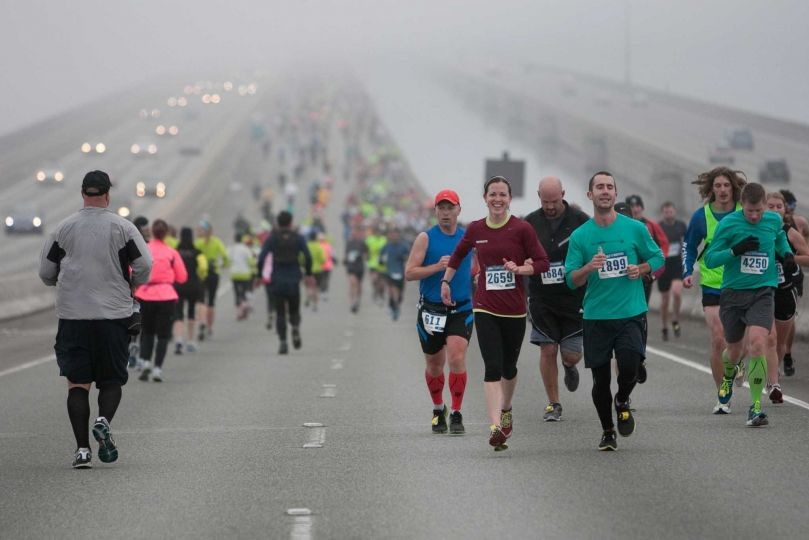
The next Rock ‘n’ Roll Marathon in Seattle is slated for June 12, 2022.
“This is certainly not the news any of us wanted and we recognize that this latest setback is a significant disappointment after multiple event updates,” the organization wrote.
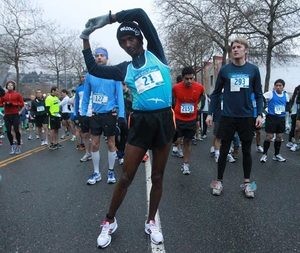
The 2020 Rock ‘n’ Roll Marathon, which local rap legend Sir Mix-A-Lot was slated to headline, was delayed due to the pandemic. This year’s event was initially scheduled for June 12-13 before it was postponed to Aug 21-22.
There is no refund option.
Anyone registered for the Seattle 2021 Rock ‘n’ Roll running series will be automatically registered for the 2022 event. Participants can also transfer their registration for a different event or location by Aug. 4.
Other Rock ‘n’ Roll events are currently scheduled to be held this year in Virginia Beach, Virginia; San Jose, California; San Diego; Savannah, Georgia; San Antonio; Nashville, Tennessee; and Washington, D.C.
(07/23/2021) ⚡AMPby Amanda Zhou
Rock 'n' Roll Seattle
Seattle is such a fun city and one that we love coming back to year after year,” said Lyndsi Weichert, Event Manager. “This race is a great way for participants to see Seattle’s famous sights and beautiful scenery as they take on their 13.1 or 26.2 mile journey. We encourage all runners to grab a friend, start training and sign...
more...All eyes were on the Tokyo's Olympic Stadium, 69 athletes from the sport of athletics were among the flag bearers when the Opening Ceremony of the Olympic Games Tokyo 2020 got under way
For the first time, each nation can be represented by two flag bearers, with 38 women and 31 men leading their nations before going on to compete in athletics at the Games.
A number of these athletes could also make history for their country when athletics action begins on 30 July and here are some of the stars to watch out for.
Hugues Fabrice Zango, triple jump - Burkina Faso

Zango became the first athlete from his nation to win a World Championships medal thanks to his third place in Doha and now he could become the first person from Burkina Faso to win an Olympic medal in any sport. The 27-year-old broke the world indoor triple jump record of 18.07m in Aubiere in January and has also leapt a PB of 17.82m outdoors this year.
Shelly-Ann Fraser-Pryce, 100m, 200m and 4x100m - Jamaica
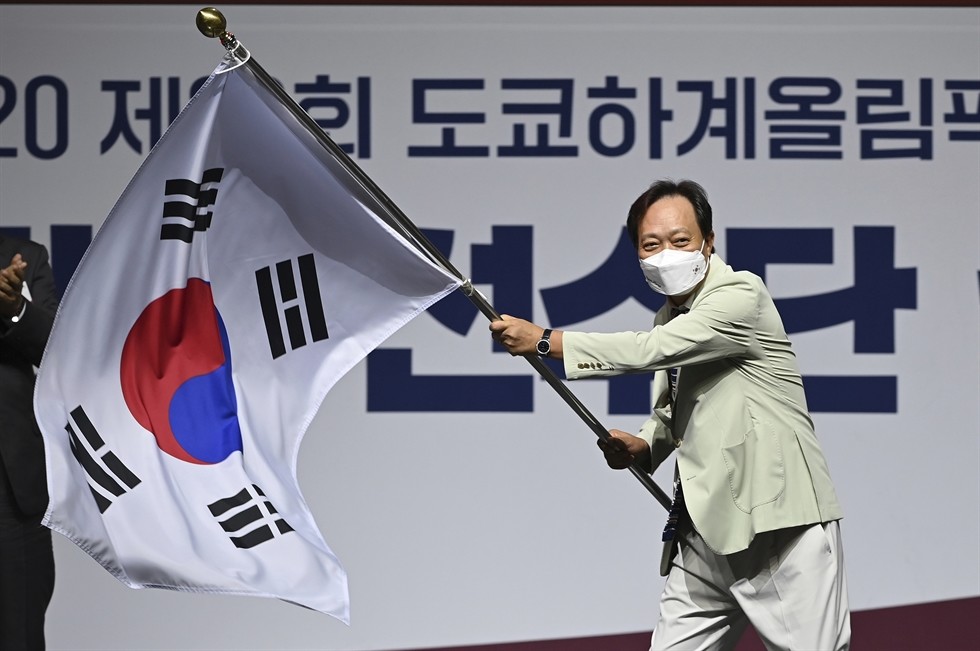
Sprint star Fraser-Pryce will be looking to regain the 100m title after her wins in 2008 and 2012 and add further medals to a collection which also includes two 4x100m silvers, a 200m silver and a 200m bronze. The 10.63 she ran in Kingston in June puts her second on the world 100m all-time list.
Joseph Fahnbulleh, 200m - Liberia
No athlete from Liberia has ever finished in the top eight in their event at the Olympics, let alone won a medal, and sprinter Fahnbulleh will be looking to change that when he takes to the track for the 200m. The 19-year-old ran a PB of 19.91 to win the NCAA title in June.
Thea LaFond, triple jump - Dominica
Dominica hasn’t yet won a medal in any Olympic sport but if she progresses beyond the qualifying round then triple jumper LaFond – who holds the national records of 14.54m indoors and 14.38m outdoors – will make further history for her nation, as no athlete from Dominica has ever competed in an Olympic final.
Alex Rose, discus - Samoa
Rose competed at the Rio Olympics in 2016, placing 29th in discus qualifying, but he’s keen to become the first Samoan athlete ever to reach an Olympic final. He improved his national record to 67.48m in May.
Athletics flag bearers at the Tokyo 2020 Olympic Games
Afghanistan (AFG) - Kimia Yousofi (women’s 100m)
Albania (ALB) - Luiza Gega (women’s 3000m steeplechase)
Andorra (AND) - Pol Moya (men’s 800m)
Antigua and Barbuda (ANT) - Cejhae Greene(men’s 100m)
Bahamas (BAH) - Donald Thomas (men’s high jump)
Belize (BIZ) - Samantha Dirks (women’s 400m) and Shaun Gill (men’s 100m)
Belgium (BEL) - Nafissatou Thiam (heptathlon)
Bosnia and Herzegovina (BIH) - Amel Tuka (men’s 800m)
Botswana (BOT) - Amantle Montsho (women’s 400m)
Burkina Faso (BUR) - Hugues Fabrice Zango (men’s triple jump)
British Virgin Islands (IVB) - Kyron McMaster (men’s 400m hurdles)
Cambodia (CAM) - Sokong Pen (men’s 100m)
Cape Verde (CPV) - Jordin Andrade (men’s 400m hurdles)
Central African Republic (CAF) - Francky Mbotto (men’s 800m)
Colombia (COL) - Caterine Ibarguen (women’s triple jump)
Comoros (COM) - Amed Elna (women’s 100m) and Fadane Hamadi (men’s 110m hurdles)
Congo (CGO) - Natacha Ngoye Akamabi (women’s 100m)
Costa Rica (CRC) - Andrea Vargas (100m hurdles)
Croatia (CRO) - Sandra Perkovic (women’s discus)
Cuba (CUB) - Yaime Perez (women’s discus)
Cyprus (CYP) - Milan Trajkovic (110m hurdles)
Denmark (DEN) - Sara Peterson (women’s 400m hurdles)
Dominica (DMA) - Thea Lafond (women’s triple jump) and Dennick Luke (men’s 800m)
Equatorial Guinea (GEQ) - Alba Mbo Nchama (women’s 100m) and Benjamin Enzema (men’s 1500m)
Eritrea (ERI) - Nazret Weldu (women’s marathon)
Gambia (GAM) - Gina Bass (women’s 100m and 200m) and Ebrima Camara (men’s 100m)
Ghana (GHA) - Nadia Eke (women’s triple jump)
Guam (GUM) - Regine Kate Tugade (women’s 100m)
Israel (ISR) - Hanna Minenko (women’s triple jump)
Ivory Coast (CIV) - Marie-Josee Ta Lou (women’s 100m and 200m)
Jamaica (JAM) - Shelly-Ann Fraser-Pryce (women's 100m, 200m and 4x100m)
Kazakhstan (KAZ) - Olga Rypakova (women’s triple jump)
Lao People's Democratic Republic (LAO) - Silina Pha Aphay (women’s 100m)
Liberia (LBR) - Ebony Morrison (women’s 100m hurdles) and Joseph Fahnbulleh (men’s 200m)
Mauritania (MTN) - Houleye Ba (women’s 100m) and Abidine Abidine (men’s 5000m)
Micronesia (FSM) - Scott James Fiti (men’s 100m)
Nauru (NRU) - Jonah Harris (men’s 100m)
Netherlands (NED) - Churandy Martina (men’s 4x100m)
Palau (PLW) - Adrian Justin Jimena Ililau (men’s 100m)
Panama (PAN) - Alonso Edward (men’s 200m)
Portugal (POR) - Nelson Evora (men’s triple jump)Refugee Olympic Team (EOR) - Tachlowini
Gabriyesos (marathon)
Rwanda (RWA) - John Hakizimana (men’s marathon)
Saint Kitts and Nevis (SKN) - Amya Clarke (women’s 100m) and Jason Rogers (men’s 100m)
Saint Lucia (LCA) - Levern Spencer (women’s high jump)
Saint Vincent and the Grenadines (VIN) - Shafiqua Maloney (women’s 800m)
Samoa (SAM) - Alex Rose (men’s discus)Sao Tome and Principe (STP) - D'Jamila Tavares (women’s 800m)
Saudi Arabia (KSA) - Yasmeen Al Dabbagh (women's 100m)
Sierra Leone (SLE) - Maggie Barrie (women’s 100m)
Solomon Islands (SOL) - Sharon Firisua (women’s marathon)
Somalia (SOM) - Ali Idow Hassan (men’s 1500m)
South Sudan (SSD) - Lucia Moris (women’s 200m) and Abraham Guem (men’s 1500m)
Switzerland (SUI) - Mujinga Kambundji (women's 100m, 200m and 4x100m)
Timor Leste (TLS) - Felisberto de Deus (men’s 1500m)
Trinidad and Tobago (TTO) - Kelly-Ann Baptiste (women’s 100m and 4x100m)
Tuvalu (TUV) - Matie Stanley (women’s 100m) and Karalo Hepoiteloto Maibuca (men’s 100m)
Uruguay (URU) - Deborah Rodriguez (women’s 800m)
Vietnam (VIE) - Thi Lan Quach (women’s 400m hurdles)
(07/23/2021) ⚡AMPby World Athletics
Tokyo 2020 Olympic Games
Fifty-six years after having organized the Olympic Games, the Japanese capital will be hosting a Summer edition for the second time, originally scheduled from July 24 to August 9, 2020, the games were postponed due to coronavirus outbreak, the postponed Tokyo Olympics will be held from July 23 to August 8 in 2021, according to the International Olympic Committee decision. ...
more...Tokyo Olympics Track and Field, marathon and Race Walking schedule
Here is the Tokyo Olympic track and field events scheduled. These events will take place July 30-Aug. 8 at Tokyo’s Olympic Stadium. Sapporo Odori Park will host the race walks and marathon. All times are Eastern Times.
Full schedule (events in chronological order)
July 29
8-8:15 p.m. ET: Men’s 400m hurdles round 1; women’s 800m round 1; men’s steeplechase round 1; women’s 100 m round 1; men’s high jump qualifying; men’s discus qualifying

July 30
6-7:30 a.m. ET: Women’s 5000m round 1; women’s triple jump qualifying; women’s shot put qualifying; mixed 4x400m relay round 1; men’s 10,000m final; 8-10:35 p.m. ET —Women’s 400m hurdles round 1; women’s discus throw qualifying; men’s pole vault qualifying; men’s 800m round 1; women’s 100m hurdles round 1; men’s 100m preliminary round
July 31
6:10-8:50 a.m. ET: Men’s long jump qualifying; women’s 100m semifinals; men’s 100m round 1; men’s discus throw final; women’s 800m semifinals; mixed 4x400m relay final; women’s 100m final
8:10-9:45 p.m. ET: Women’s hammer throw qualifying; women’s 3,000m steeplechase round 1; women’s long jump qualifying; women’s shot put final; men’s 400m round 1
Aug. 1
6:10-8:50 a.m. ET: Men’s high jump final; men’s 100m semifinals; women’s 100m hurdles semifinals; women’s triple jump final; men’s 800m semifinals; men’s 400m hurdles semifinals; men’s 100m final
8-10:50 p.m. ET: Men’s hammer throw qualifying; women’s 1500m round 1; men’s long jump final; women’s 200m round 1; women’s 100m hurdles final
Aug. 2
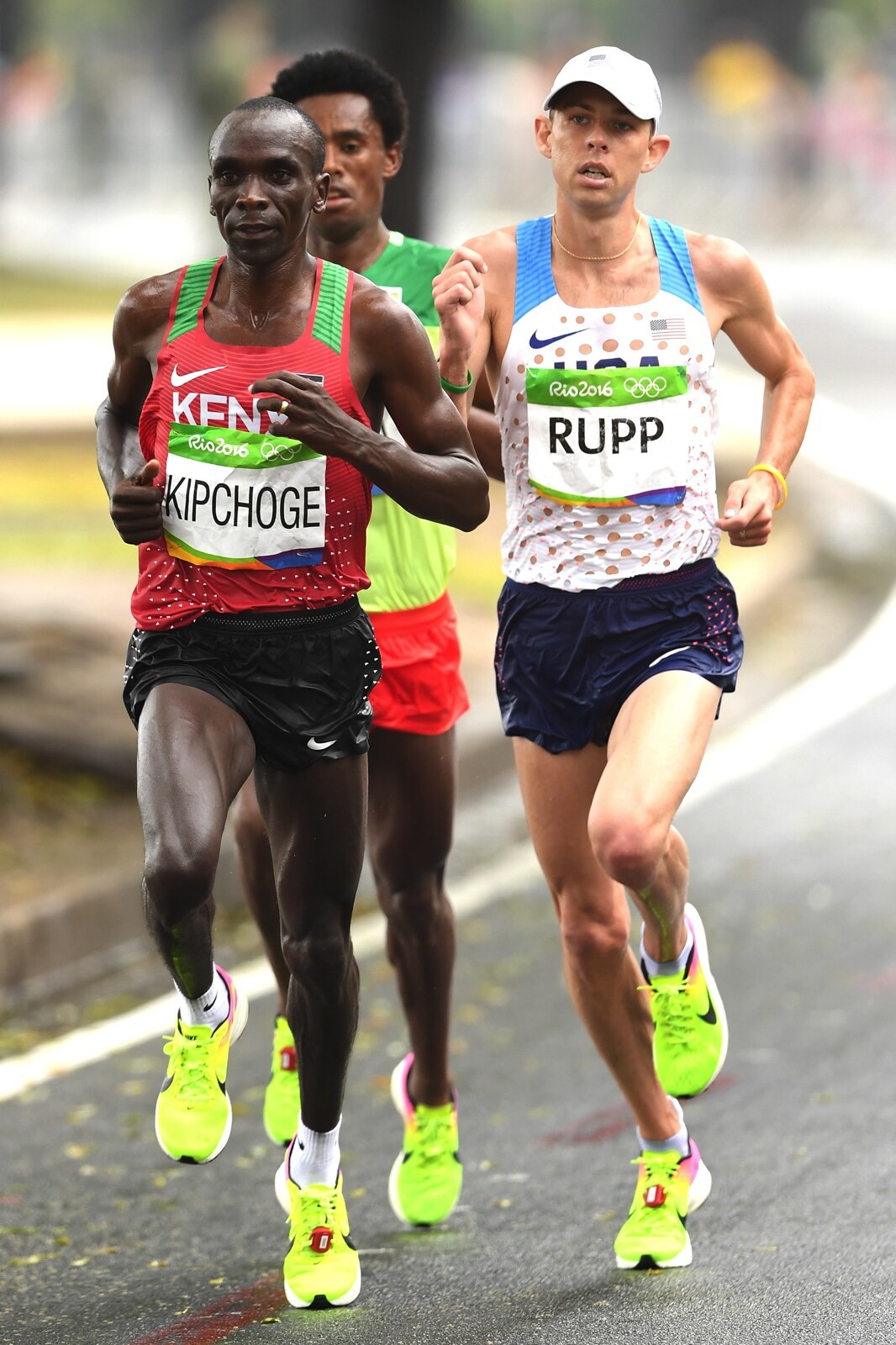
6:20-8:40 a.m. ET: Women’s pole vault qualifying; women’s 200m semifinals; women’s discus throw final; men’s 400m semifinals; women’s 400m hurdles semifinals; men’s 3000m steeplechase final; women’s 5,000m final
8-11:20 p.m. ET: Men’s triple jump qualifying; men’s 1500m round 1; women’s javelin throw qualifying; women’s 400m round 1; women’s long jump final; men’s 200m round 1; men’s 400m hurdles final
Aug. 3
6:10-8:50 a.m. ET: Men’s 110m hurdles round 1; men’s shot put qualifying; men’s pole vault final; men’s 5,000m round 1; women’s hammer throw final; men’s 200m semifinals; women’s 800m final; women’s 200m final
8-10:40 p.m. ET: Men’s decathlon (100m); men’s javelin throw qualifying; women’s heptathlon (100m hurdles); men’s decathlon (long jump); women’s heptathlon (high jump); men’s 110m hurdles semifinals; women’s 400m hurdles final; men’s decathlon shot put
Aug. 4
5:30-8:55 a.m. ET: Men’s decathlon (high jump); women’s 1,500m semifinals; women’s heptathlon (shot put); women’s 400m semifinals; women’s 3000m steeplechase final; men’s hammer throw final; women’s heptathlon (200m); men’s 800m final; men’s decathlon (400m); men’s 200m final
8-11:45 p.m. ET: Men’s decathlon (110m hurdles); women’s high jump qualifying; women’s heptathlon (long jump); men’s decathlon (discus throw); women’s 4x100m relay round 1; men’s triple jump final; men’s shot put final; men’s 4x100m relay round 1; men’s 110m hurdles final; women’s heptathlon (javelin throw); men’s decathlon (pole vault)
Aug. 5
3:30 a.m. ET: Men’s 20km race walk
6:15-8:40 a.m. ET: Men’s decathlon (javelin throw); women’s pole vault final; women’s 4x400m relay round 1; men’s 1500m semifinals; men’s 400m final; women’s heptathlon (800m); men’s decathlon (1,500m)
4:30 p.m. ET: Men’s 50km race walk
Aug. 6
3:30 a.m. ET: Women’s 20km race walk
7:25-9:50 a.m. ET: Men’s 4x100m relay round 1; women’s javelin throw final; men’s 5,000m final; women’s 400m final; women’s 1,500m final; women’s 4x100m relay final; men’s 4x100m relay final
6 p.m. ET: Women’s marathon
Aug. 7
6:35-8:50 a.m. ET: Women’s high jump final; women’s 10,000m; men’s javelin throw final; men’s 1,500m final; men’s 1500m final; women’s 4x400m relay final; men’s 4x400m relay final
6 p.m. ET: Men’s marathon
(07/22/2021) ⚡AMPTokyo 2020 Olympic Games
Fifty-six years after having organized the Olympic Games, the Japanese capital will be hosting a Summer edition for the second time, originally scheduled from July 24 to August 9, 2020, the games were postponed due to coronavirus outbreak, the postponed Tokyo Olympics will be held from July 23 to August 8 in 2021, according to the International Olympic Committee decision. ...
more...Olympics ceremony director fired over Holocaust joke
The Tokyo Olympic organizing committee fired the director of the opening ceremony on Thursday because of a Holocaust joke he made during a comedy show in 1998.
Organizing committee president Seiko Hashimoto said a day ahead of the opening ceremony that director Kentaro Kobayashi has been dismissed. He was accused of using a joke about the Holocaust in his comedy act, including the phrase “Let’s play Holocaust.”
“We found out that Mr. Kobayashi, in his own performance, has used a phrase ridiculing a historical tragedy,” Hashimoto said. “We deeply apologize for causing such a development the day before the opening ceremony and for causing troubles and concerns to many involved parties as well as the people in Tokyo and the rest of the country.”

Tokyo has been plagued with scandals since being awarded the Games in 2013. French investigators are looking into alleged bribes paid to International Olympic Committee members to influence the vote for Tokyo. The fallout forced the resignation two years ago of Tsunekazu Takeda, who headed the Japanese Olympic Committee and was an IOC member.
The opening ceremony of the pandemic-delayed Games is scheduled for Friday. The ceremony will be held without spectators as a measure to prevent the spread of coronavirus infections, although some officials, guests and media will attend.
“We are going to have the opening ceremony tomorrow and, yes, I am sure there are a lot of people who are not feeling easy about the opening of the Games,” Hashimoto said. “But we are going to open the Games tomorrow under this difficult situation.”

Earlier this week, composer Keigo Oyamada, whose music was to be used at the ceremony, was forced to resign because of past bullying of his classmates, which he boasted about in magazine interviews. The segment of his music will not be used.
Soon after a video clip and script of Kobayashi’s performance were revealed, criticism flooded social media.
“Any person, no matter how creative, does not have the right to mock the victims of the Nazi genocide,” said Rabbi Abraham Cooper, associate dean and global social action director of the Simon Wiesenthal Center, a Los Angeles-based human rights group.
He also noted that the Nazis gassed Germans with disabilities.
“Any association of this person to the Tokyo Olympics would insult the memory of 6 million Jews and make a cruel mockery of the Paralympics,” he said.
Kobayashi is a former member of a popular comedy duo Rahmens and known overseas for comedy series including “The Japanese Tradition.”
Japan is pushing ahead with the Olympics against the advice of most of its medical experts. This is partially due to pressure from the IOC, which is estimated to face losses of $3 billion to $4 billion in television rights income if the Games were not held.
The official cost of the Olympics is $15.4 billion, but government audits suggest it’s much more. All but $6.7 billion is public money.
“We have been preparing for the last year to send a positive message,” Hashimoto said. “Toward the very end now there are so many incidents that give a negative image toward Tokyo 2020.”
Toshiro Muto, the CEO of the Tokyo organizing committee, also acknowledged the reputational damage.
“Maybe these negative incidents will impact the positive message we wanted to deliver to the world,” he said.
(07/22/2021) ⚡AMPby Mari Yamaguchi
Tokyo 2020 Olympic Games
Fifty-six years after having organized the Olympic Games, the Japanese capital will be hosting a Summer edition for the second time, originally scheduled from July 24 to August 9, 2020, the games were postponed due to coronavirus outbreak, the postponed Tokyo Olympics will be held from July 23 to August 8 in 2021, according to the International Olympic Committee decision. ...
more...3x3x3 exercise routines for runners and all you need is a pair of dumbbells
The July/August issue of Canadian Running Magazine has hit the newsstands and Newfoundland’s Jon-Erik Kawamoto is back with another strength workout for runners. While many of his recent workouts have featured bodyweight movements for at-home strength training, this routine features dumbbells for runners who’ve built themselves a home gym, or who’ve ventured back to their local gym as the country has slowly lifted COVID-19 restrictions. Try this workout yourself, and as always, be sure to grab yourself a print copy of the latest print edition of Canadian Running.
Kawamoto understands there are many runners out there who’d rather be out running than spending hours in the gym, so he designed these routines to take only about 20 minutes. He has created three separate workouts featuring three exercises, and you only have to do three sets of each, hence the name 3x3x3. All you need to perform these workouts are some light to medium dumbbells, or as he says in the video, you can just use your own body weight if you’re new to strength training.
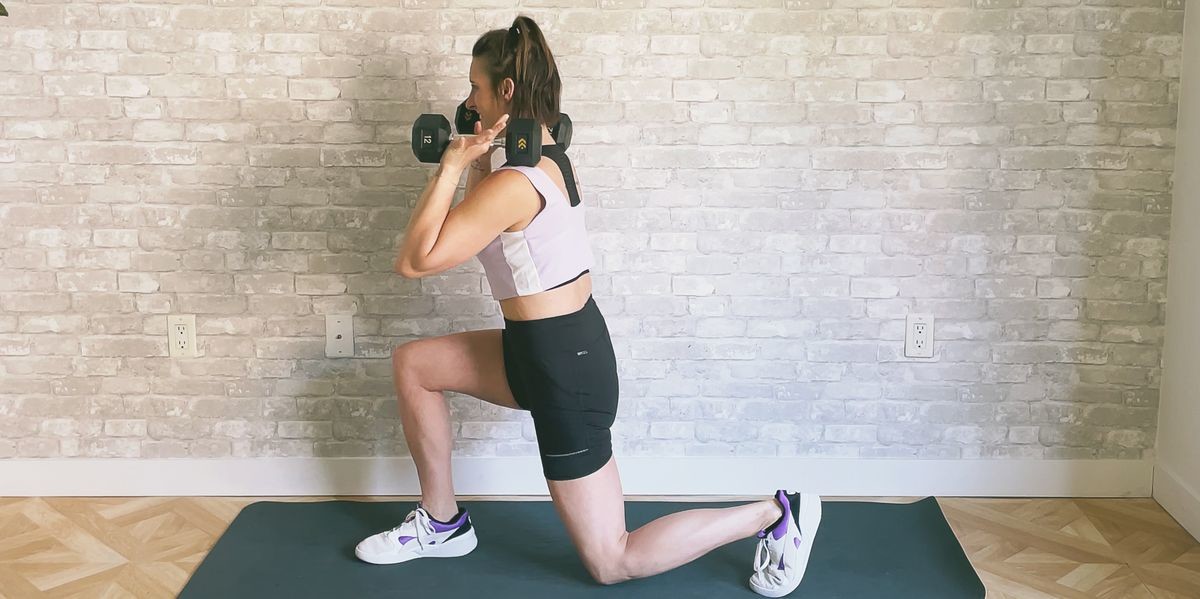
Even though strength training may not be your favourite thing, Kawamoto explains in the video that it’s an important part of your training if you want a body that is resilient, that is strong for running and a body that has better running economy. This, he says, will help you train for several months while decreasing your risk for injuries and helping you to run faster and longer.
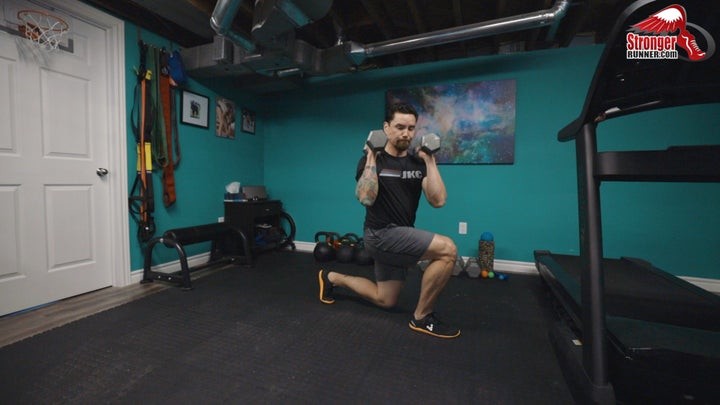
If you’re new to strength training, be sure to watch the video as Kawamoto takes you through each exercise and explains how to perform them safely and effectively. If you like this routine, be sure to check out his other videos in the Canadian Running archives, and be sure to grab the next issue of the print magazine to see what workout he covers next.
Jon-Erik Kawamoto, MSc, CSCS, CEP, is a strength and conditioning coach, a regular contributor to Canadian Running and co-owner of JKConditioning, a personal training, nutrition and run coaching company in St. John’s, Nfld. Find out more at JKConditioning.com
(07/22/2021) ⚡AMPby Brittany Hambleton
RUNCZECH PRAGUE RACES CANCELED BECAUSE THEY ARE TOO BIG TO TAKE PLACE DURING PANDEMIC.
With social distancing and other limiting rules still in place for mass participation events, as well as with all uncertainties surrounded by new waves of virus mutations, RunCzech has elected to cancel their highly popular Sportisimo Prague Half Marathon and the Birell Prague Grand Prix, planned for September 4-5, as well as the Prague Relay planned for August 25.
Staging a world class event requires months of preparations, which the organizers don’t have at disposal under the circumstances, and RunCzech prizes quality too much to jeopardize it.

Even if there was more time, considering the size of the events, the organizers would have been required to stagger the start of those races. And with tens of thousands of runners participating, the events would have dragged on endlessly. Staggered starts would have left runners standing around for hours. It would have been a burden on the volunteers who already give so much. And it would have shut down the city for far too long.
According to Mr. Capalbo, the president of the organizing committee, “the citizens of Prague enthusiastically support what we’re doing here. They celebrate with us. But closing the city for whole weekend and keeping everyone waiting that long would be unfair to the runners and to the locals.”
To all registered runners that have paid the entry fee, the organizers are making available the option to either transfer their registration to 2022, or to transform the registration fee into a voucher for the e-shop www.allrunnersarebeautiful.com or to donate their amount to the project ‘Get up and run’ for students that helps to improve the sport facilities in high schools.
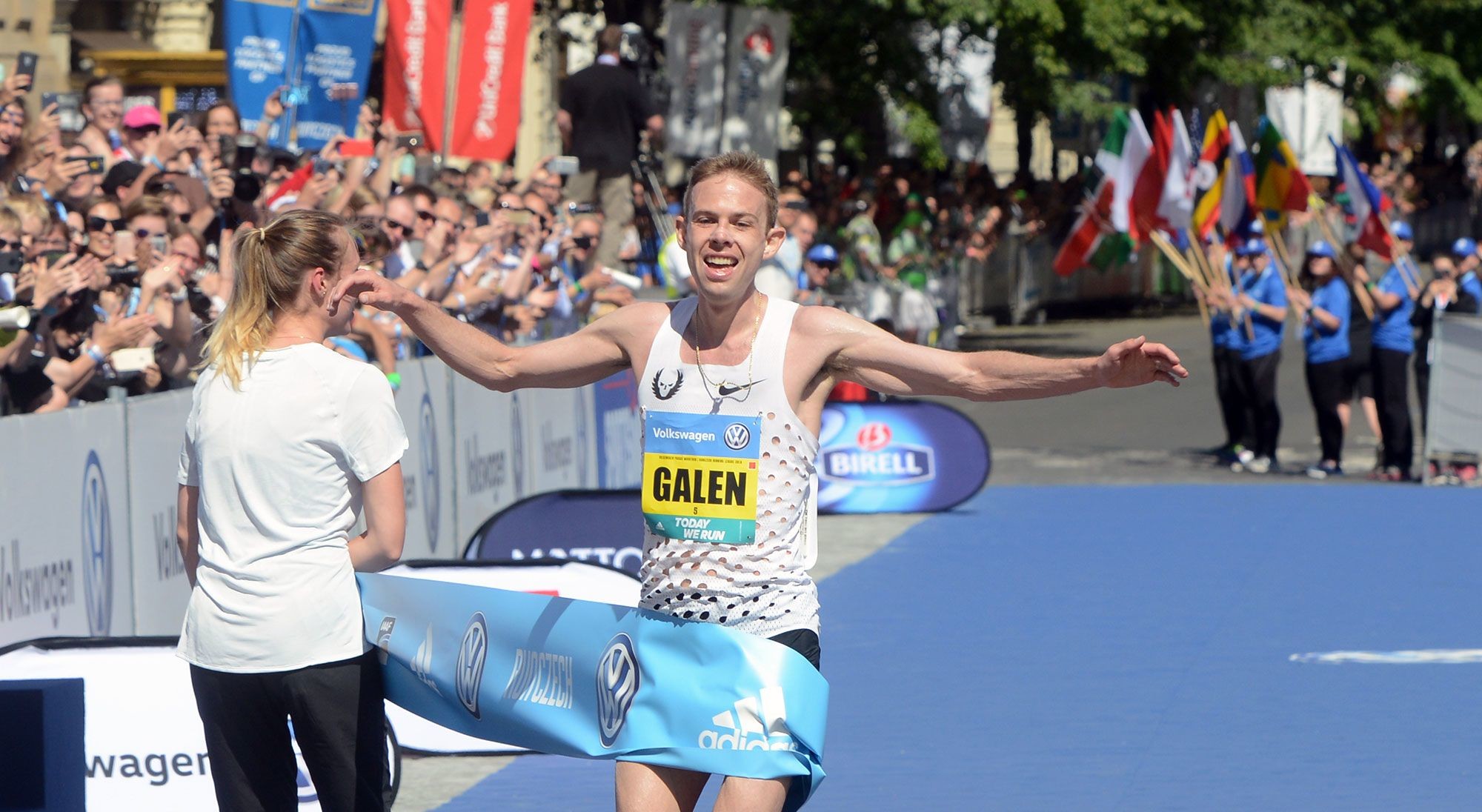
Meanwhile, RunCzech is still planning to stage its next regional events, the Generali ÄŒeská Red Run on June 24 and the Mattoni Olomouc Half Marathon on August 14, which are in line with the health and safety measures and are feasible to take place.
On top, starting from August and lasting until the end of October, the organizers offer a free of charge virtual running challenge called Mattoni FreeRun Run & Plog. The project is linked with the Plogging Cesko association and together will inspire runners to collect waste while running and make their region greener.
The destiny of the Volkswagen Prague Marathon and the events in Usti nad Labem, Liberec, and Ceske Budejovice is being discussed and monitored daily. The organizers will release further information in the month of August.
The organization is hopeful that, with more people receiving the Covid vaccine, their regular race schedule will resume soon. In the meantime, Mr. Capalbo has a simple message of hope for runners. “You keep training. And we’ll keep thinking.”
(07/22/2021) ⚡AMPSifan Hassan eyes unprecedented Olympic track treble
Sifan Hassan may have raised eyebrows when she announced an unprecedented bid for triple Olympic gold in the 1500m, 5000m and 10,000m, but on previous form she looks tailor-made to make history in Tokyo.
The 28-year-old, born in Ethiopia but now a long-time naturalised Dutchwoman, became the first athlete to achieve the 1500 and 10,000m world double in Doha in 2019.
It was a remarkable show of running, especially as it came after the news that her coach Alberto Salazar, the head of the Nike-funded Oregon Project, had been banned for four years over doping-related issues.

"The hardest moment and pressure in my life was in Doha and I handled it," she said earlier this month.
"Tokyo will not be hard."
Hassan certainly did handle it, meeting the furore head-on after she had completed the double.

"If they want to test me they can test me every single day. Every single day," she said.
"I believe in clean sport, I'm always clean, I will always be clean.
"I believe in the Oregon Project (since disbanded by Nike). I've seen Alberto. He's worked really hard and that is what I know."
Hassan failed to bow down to more potential criticism from detractors when she selected former Salazar assistant Tim Rowberry as her new coach.
"Three years ago I made the choice to go to America," she said in 2020 after choosing Rowberry.
"I now have a familiar situation where I feel very much at home.
"I have considered several options and met new people to find the right click, but I believe that my current training situation is the best way to successfully prepare for the Tokyo Olympics."
'I am crazy'
Hassan's treble bid echoes that of the 'Czech Locomotive', Emile Zatopek, who won 5,000m, 10,000m and marathon golds at the 1952 Olympics.
For Hassan it may be more of a challenge in terms of the scheduling with the toughest day on August 2.
She runs the 1500m heats in the morning and then, provided there has not been an upset in qualifying, the 5,000m final in the evening session.
She would then need to come through the 1500m semi-finals on August 4 with the final two days later.
If it is two from two after that, a sleepless night might beckon ahead of a history-making attempt at the third, the 10,000m final, on August 7.
(07/22/2021) ⚡AMPTokyo 2020 Olympic Games
Fifty-six years after having organized the Olympic Games, the Japanese capital will be hosting a Summer edition for the second time, originally scheduled from July 24 to August 9, 2020, the games were postponed due to coronavirus outbreak, the postponed Tokyo Olympics will be held from July 23 to August 8 in 2021, according to the International Olympic Committee decision. ...
more...Schedule of track and field at Olympics
Track and field kicks off on Thursday, July 29, 2021 at the Tokyo Olympics with qualifying rounds in several distances and field events. Coverage wraps up on Sunday, August 8 with the men’s marathon. Check out the track and field schedule for the Tokyo Olympics at: https://www.nbcolympics.com
The Tokyo Olympics officially begin on Friday, July 23, with the Opening Ceremony at 8 p.m local time, or 7 a.m. Eastern in the U.S. Competition, however, begins in Japan with softball and soccer games on Wednesday, July 21.
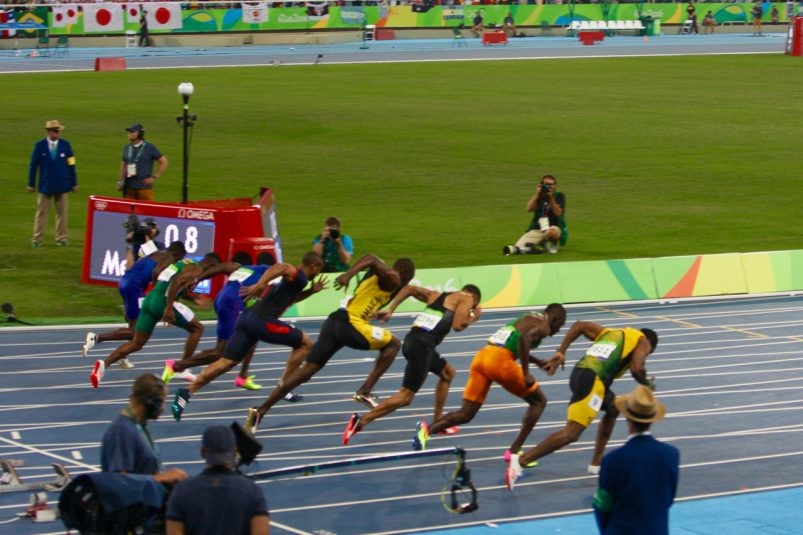
What is the time difference?
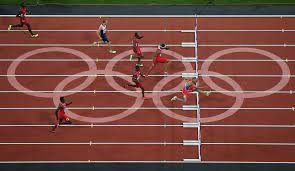
Tokyo is 13 hours ahead of Eastern Daylight Time and 16 hours ahead of Pacific Daylight Time. Morning in the U.S. is evening in Japan.
How to watch the Olympics?
NBC will broadcast the 2021 Tokyo Olympics, both on its affiliated television channels and on Peacock, its online streaming platform. NBC is also available on several streaming platforms, including Sling TV, Hulu with Live TV, fuboTV and YouTube TV.
(07/22/2021) ⚡AMPby Colorado Runner
TCS will Renew Sponsorship of TCS New York City Marathon Through 2029
Tata Consultancy Services (TCS) a leading global IT services, consulting, and business solutions organization, announced that it has signed an eight-year contract with New York Road Runners (NYRR) to extend its title and technology sponsorship of the TCS New York City Marathon through 2029. TCS’ sponsorship of global running events will also be highlighted in a new advertising campaign which debuts today.
TCS’ extended partnership with NYRR follows its announcement earlier this month that it will become the new title sponsor of the London Marathon starting in 2022. Collectively, TCS plans to invest $30 million to $40 million annually in global running sponsorships and related community programming from 2022 to 2029.

“We are delighted to extend our sponsorship of the TCS New York City Marathon, the foremost running event in the world,” said Surya Kant, Chairman, North America, TCS. “We sponsor running events across the world because we want to inspire local communities to live healthy and active lifestyles, and also because of the obvious parallels between marathons and the growth and transformation journeys that we help our customers undertake. Running a marathon makes you feel that there’s nothing you can’t do. With each step, you’re building on belief.”
As part of the sponsorship, TCS will launch a new version of its TCS New York City Marathon App that incorporates augmented reality (AR) features that became popular for virtual races during the pandemic. The new version will include features to support both in-person and virtual runners along with surprise-and-delight AR experiences. Fans and athletes will be able to access real-time runner tracking, digital cheer cards, and a finishing-time predictor.
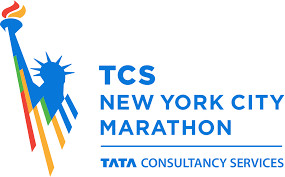
The other pillar of TCS’ sponsorship focuses on redoubling its efforts to encourage communities to adopt active, healthier lifestyles. TCS will donate $4 million to NYRR’s youth and community programs including Rising New York Road Runners, a free, nationwide NYRR program that incorporates physical education into the school day. TCS will also develop a marathon version of its award-winning goIT STEM education contest that will challenge students to develop an app concept that promotes active lifestyles and inclusivity. Lastly, TCS will host the Team TCS Teachers Program, which will select 50 teachers from across North America who demonstrate an ability for sharing their passion for running with students. Selected teachers will receive free race entries, a VIP race day experience, and marathon-themed lesson plans for students from TCS’ STEM education program, Ignite My Future in School.
The company’s new advertising campaign titled We Believe is anchored in its marathon sponsorships, and complements TCS’ new brand direction. Using marathon supporters and fans as the heroes of the story, the campaign is centered around a runner’s journey and the team of individuals it takes to turn a belief into reality.
“At NYRR, we are thrilled to extend our incredible partnership with TCS for the next eight years,” said Kerin Hempel, CEO, NYRR. “Since 2014, TCS has helped us transform our runners’ experience through technological advancements, while also providing tremendous support of our community programs across the five boroughs. TCS and NYRR have shared core values, commitment to service, and passion for innovation, and I can’t wait to see what we co-create in our next chapter together.”
(07/22/2021) ⚡AMPby Running USA
TCS New York City Marathon
The first New York City Marathon, organized in 1970 by Fred Lebow and Vince Chiappetta, was held entirely in Central Park. Of 127 entrants, only 55 men finished; the sole female entrant dropped out due to illness. Winners were given inexpensive wristwatches and recycled baseball and bowling trophies. The entry fee was $1 and the total event budget...
more...Brisbane Australia has been officially announced as host of the Olympic and Paralympic Games in 2032.
The 2032 Olympics will be the third time Australia hosts the Games first Melbourne in 1956 Sydney in 2000 and now Brisbane 2032
The Australian city and surrounding South-East Queensland region were approved as the Games hosts at an International Olympic Committee (IOC) session in Tokyo on Wednesday.

"Brisbane 2032 is the first future host to have been elected under, and to have fully benefited from, the new flexible approach to electing Olympic hosts," said IOC President Thomas Bach in a statement.
The Olympics are slated to run from July 23-August 8, with the Paralympic Games taking place from August 24-September 5, across 37 venues.
Brisbane and the surrounding region is set to host or co-host a number of sporting events in the next few years, including the 2022 FIBA Women's Basketball World Cup, the 2022 UCI Road World Championships in cycling, and the 2023 FIFA Women's World Cup in soccer.

The region also hosted the 2018 Commonwealth Games on the Gold Coast, an area which will host some events in 2032.
"The Brisbane 2032 vision and Games plan fit into long-term regional and national strategies for social and economic development in Queensland and Australia," said Bach, who is currently in Tokyo for the 2020 Olympic Games, which were delayed for a year due to Covid-19.
Queensland Premier Annastacia Palaszczuk holds a queue card after the Brisbane announcement during an IOC session in Tokyo.
It will be Brisbane's first Games, although Australia has previously hosted two: Melbourne 1956 and Sydney 2000. Brisbane's bid for the 2032 games was unopposed.
Opposition to hosting the Games has grown in recent decades as citizens question the long-term impact on their neighborhoods and public finances.
Detractors bemoan an Olympic legacy of "white elephants" like the rusting stadia in Athens left after the Greek capital hosted the 2004 Games, which cost $11 billion and became powerful symbols of waste during the country's debt crisis.
On Tuesday, Greek Prime Minister Kyriakos Mitsotakis announced a 54 million euro ($63.6 million) project to redevelop the Olympic Athletic Center of Athens (OAKA).
The venue was overhauled for the 2004 Games but has been running at a loss and cost the Greek state 200 million euros ($235.5 million) since 2005, according to a government press release. The aim is to reopen the site in 2023 and create 1,400 permanent jobs.
(07/21/2021) ⚡AMP2016 Olympic gold medalist triathlon Gwen Jorgensen is Leaving Bowerman Track Club
After four years at the Nike-sponsored club coached by Jerry Schumacher, Gwen Jorgensen announced today that she’s leaving Bowerman Track Club to be coached by Bobby McGee, who she has worked with in the past.
In a video uploaded to her YouTube channel, Jorgensen explained that a mix of career and family goals led to this decision. “I’ve had two marathons that just haven’t proven I can do it,” she said. “I want to just have a marathon, that’s like, OK, I can run this.” She and her husband, Patrick Lemieux, are also looking for a new place to live and are considering having more children.
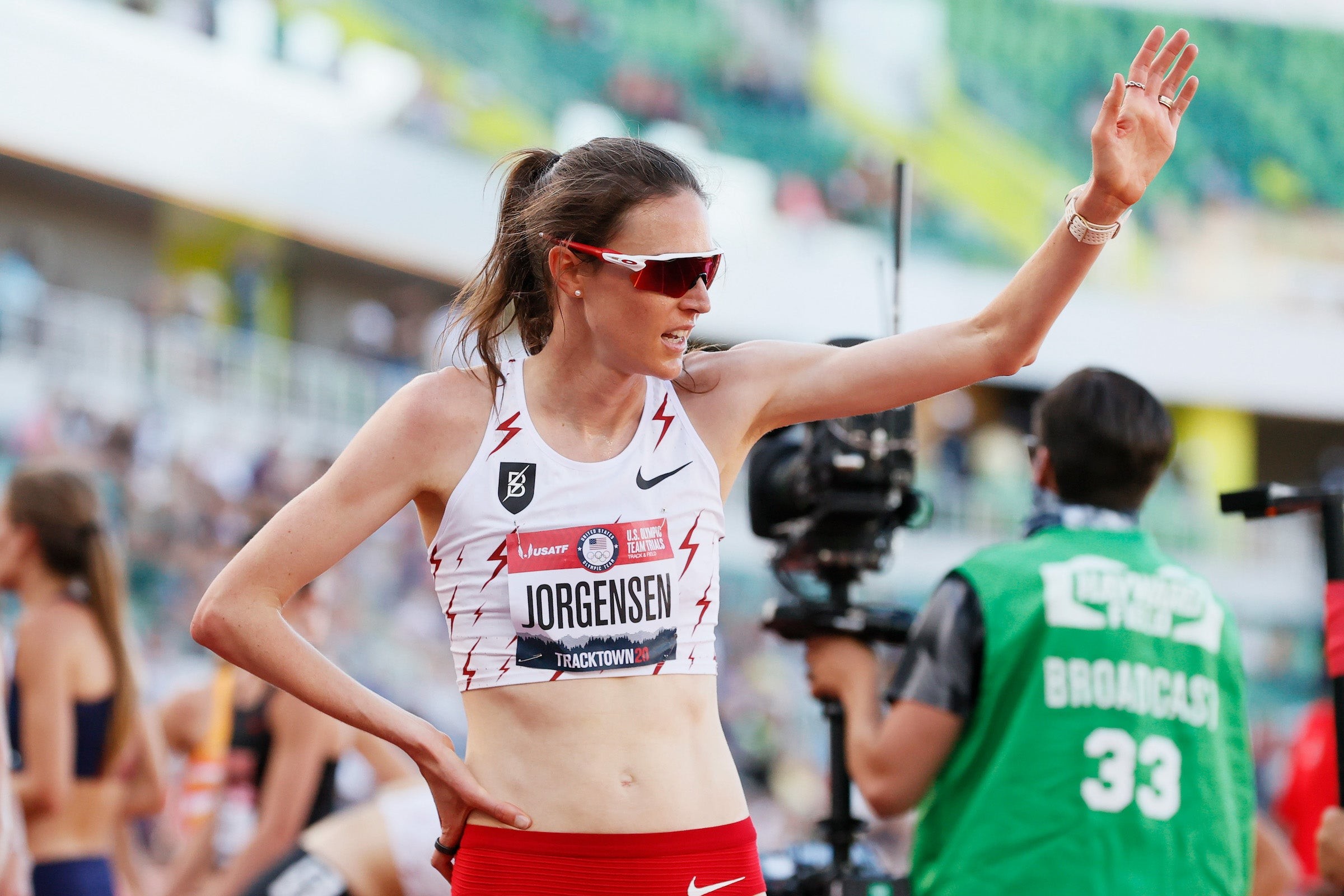
Jorgensen won the Olympic gold at the Rio Games in 2016 in triathlon, and announced a year later she would shift to running, with a focus on medaling in the marathon. Due to extended recovery after heel surgery to repair Haglund’s deformity in May 2019, she didn’t end up competing in the Olympic marathon trials last year—in early 2020, she decided to focus on the track.
“My goals in the marathon aren’t changing. My timeline is,” she said at the time.
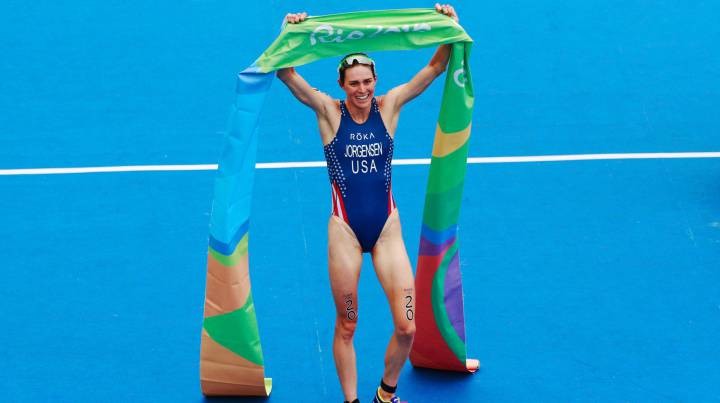
At the recent U.S. Olympic Track & Field Trials in Eugene, Oregon, Jorgensen competed in the final of the women’s 5,000m, finishing ninth in 15:50.62. (Two of her BTC teammates, Elise Cranny and Karissa Schweizer, finished first and second.) Jorgensen also lined up for the women’s 10,000m final, but pulled out sometime after recording a time of 26:50.07 at the 8000-meter mark.
“Today I had the best of intentions,” she wrote on Instagram following the race. “I got myself in good position the first mile (something I rarely do). I didn’t focus on splits, I just ran what I needed to stay in contention until I couldn’t.”
Searching for the Right Place to Live
Lemieux says that Bend, Oregon, Boulder, Colorado, and Bentonville, Arkansas are currently on their short list, and a visit to Asheville, North Carolina is next. “Really our criteria was: Can I mountain bike from the door? Can [Gwen] run outside 11, 11 and a half months of the year? And does it have good schools, and a family feel, and a small town vibe,” he says.
“We’re looking for a place that’s good for marathon training, but we also want this place to be somewhere where we could stay forever,” Jorgensen says.
Growing Their Family
At 35, Jorgensen is considering getting testing done to determine her “maternal age” and how many eggs she has left.
Jorgensen and Lemieux are parents to one son, Stanley. Jorgensen had a difficult labor experience that she says has made her reluctant to consider pregnancy again: “I also remember when I had Stanley and just saying, I can never come back to sport after this again. And just that I can never have more than one more child, just because of the experience I went through.” She mentioned that her pelvic floor therapist has told her her next experience will be great, but that they’re also open to adoption.
Goals for the Future
Unlike in the past, where Jorgensen publicly announced specific running goals for the future, she’s more broadly wanting to return to focus on the marathon. “Bobby was saying things that I just thought were outlandish, and I love that he has that belief in me,” she says. The couple admit that the decision on where to live is rushed, partly because Jorgensen wants to be settled for fall marathon training, though she didn’t specifically say which marathon she’s training for.
(07/21/2021) ⚡AMPby Women´s Running
February's Marugame Half plans to go ahead with reduced field size and no international competitors
On July 19 the organizers of the Kagawa Marugame International Half Marathon made the decision to move forward with the event's 75th edition, postponed one year to next Feb. 5-6 due to the coronavirus pandemic, with a field reduced in size by 30%. Conditions the organizers established for the event to take place included there being no state of emergency declared for Kagawa prefecture at that time.
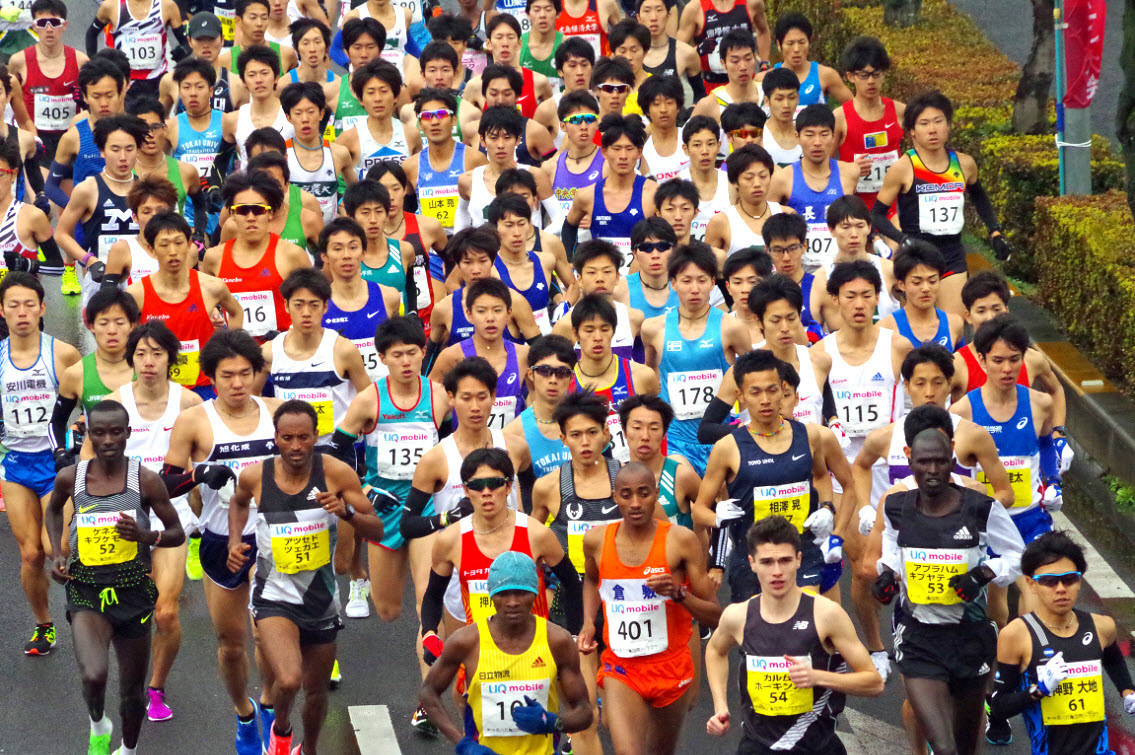
At another meeting the same day at Marugame city hall, the committee met to discuss guidelines for implementing the event. Along with an obligation to meet the JAAF's pandemic road race guidelines, the organizers and city took into account the prefectural government's alert level system, stipulating that conditions must be within the 3rd through 6th level of the prefecture's six-level risk categorization. The organizers also limited participation to residents of Japan.
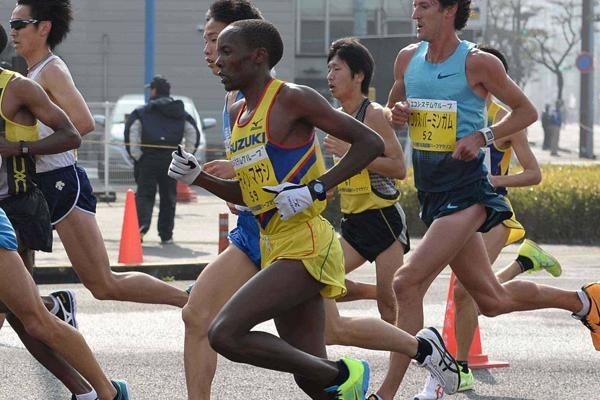
The field will be limited to 7,000 runners, a reduction of 30% from its usual size, with the 3 km and elementary school ekiden races also reduced in capacity by 30%. Entry fees for the half marathon have been raised by 2/3 from 6,000 to 10,000 yen, with fees for the other divisions also raised. Entries will be open from Oct. 12 to Nov. 19, with no last-minute registration the day before the race like in past years. Finishers' certificates will only be available via online download.
The organizers also made plans to establish a 15-member medical advisory committee to develop plans for effective coronavirus countermeasures, and to make a determination one to two months before race date whether it will be feasible to actually stage the races. Organizers also have yet to finalize plans for refunds in the event of cancelation or further field size reduction, and will be likely to deduct expenses from entry fees prior to any refunds being made.
(07/21/2021) ⚡AMPby Brett Larner
Kagawa Marugame Half Marathon
The Kagawa Marugame Half Marathon is an annual road running competition which takes place in early February in Marugame, Japan. It currently holds IAAF Silver Label Road Race status and the professional races attract over 1000 entries each year, and hosted by the Sankei Shimbun, Sankei Sports, Okayama Broadcasting, BS Fuji. The race in Marugame was first held in 1947...
more...When is Laura Muir in action at Tokyo Olympics
Is this the year that Laura Muir ends her wait for a global medal?
The European 1500m champion is yet to step on the podium at either the World Championships or Olympics but will again be in the mix in Tokyo.
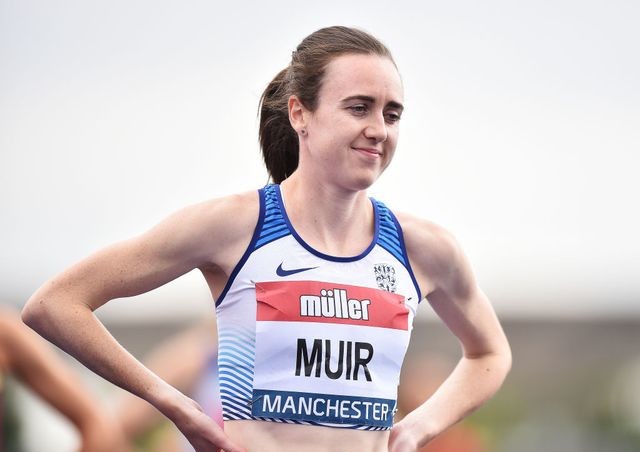
Despite running the second-fastest 800m by a British woman earlier this month she has decided not to double up in Japan.
What events is Laura Muir competing in?

Muir is focusing solely on her favoured event - the 1500m.
When is Laura Muir in action?
All times BST
Monday, August 2
Women’s 1500m heats - 1.35am-1.51am
Wednesday, August 4
Women’s 1500m semi-finals - 11am-11.12am
Friday, August 6
Women’s 1500m final - 1.50pm.
(07/21/2021) ⚡AMPby Evening Standard
Which is best? Active vs. passive recovery
The importance of recovery for runners. After all, you can’t expect to continue running well if you don’t give your body the time to rest and adapt to your workouts.
But is which type of recovery is better? Active or passive? As with most things, there are benefits and room in your training for both.

Active vs. passive recovery
First, what exactly is the difference between active and passive recovery? Passive recovery refers to complete rest, and you can think of a full rest day like a good night’s sleep. On days like this, you want to avoid doing anything too strenuous, such as doing heavy yard work, helping a friend move or going on a big hike. In comparison, active recovery is like taking a short nap. It involves doing easy to moderate-intensity activity, like a short, easy run, walking, cross-training, yoga, hiking, or any activity that gets your blood flowing but isn’t too taxing.

Both have benefits
While we often think of rest as meaning little-to-no activity, rest after a hard workout can also mean recovery through movement, which is where active recovery provides a lot of benefits. Doing light, low-impact activity after a hard run can promote blood circulation to your muscles to help them repair and prevent soreness. Enjoying some light movement can also help clear your head, allowing your mind to recover from your workout as well. This way, you’ll be both physically and mentally ready to tackle your next hard session when the time comes.
Cycling is a popular active recovery activity among runners because it’s a similar motion to running but with less impact on your joints. Hiking can also be beneficial, because walking on an incline can strengthen the little stabilizer muscles around your feet and ankles. Doing bodyweight exercises like core work, air squats, lunges and calf raises can also boost circulation while helping to build strength as well, and yoga can be a great way to relieve tension and stretch tight areas in your body. More experienced runners can use easy jogging as an active recovery strategy, but they should be sure to keep the pace slow to allow proper recovery.
While there may be plenty of benefits that come with active recovery, this doesn’t mean that passive recovery, or full rest, doesn’t have a place in your training plan. Particularly for runners who are training many days per week (five or six), having a scheduled rest day is important to prevent over-training and burnout. On top of that, there is nothing wrong with having an unplanned rest day, either. Some days, whether you have a workout or an active recovery session planned, your body may be asking you for an extra full rest day. It could be that you’re feeling more sore or tired than usual, or it could be that your workout the day before didn’t go well. However your body is communicating it to you, you should listen to it. Pushing your body when it really needs rest will only lead to injuries and burnout, and won’t help your performance.
The bottom line
Both active and passive recovery is important for runners and should be a part of your training plan. It is up to you to listen to your body to know which type of recovery it needs and to prioritize rest so you can continue to run well.
(07/21/2021) ⚡AMPby Brittany Hambleton
Olympics Face Cancellation As COVID Cases Rise
The opening ceremony for the Tokyo Olympics is just three days away, but there's a chance that the Games could be canceled altogether — and that's coming from the organizing committee's chief.
Tokyo is under its fourth state of emergency until Aug. 22, and 71 people in the Olympics Village have tested positive for COVID-19 so far.
Committee chief Toshiro Muto said it will "continue discussions" about canceling if there is a spike in cases. IOC president Thomas Bach, however, said canceling was never an option.
The Olympics are already expecting an estimated $25 billion bill.
Delaying the games for a year cost organizers $3 billion. The total insurance coverage for the games is estimated to be around $2.5 billion.
Roughly 60 Japanese companies spent $3 billion for 2020 sponsorship rights — and another $200 million for contract extensions when the games were delayed, according to Reuters.
Toyota, which became a global Olympics sponsor in a nearly $1 billion deal, pulled Olympic-related ads from Japanese TV on Monday.
Before banning spectators, Japan expected ticket revenue to reach $815 million.
The biggest loser from a cancellation could be NBC, which agreed to a $7.75 billion media rights deal with the IOC in 2014 that runs through 2032. The network expects the Games to drive a 30% jump in Peacock users.
(07/20/2021) ⚡AMPby Front Office Sports
Tokyo 2020 Olympic Games
Fifty-six years after having organized the Olympic Games, the Japanese capital will be hosting a Summer edition for the second time, originally scheduled from July 24 to August 9, 2020, the games were postponed due to coronavirus outbreak, the postponed Tokyo Olympics will be held from July 23 to August 8 in 2021, according to the International Olympic Committee decision. ...
more...Dan King, 62, sets new US masters records
Dan King, 62, of Boulder recently set new U.S. masters one mile records on both the road and track. On July 11, 2021, he ran 5:00* at the Lincoln Mile (Lincoln, Neb.) to break the previous record of 5:03 set in 2014 by Tom McCormack.
Then, one week later, on July 18 he ran 4:51.45 at the Sunset Tour / American Track League in San Juan Capistrano. Nolan Shaheed held the previous record of 4:53.01 set in 2012.
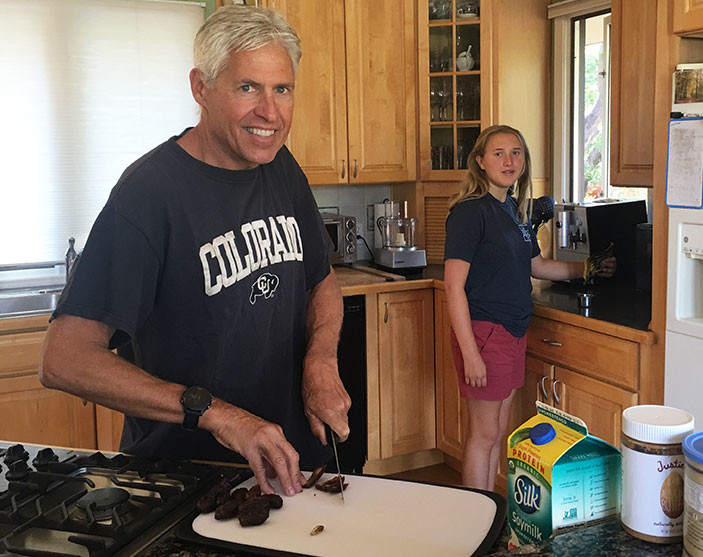
King has been a competitive runners since high school and was a track and cross country runner at the University of Colorado. He has previously set multiple masters running records.
*pending ratification by USATF
(07/20/2021) ⚡AMPby Colorado Runner
The chief of the Games has stated that a last-minute cancelation of the Olympics remains an option
When the Tokyo 2020 Olympics were originally postponed, organizers were hopeful that by 2021 the COVID-19 pandemic would be well in our rearview mirror. As the virus continued to affect countries around the world, the Olympics became the centrepiece of a global debate: should the Games be canceled? Organizers have been adamant that the Games will go forward as planned, and months of planning have gone into putting rules and protocols in place to prevent them from becoming a super-spreader event. As athletes and officials have begun arriving in the Olympic Village, it appears as though the fears held by many are coming true, and the first cases of COVID-19 in the Village have officially been reported.
The first case was confirmed on Saturday (July 17). The affected individual was not an athlete, but an official connected to the Games. According to Inside the Games, they had not tested positive upon arrival in the Tokyo airport, but a test taken during the screening process at the Village returned the positive result. The official is now in a 14-day quarantine.

“We are making sure to do everything possible to ensure that there is no COVID-19 outbreak,” Tokyo 2020 President Seiko Hashimoto said. “We are sparing no efforts. We are doing everything we can to prevent any outbreaks.”
Hashimoto added that should there be an outbreak, they will have a plan in place to contain it. Still, this case comes as a significant concern to organizers and the International Olympic Committee (IOC), who have promised the Olympic Village will be the safest place in the city. As of Saturday, there had been 14 more positive cases connected with the Games since July 1 for a total of 44 during that period, although those cases did not occur in the athletes’ Village. Four of them were reportedly from “Games connected personnel”, while seven others came from contractors working on the Olympics and two more from members of the foreign media.

Unfortunately, the positive results have not stopped there. As athletes have begun arriving at the Village ahead of the first day of the Games this Friday, 10 more positive tests were reported on Sunday, including two South African soccer players and one other athlete, who tested positive upon arrival at the Tokyo airport. This brings the total number of positive cases associated with the Games up to 55 since July 1.
Several teams from other countries have now been forced into isolation due to issues with COVID-19, including members of the Athletics (track and field) team from the U.K. Six athletes and two staff members have been forced into isolation after a passenger on their flight to Japan tested positive, and they were identified as close contacts.
“This was identified through Tokyo 2020’s reporting service and the group have since started a period of self-isolation in their rooms at the BOA’s preparation camp, in line with Tokyo 2020’s Playbook protocols,” the British Olympic Association (BOA) said. “The group all tested negative at the airport and have continued to test negative upon arrival into the country. They are under the supervision of the Team GB medical team, led by chief medical officer Dr. Niall Elliott.”
These positive tests are alarming and call into question how issues surrounding the virus will affect the athletes’ ability to prepare for competition, even those who don’t produce a negative test. The IOC has stated that at least 85 per cent of the athletes and staff who will be staying in the Village have been vaccinated, but as more athletes continue to arrive in Tokyo, the risks for spreading the virus will only get higher. As of the Tuesday, the total positive case count has reached 65, and the chief of the Games has reportedly not ruled out a last-minute cancelation should the situation continue to worsen.
(07/20/2021) ⚡AMPby Brittany Hambleton
Tokyo 2020 Olympic Games
Fifty-six years after having organized the Olympic Games, the Japanese capital will be hosting a Summer edition for the second time, originally scheduled from July 24 to August 9, 2020, the games were postponed due to coronavirus outbreak, the postponed Tokyo Olympics will be held from July 23 to August 8 in 2021, according to the International Olympic Committee decision. ...
more...Improving your balance will give you a smoother, stronger stride to help you run faster
You may not have realized it, but running requires a lot of balance. In fact, the reason babies can’t really run until they’re about two years old is that they lack the balance to do so. When you run, you spend all your time either in the air or on one foot, and it takes a lot of balance to remain upright and not fall over mid-stride. For this reason, if you want to have a smoother, more powerful stride (and subsequently run faster), it’s important you work on this vital skill.
The problem is, in most Western countries, we run in fancy shoes that provide a tonne of stability, often on smooth, paved surfaces. The more stability we give ourselves through supports like shoes, the less balance we need to avoid falling over, and the smooth, flat surface don’t do much to challenge our balance, either.
If you’re wondering why balance is important when we have shoes to provide us with so much stability, the answer is performance. When you’re running, you spend your energy on two main things: forward propulsion and staying upright. The greater percentage of energy you spend moving forward, the faster you’ll go and the longer you’ll be able to run. To do this, you have to decrease the amount of energy you’re spending trying to stay upright. How do you do that? By training your balance.

How to improve your balance
One easy way to improve your balance is to get off the smooth, paved surfaces and hit the trails. The varied terrain you encounter on a trail run will challenge all the little muscles and ligaments in your feet and ankles that help you stay on your feet.
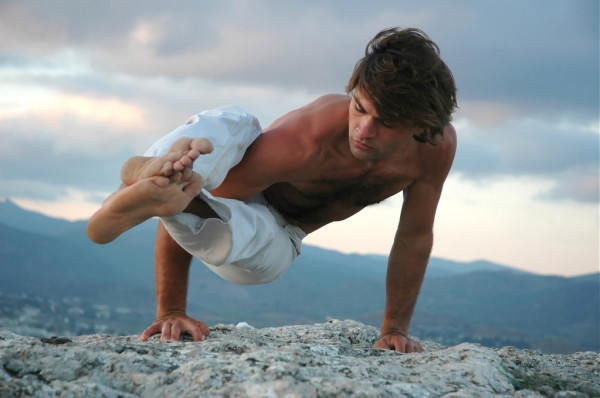
Another way to improve your balance is to incorporate single-leg exercises, like lunges and single-leg squats, calf raises, deadlifts and hip bridges into your strength training routine. If you’re doing these with just your body weight, try doing them without shoes on to challenge your balance even more, and if you’re doing them with weights, put on a pair of shoes that don’t provide a tonne of stability, like some casual tennis shoes. Finally, core exercises like planks will help you get stronger so you can stay upright while you run, and help you to better adjust to changing terrain beneath your feet when you’re running, which is particularly important when you’re running on trails.
The bottom line
Training your balance will help improve your running form so you can concentrate more energy into moving forward, which will make you a faster, smoother runner. If you want help learning how to improve your balance, talk to a certified strength and conditioning coach or personal trainer who can give you exercises suited to your ability level.
(07/20/2021) ⚡AMPby Brittany Hambleton
All about the marathon at the Tokyo Olympics
While the men’s marathon has been a staple of the Olympics since the first modern Games in 1896, women were not allowed to run the 26.2-mile race until the 1984 Summer Games, which were held in Los Angeles. Now both the men’s and women’s races are among the most anticipated events on the Olympic calendar.
When is the Olympic marathon?

The women’s race is scheduled for Aug. 7, and the men will run on Aug. 8, the final day of Olympic competition.
Where will the Olympic marathon take place?
While the bulk of the Olympic competition takes place in Tokyo, the marathon races will be staged in Sapporo, which is located 500 miles north of the host city. Local Olympic organizers were eager to keep the race in Tokyo, but the International Olympic Committee pushed to relocate both marathons and the racewalking events in October 2019 due to concerns about high temperatures in Tokyo.
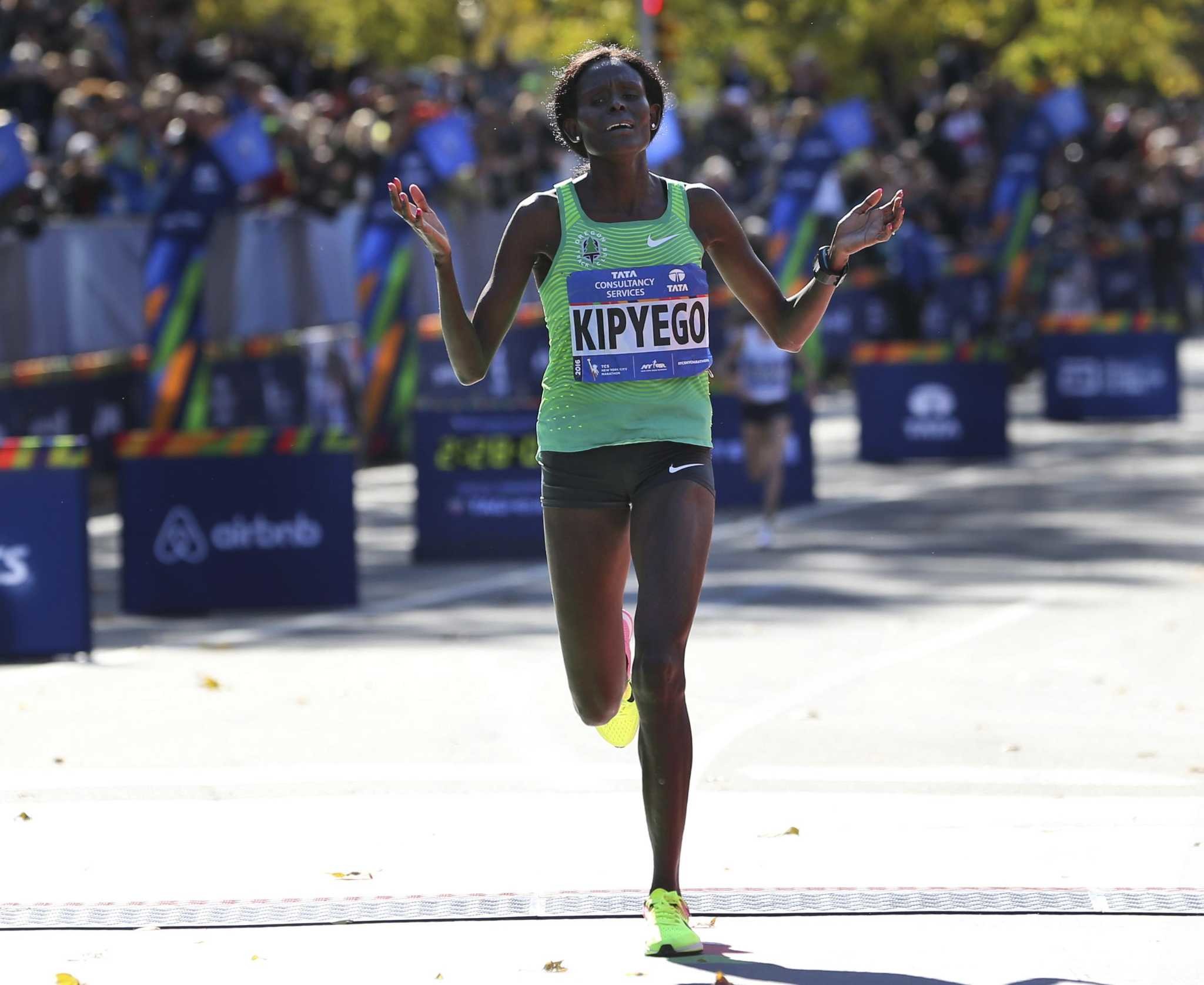
Who will represent the United States in marathon?
The United States staged its Olympic trials in February 2020, so the top American runners have had nearly one and a half years to prepare for the Sapporo course.
Galen Rupp, 35, was the top men’s qualifier, posting a first-place time of 2 hours 9 minutes 20 seconds at trials and earning a spot in his fourth Olympic Games. Rupp won silver in the men’s 10,000 meters at the 2012 Games before tackling the marathon four years later. He took bronze in the 2016 Olympic marathon with a time of 2:10:05, even though it was only the second time in his life that he tackled a 26.2-mile course.
He’ll be joined in Tokyo by fellow Americans Jake Riley and Abdi Abdirahman. Riley, 32, was 42 seconds behind Rupp at trials and was also the top American finisher at the 2019 Chicago Marathon. The Somali-born Abdirahman will be competing in his fifth Olympics and at 44 years old will be the oldest American runner to ever compete in a Summer Games.
Kenyan-born Aliphine Tuliamuk won the women’s marathon trials with a time of 2:27:23, and will be making her Olympic debut at age 32. Before the Tokyo Games were postponed due to covid-19, Tuliamuk had planned on starting a family immediately following the 2020 Olympics. The year-long delay changed her timeline and she gave birth to her daughter, Zoe, in January.
She’ll be joined at trials by Molly Seidel, who finished the trials just eight seconds behind Tuliamuk, and Sally Kipyego. The 27-year old Seidel will be making her Olympic debut. She was also the second American woman finisher at the 2020 London Marathon.
Kipyego, 35, is a decorated long-distance runner who will be competing in her second Olympics. Running for her native Kenya in 2012, she took silver in the 10,000-meter race.
(07/20/2021) ⚡AMPby Rick Maese
Tokyo 2020 Olympic Games
Fifty-six years after having organized the Olympic Games, the Japanese capital will be hosting a Summer edition for the second time, originally scheduled from July 24 to August 9, 2020, the games were postponed due to coronavirus outbreak, the postponed Tokyo Olympics will be held from July 23 to August 8 in 2021, according to the International Olympic Committee decision. ...
more...Long-distance running legend Paula Radcliffe was devastated when her daughter was diagnosed with a rare tumor last year
Paula Radcliffe experienced the full range of highs and lows during her glittering running career. From smashing world records on the streets of the capital, winning the London Marathon three times, to sitting forlornly on the roadside in Athens with her Olympic dream in tatters, she tasted it all.
But nothing could have prepared her for the moment last year when a doctor broke the news that Isla, her 14-year-old daughter, had a tumor growing on one of her ovaries.

“After Isla had undergone a battery of hospital tests, I hoped it would still be something benign even though we had been sent to the oncology department,” recalls Paula.
“But I was given the diagnosis that nobody wants to hear when the doctor said Isla had cancer. The doctor had asked Isla to sit in the waiting room before telling me what it was.

“I burst into tears but had to stop crying and pull myself together before Isla came back into the room a few minutes later. The doctor then explained the diagnosis to Isla.”
It was a shattering blow for Paula, 47, and husband and former coach Gary Lough, who live with Isla and their 10-year-old son Raphael, in Monaco.
Small signs that something might be amiss with Isla’s health had begun a few months earlier.
“In March last year Isla started her period, which was a little more painful than I remember, but we didn’t really think anything of it,” says Paula.
“But by July Isla said she was getting out of breath when having underwater swimming races with Raph in the pool.
“She also didn’t want to go on their trampoline as it gave her a pain in her bladder. After the diagnosis we realized this was because the tumor was bouncing on it.”
By late August, Isla was suffering unexplained bleeding between periods. Paula knew something was wrong so made an appointment with a paediatrician. The next day, at a hospital in nearby Nice, Isla underwent an ultrasound scan and other tests. When the results came in the family were devastated.
Isla had a malignant germ cell tumor, which grows in the cells that form the eggs in the ovary. They are rare and affect roughly one in 200,000 women. In men they can develop in the testicle where the sperm is formed.
“It was hard to take in as everything had happened so fast,” says Paula.
“But the care was phenomenal. A week later, Isla was starting chemo.”
For Isla, having a clear diagnosis was helpful. “A lot of the time leading up to the diagnosis I didn’t feel right, but I didn’t expect it to be cancer,” says Isla. “I thought it would be something like an allergy or an intolerance.
“I didn’t take it in that we were going to a cancer department, and only realized that afterwards. When I went back into the doctor’s room after being examined, mum was crying – although she had been crying a lot the day before that. Then the doctor started to explain it was cancer and I think I was just in a state of shock.”
Because of ongoing Covid restrictions, it was decided Paula would be mostly with Isla at the hospital while Gary took care of Raphael.
“We made a decision which was best for our family,” explains Paula. “I probably cope better with stress and I don’t think he could have seen his little girl going through all this in hospital on a daily basis. But he could still come in every day and cheer her up.”
When Gary visited, Paula would either spend time with Raphael or go for a short run, which she still does most days. “When we were over the initial shock and the medical team had explained everything, having that sporting background helped,” says Paula. “We had a treatment plan – like all the training plans I have followed over the years, and it was something we could stick to and see things improving.”
The prognosis was good with a high chance of it being successfully cured with surgery, and in Isla’s case, chemotherapy too, which started in September, just as she was starting a new school term. The drugs were delivered intravenously five days in a row, taking seven hours each time.
(07/20/2021) ⚡AMPby Adrian Monti
Jamaican Usain Bolt slams unfair, laughable advances in spike technology
Usain Bolt has said advances in spike technology that could help wipe out his world records are laughable and that the new shoes also give an unfair advantage over any athletes not wearing them.
After athletes ripped through the record books in distance running with carbon-plated, thick-soled shoes, the technology has now moved into sprint spikes, where -- although there is less time in a race for the advantage to make an impact -- it is still enough to make a difference.
"When I was told about it I couldn't believe that this is what we have gone to, you know what I mean, that we are really adjusting the spikes to a level where it's now giving athletes an advantage to run even faster," Bolt told Reuters in an interview from Kingston.
The 100m and 200m world record holder competed in Puma spikes throughout his career.
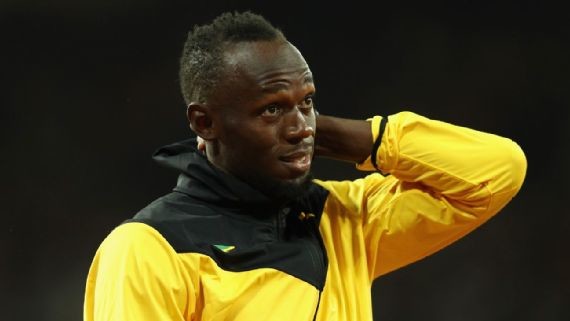
"It's weird and unfair for a lot of athletes because I know that in the past they [shoe companies] actually tried and the governing body said 'No, you can't change the spikes,' so to know that now they are actually doing it, it's laughable," the eight-time Olympic Champion added.
American Trayvon Bromell is favourite to take Bolt's 100m title in Tokyo. He is the fastest in the world over the distance this year with 9.77 secs, but the 2015 world 100m bronze medallist is less convinced about the impact of the shoes.
"I don't think there's a lot of data to show that they're having such a big improvement," Bromell, who runs for New Balance, told reporters last week.
"I know we [New Balance] are constantly building onto what we have to make the perfect spike, but for me personally as a runner I still feel like it's not enough data to really show."
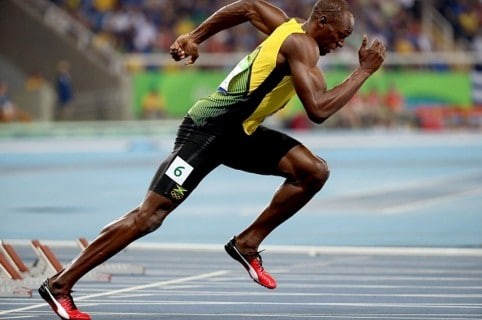
While other companies now have similar shoe models, Nike looks set to dominate and is priding itself on being a leader in the technology.
"We're just smarter about how we engineer and assemble them," Nike said in an email to Reuters.
The company added that it works to keep its athletes on the cutting edge while staying within the rules.
Weighing in on developments in shoe technology, World Athletics said: "The current regulations [July 2020] were designed to give certainty to athletes preparing for the postponed Tokyo 2020 Olympic Games, to preserve the integrity of elite competition and to limit technological development to the current level until after the Olympic Games in Tokyo, across all events."
It said a working group on shoes aimed to set parameters to achieve a balance between innovation, competitive advantage and availability of the products.
Performing in the Nike Air Zoom Maxfly, Jamaican two-time Olympic gold medallist Shelly-Ann Fraser-Pryce clocked the fastest 100m time in 33 years on June 5 in Kingston with a career-best 10.63 seconds.
Only American world record holder Florence Griffith-Joyner has gone faster, with 10.49 seconds in Indianapolis in 1988.
But Fraser-Pryce was unwilling to discount the work she has done to become the fastest woman alive, even as she trains and competes in the spike.
"You can give the spikes to somebody else and they'll probably not do the same things that I've done, so I'm not counting myself out of the hard work me and my coach has put in," the four-time 100m world champion told Reuters.
"Maybe the combination of both -- having good products and good runners combined -- makes for a very good end-product. So for me, I can't single-handedly point to the spikes."
Veteran Jamaican sprint coach Stephen Francis admitted that faster times are being run in Nike's new sprint spikes.
"Based on anecdotal evidence and based on the fact that you have people who never would have run as fast as they are running, I suspect that there may be a point, but there is no scientific basis to make that point," Francis told Reuters from Kingston.
Whatever the advantage, he said, anyone can benefit from Nike's technology based on the rules set by World Athletics.
(07/20/2021) ⚡AMPby Reuters
New Zealand has confirmed a record 211-strong team for Tokyo 2020
The New Zealand Olympic Committee (NZOC) has confirmed a record 211 athletes will represent the nation at delayed Olympic Games here in the Japanese capital.
The team is New Zealand’s largest at the Games, surpassing the 199-athlete delegation that travelled to Rio 2016.
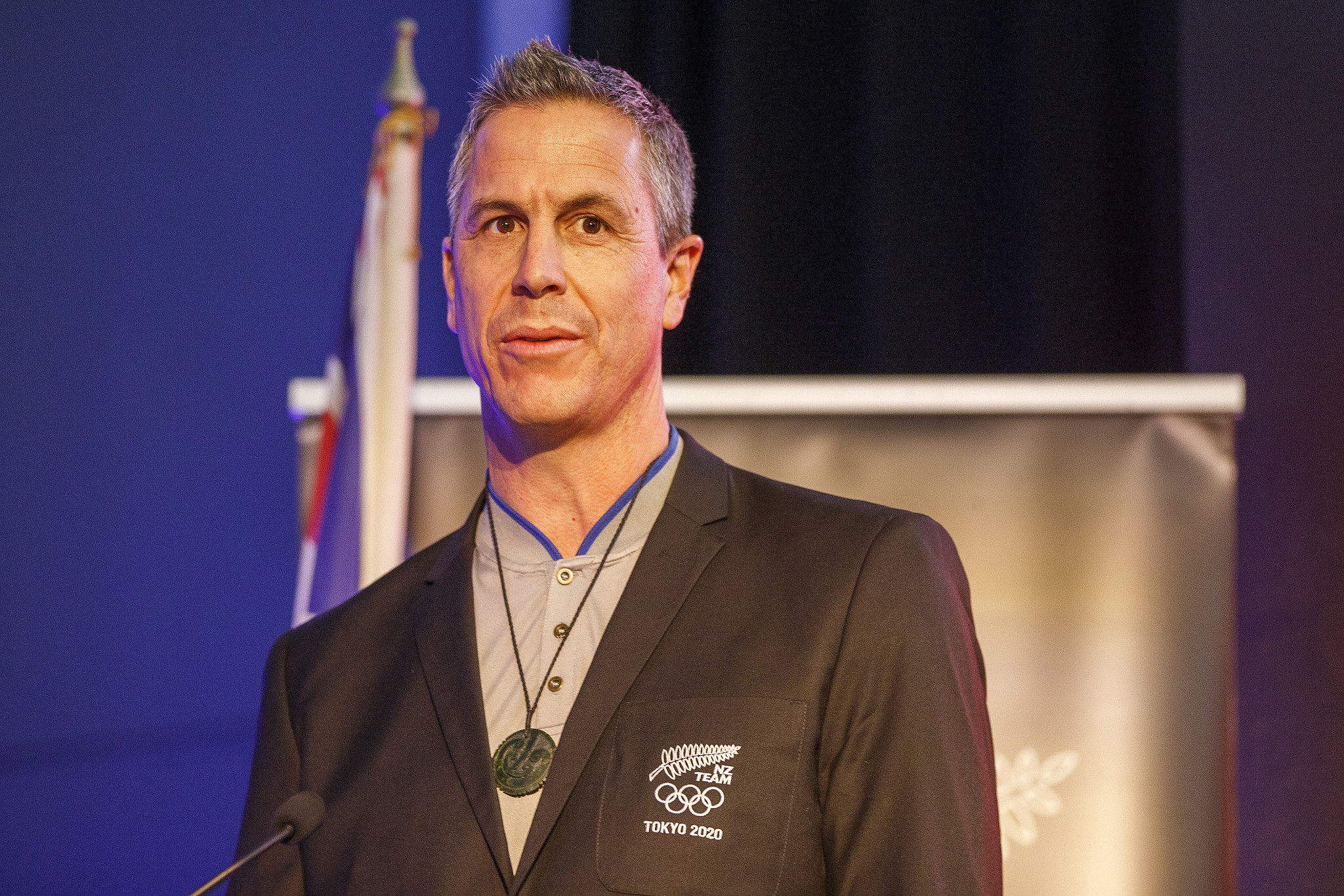
The NZOC revealed that the team includes 110 men and 101 women, with the country having representatives in 22 sports at the Games.
This includes the sports of karate and surfing, due to make their Olympic debuts at Tokyo 2020.
A total of 33 athletes are of MÄori descent.
Most of the New Zealand team will be competing at their first Olympics with 118 having previously never participated at the Games.
The remaining 93 have already been to one or more Games, including two-time Olympic shot put gold medallist Dame Valerie Adams.
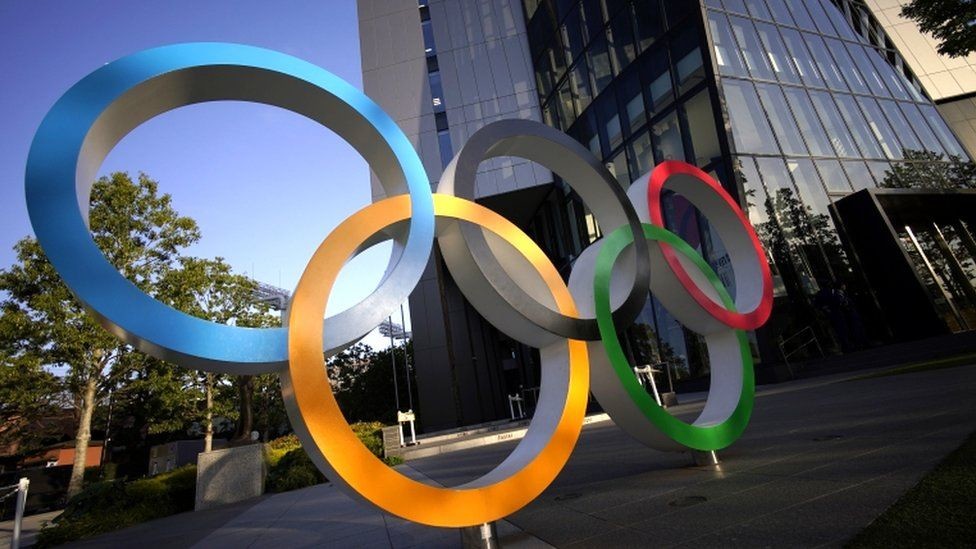
Dame Valerie is set to become the second female athlete to represent New Zealand at five Olympic Games, matching windsurfer Barbara Kendall.
Nick Willis, winner of the Beijing 2008 Olympic silver and Rio 2016 bronze in the men’s 1500 metres, will also compete at a fifth Olympic Games.
Swimmer Erika Fairweather is the youngest member of the team aged 17, with equestrian jumping athlete Bruce Goodin the oldest at 51.
Controversial weightlifter Laurel Hubbard features among the delegation and is set to be the first transgender athlete to compete at the Games as their associated gender.
Women’s rugby sevens captain Sarah Hirini and two-time Olympic rowing champion Hamish Bond were confirmed as New Zealand’s flagbearers Opening Ceremony earlier this month.
The Games is largely set to take place behind closed doors due to the COVID-19 pandemic, leading to the Japanese Government introducing tighter restrictions on the host city.
New Zealand’s Chef de Mission Rob Waddell praised the resilience of the Olympic team amid the uncertainty caused by the COVID-19 pandemic, which led to a one-year postponement of the Games last year.
"This Olympic build-up has been extremely challenging and unique," Waddell, an Olympic rowing gold medallist in the single sculls at Sydney 2000, said.
"I’d like to thank all 211 athletes for the grit and determination they’ve shown to make it to these postponed Games.
"We’re extremely proud of the team and the way they’ve handled all the uncertainty.
"It’s now time to focus on wearing the fern and representing New Zealand to the best of our abilities in Tokyo."
Waddell and an advance team arrived here last week.
The advance team are setting up New Zealand’s area in the Athletes’ Village prior to their arrival for competitions.
Participants are required to follow restrictions outlined in playbooks produced by Tokyo 2020 and the International Olympic Committee.
This includes quarantine periods and movements being restricted to activity plan for the first 14 days.
"We’re working really hard to create a strong performance environment in our section of the Village which allows the athletes to perform to their peak," Waddell said.
"We’re setting up our own high-performance gym, kitchen and health areas.
"We also have two shipping containers to offload which contain things like sporting equipment, hand sanitiser and cooling fans.
"We’ve been working really closely with our performance delivery partners High Performance Sport New Zealand to prepare our team for the heat.
"We've had athletes training in heat chambers and holding heat camps in hot and humid locations.
"We've also got specialist ice vests, slushy machines and heat protocols in place."
(07/19/2021) ⚡AMPby Michael Pavitt
Tokyo 2020 Olympic Games
Fifty-six years after having organized the Olympic Games, the Japanese capital will be hosting a Summer edition for the second time, originally scheduled from July 24 to August 9, 2020, the games were postponed due to coronavirus outbreak, the postponed Tokyo Olympics will be held from July 23 to August 8 in 2021, according to the International Olympic Committee decision. ...
more...

